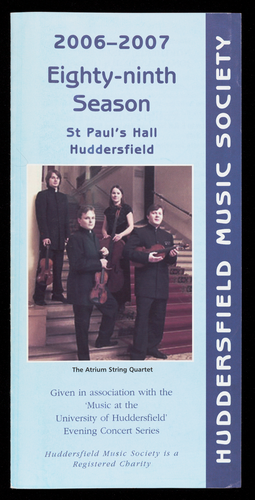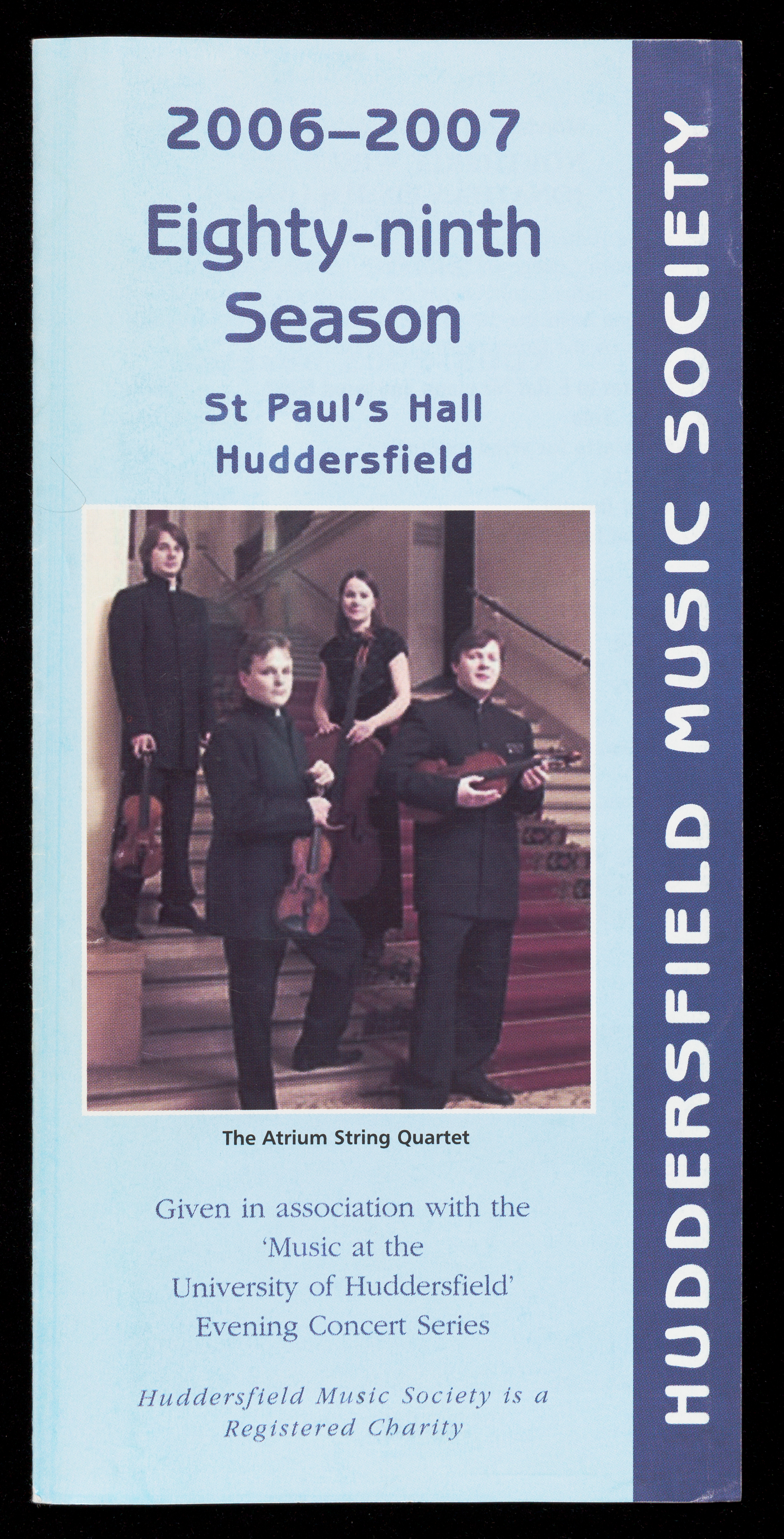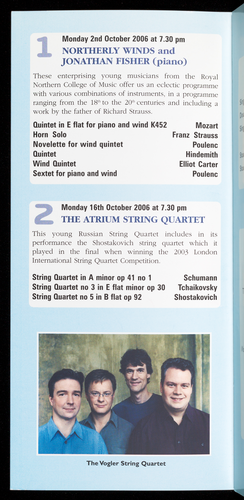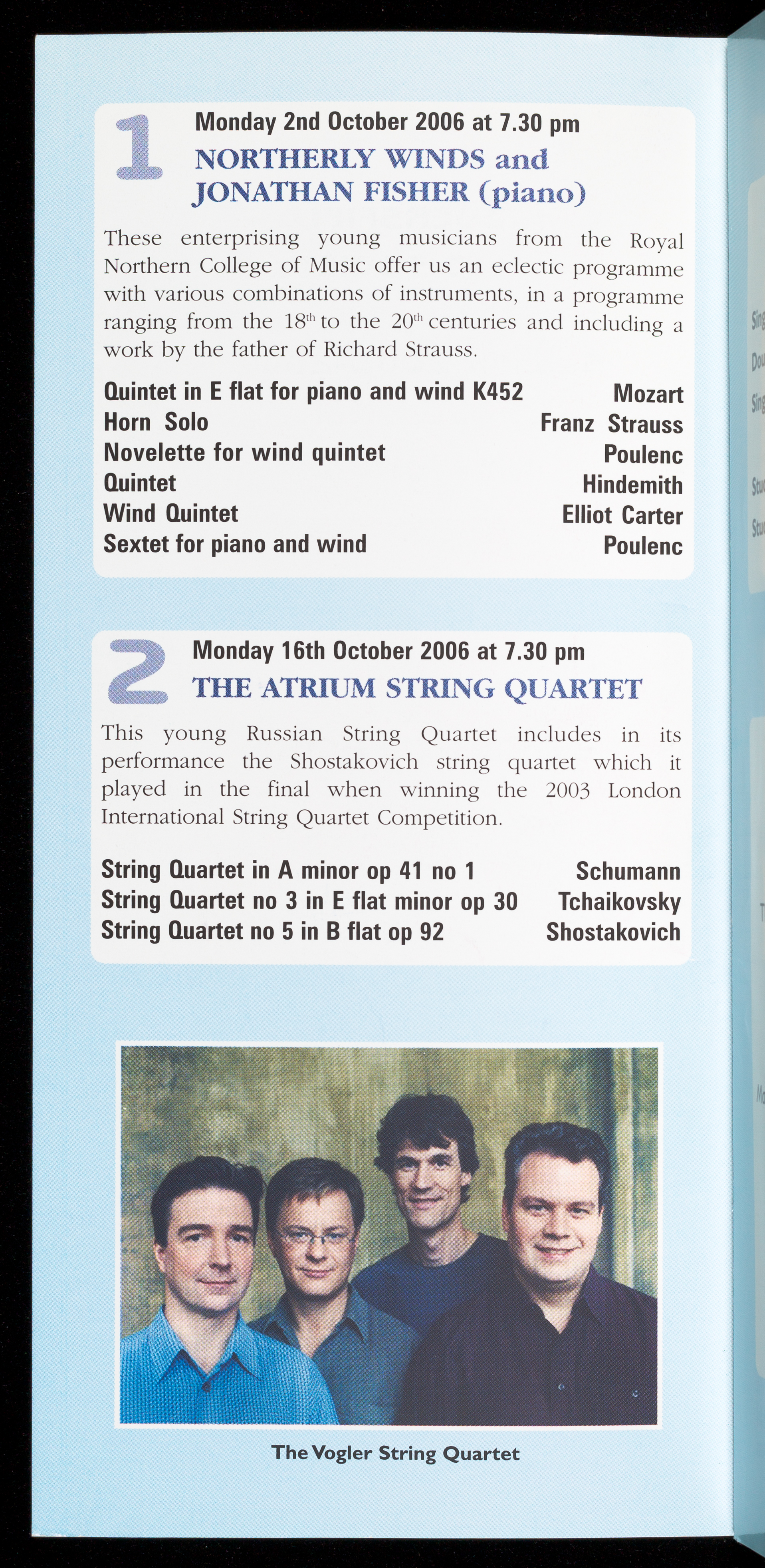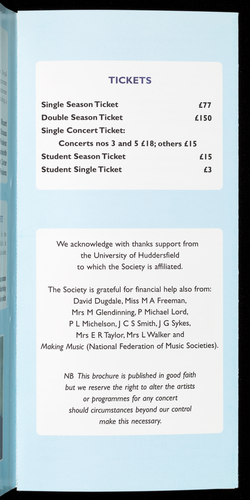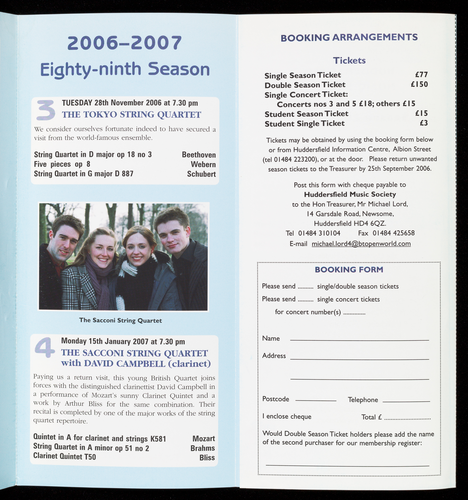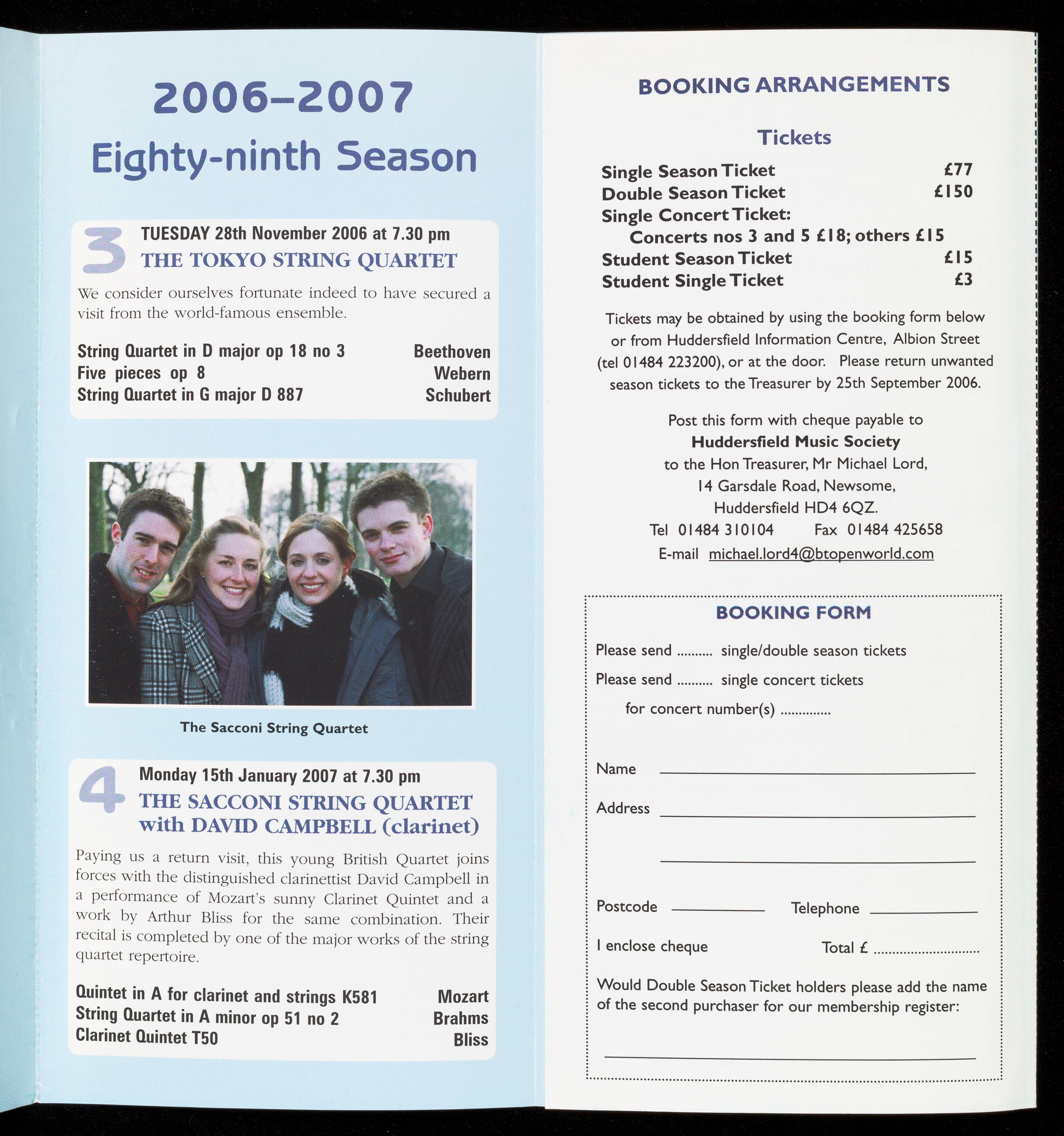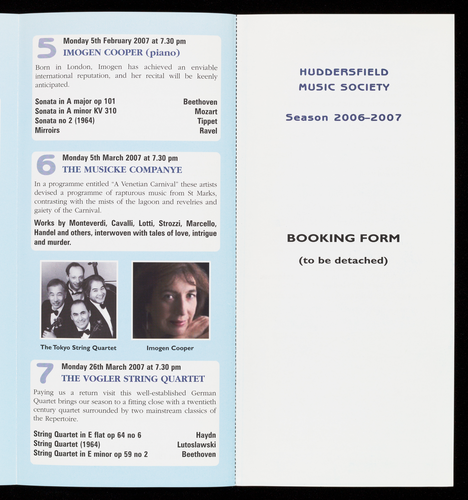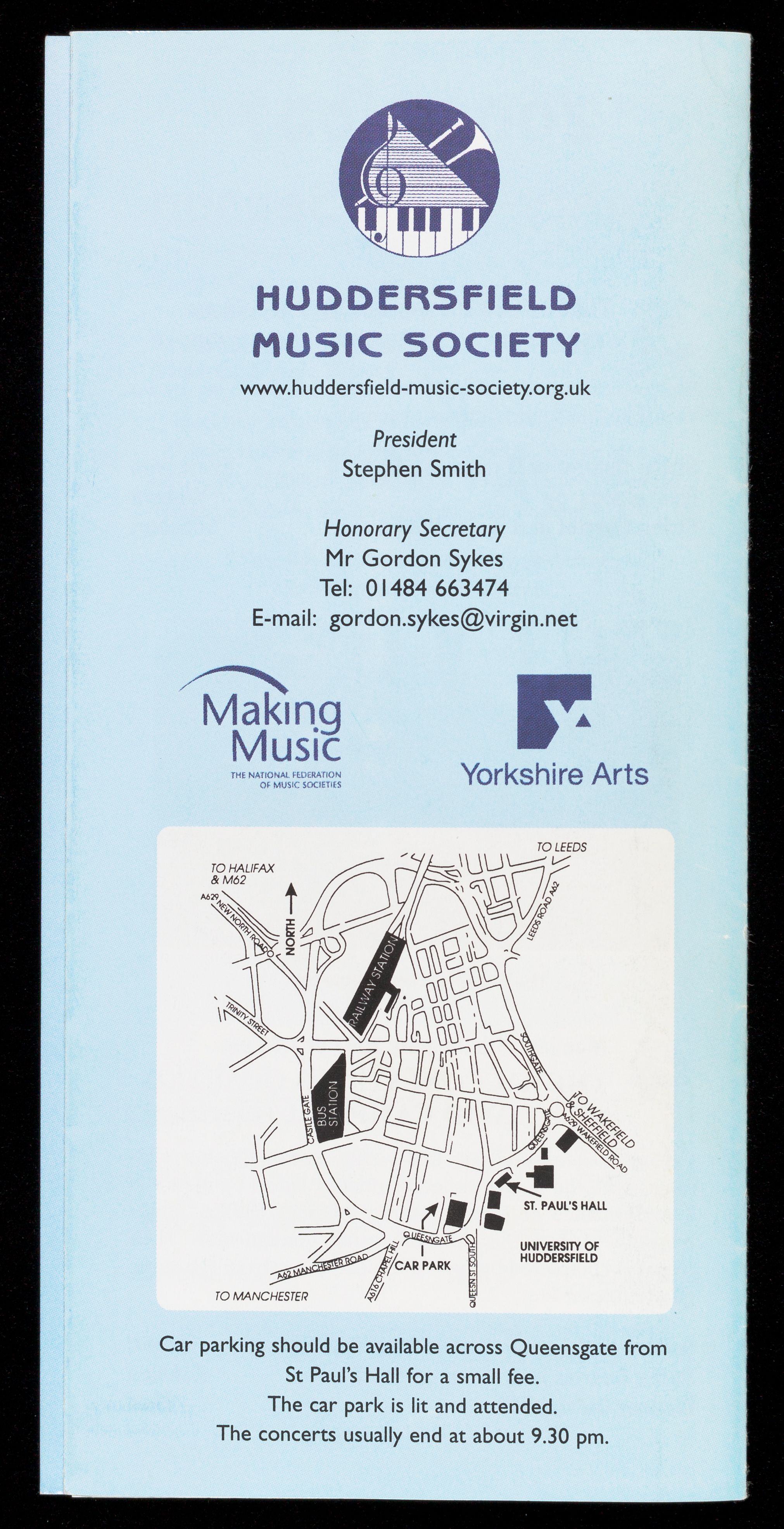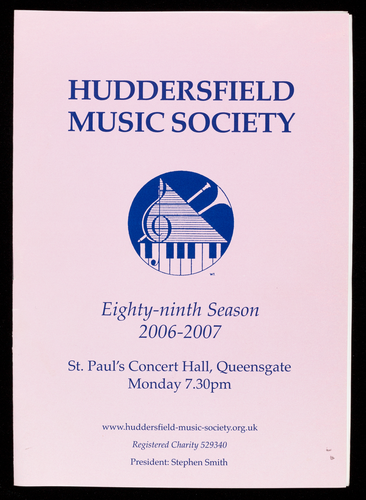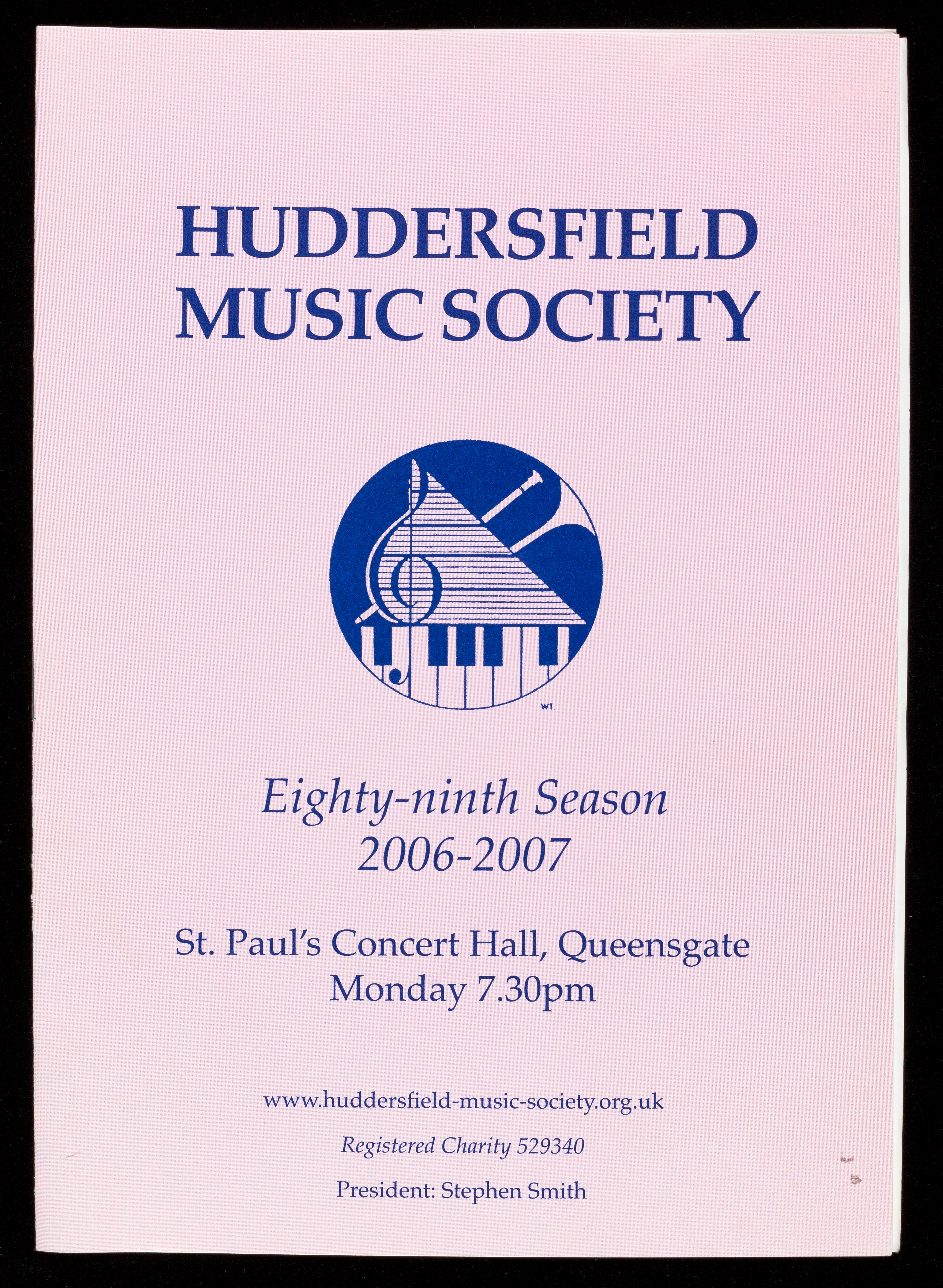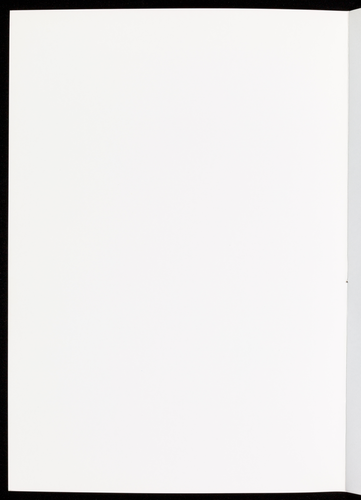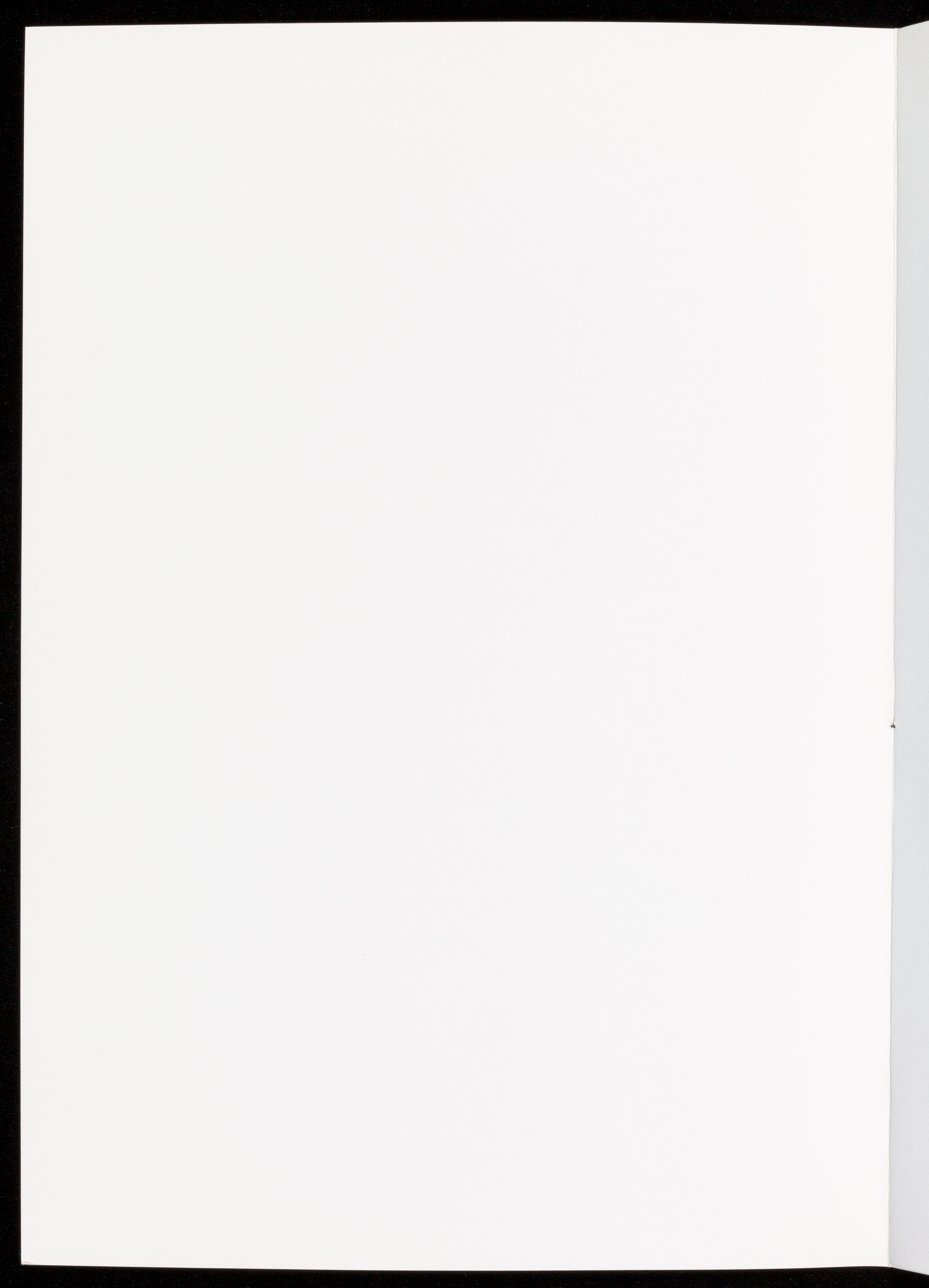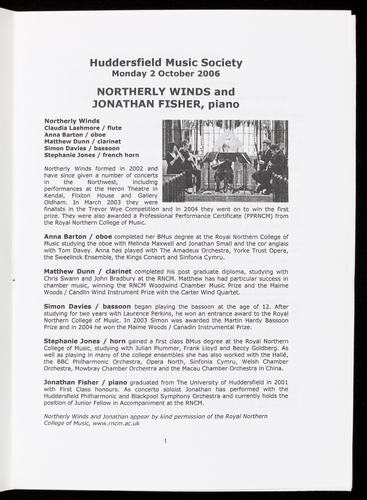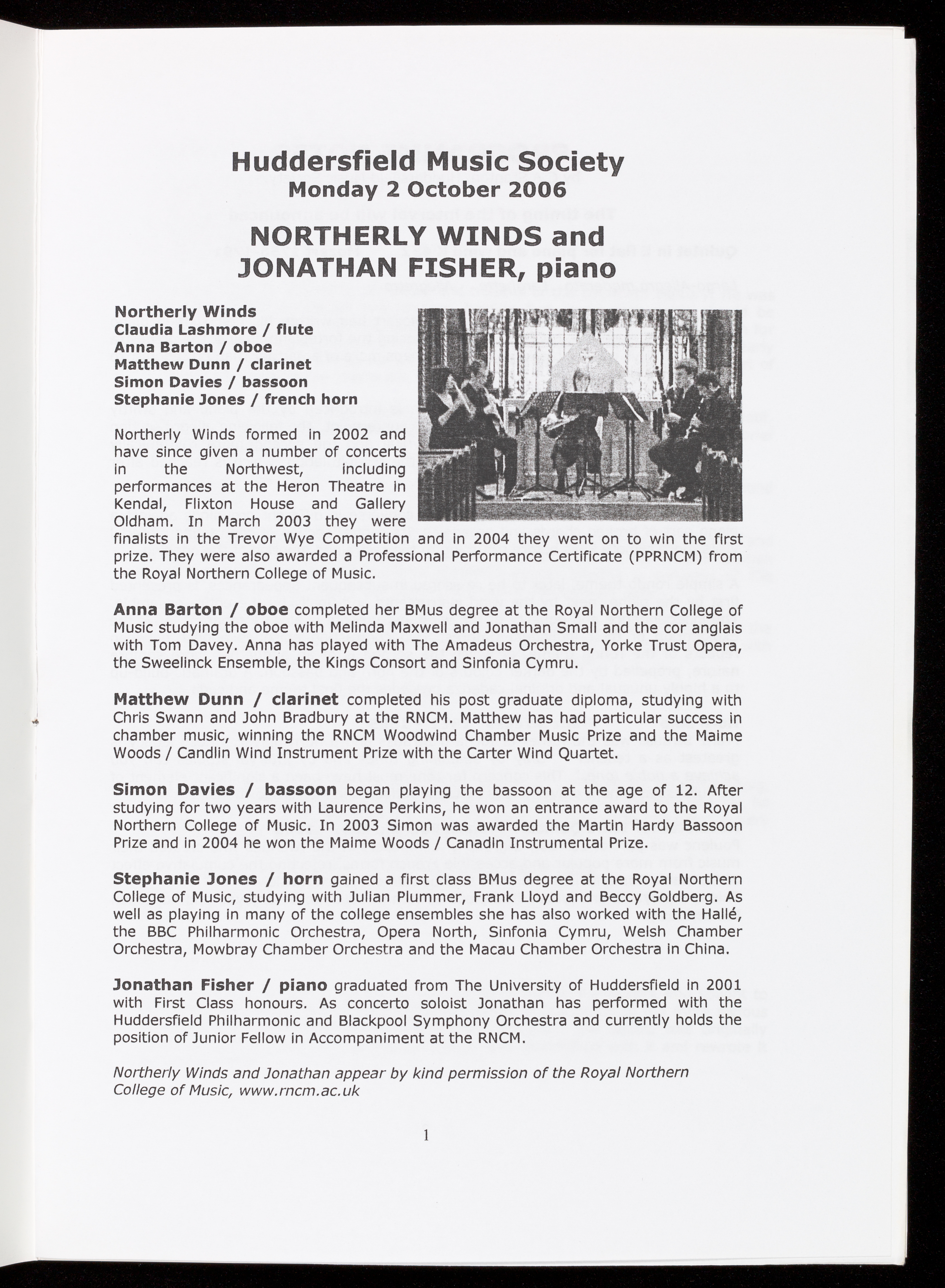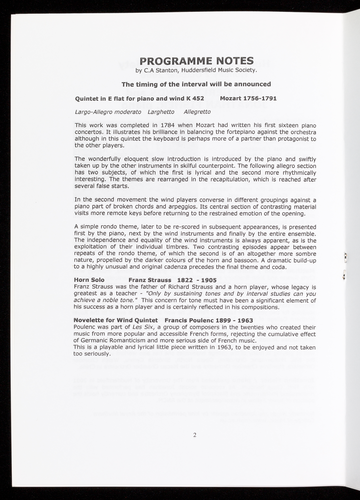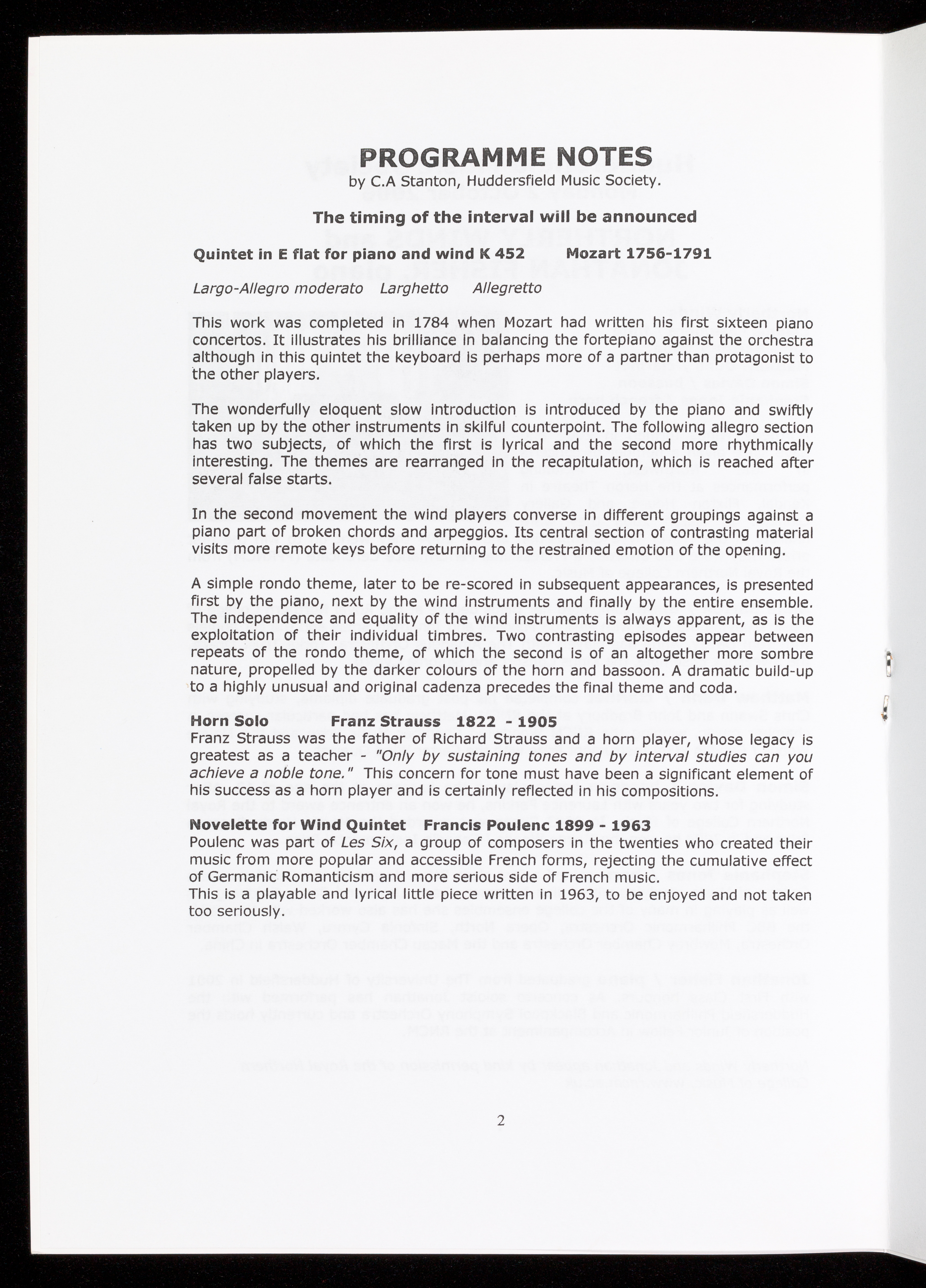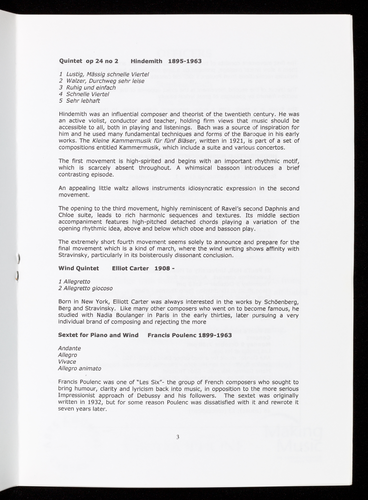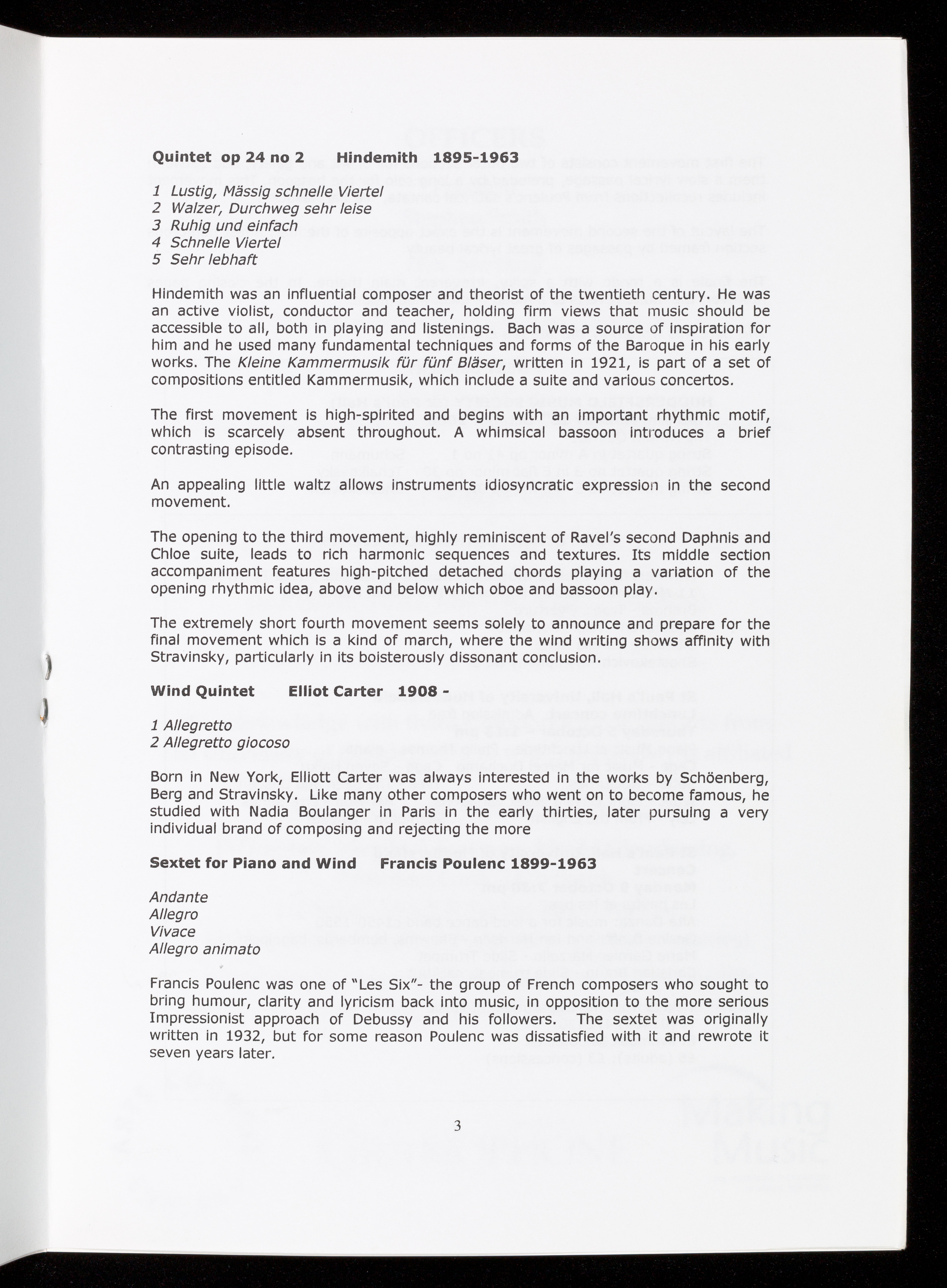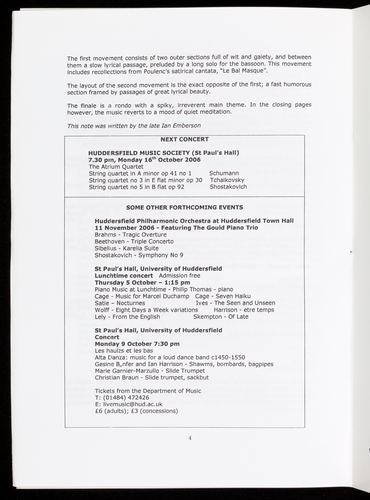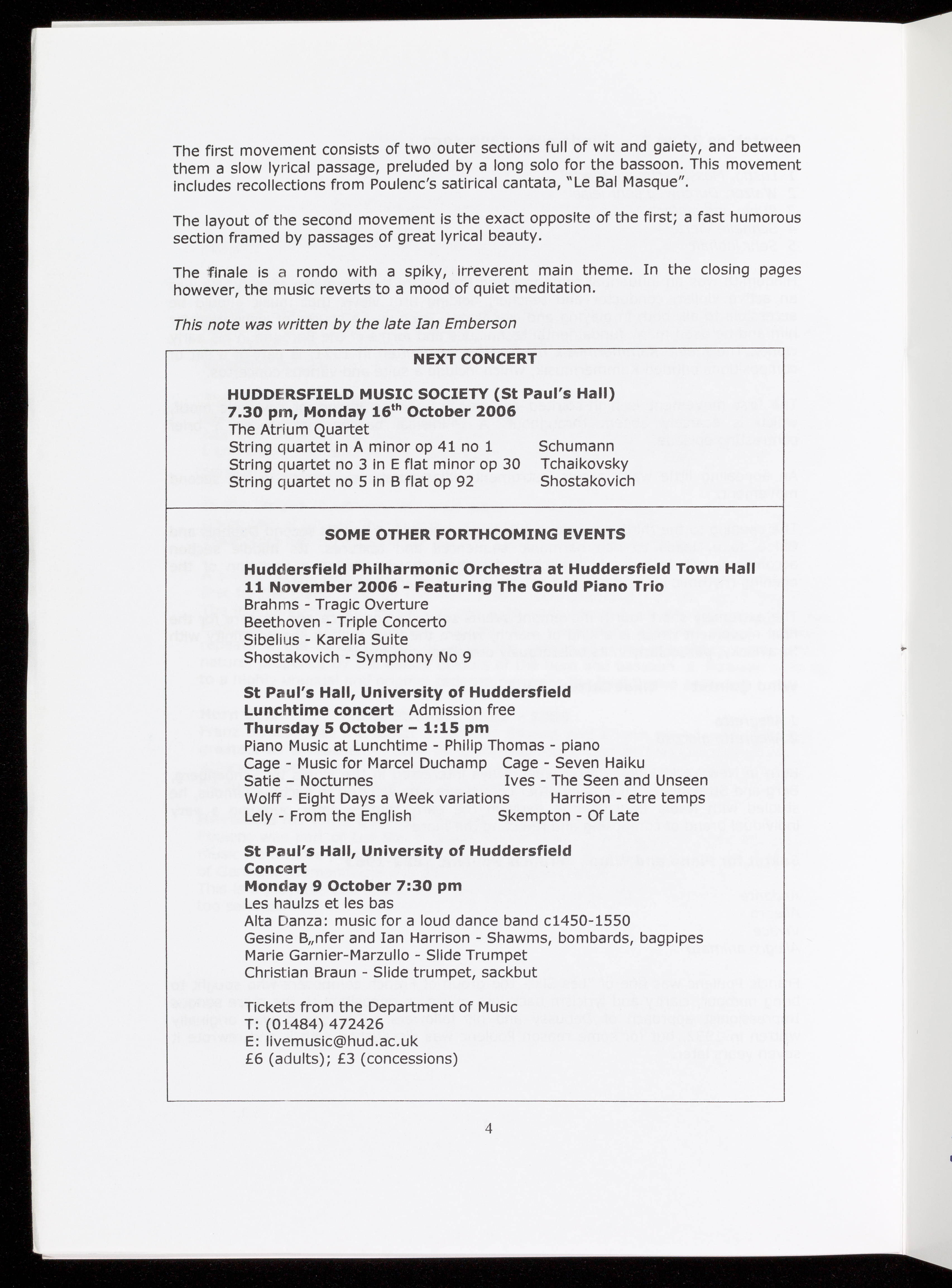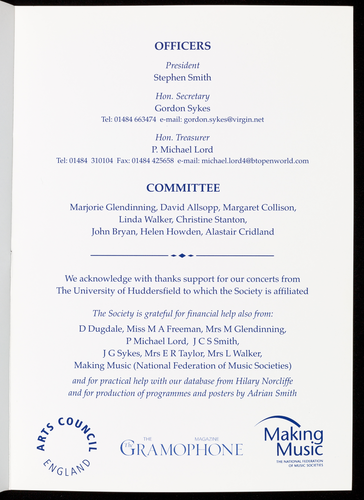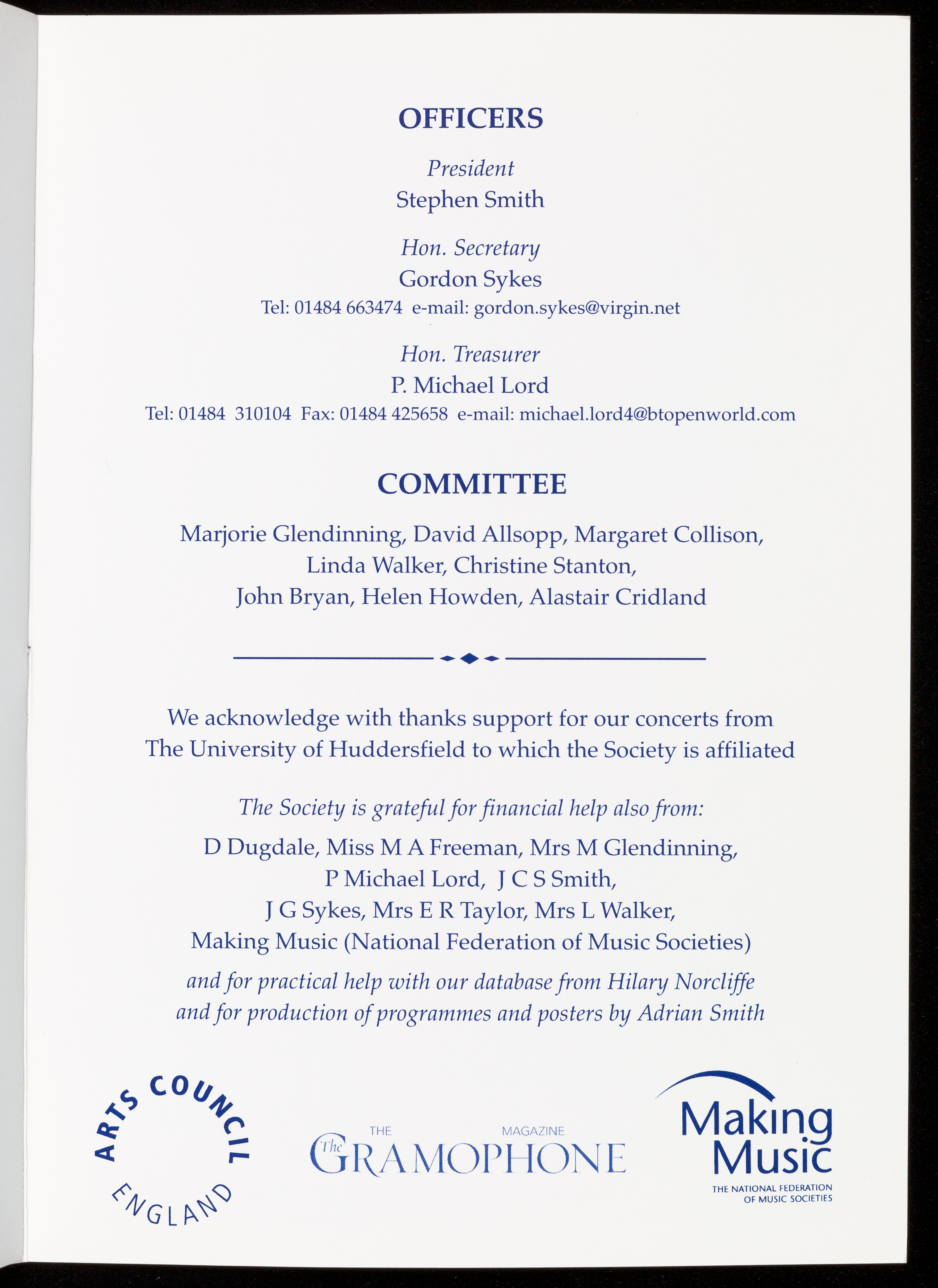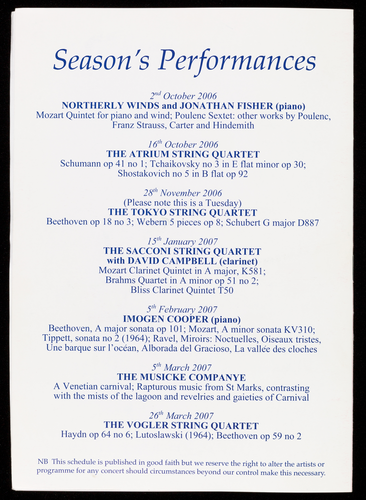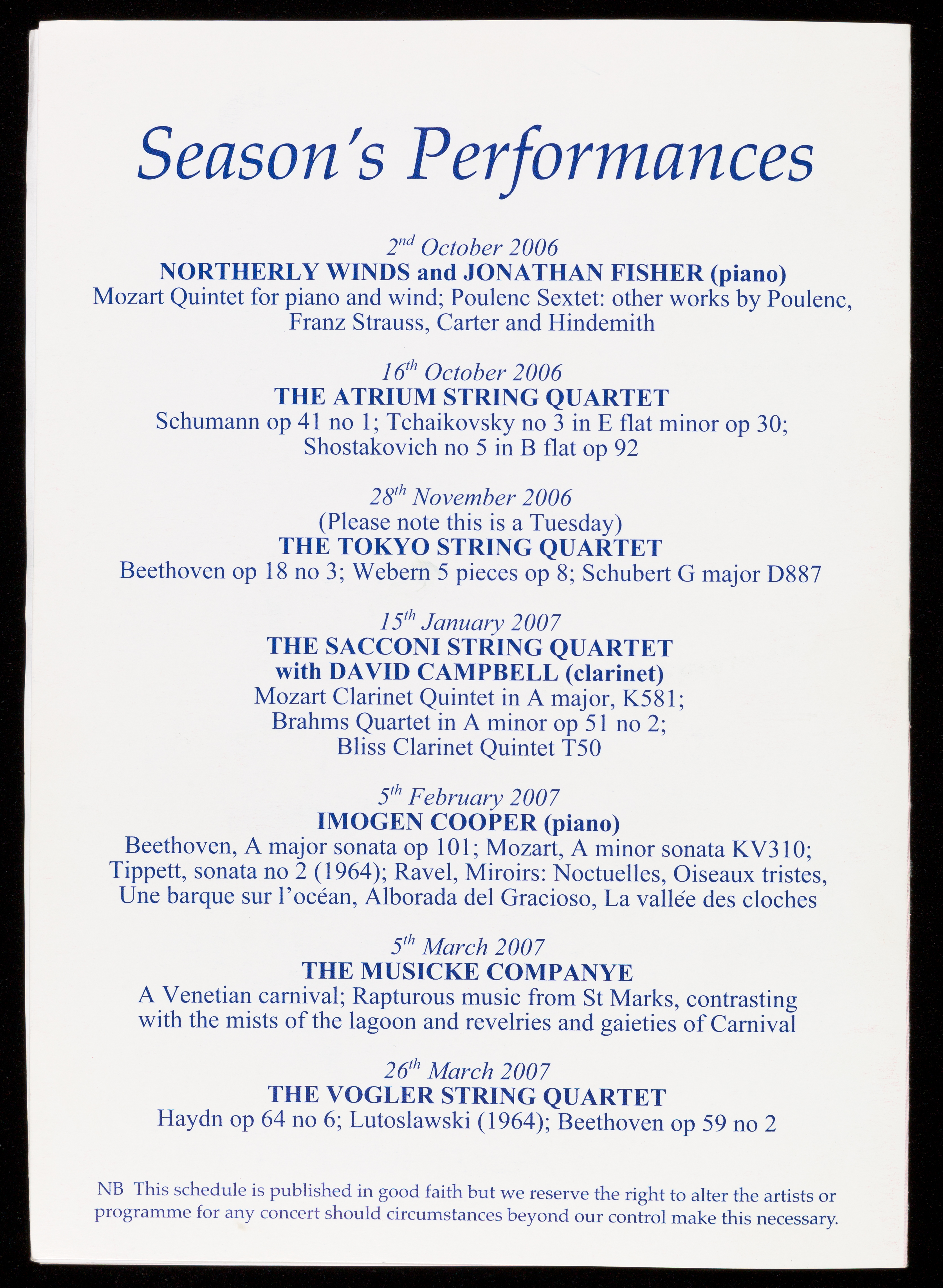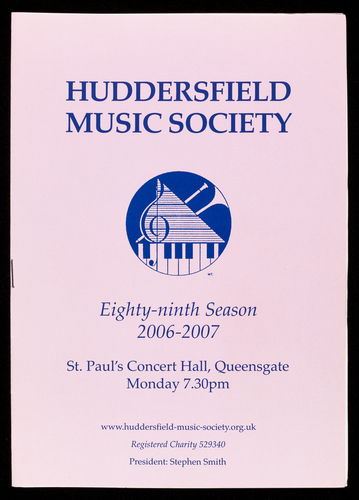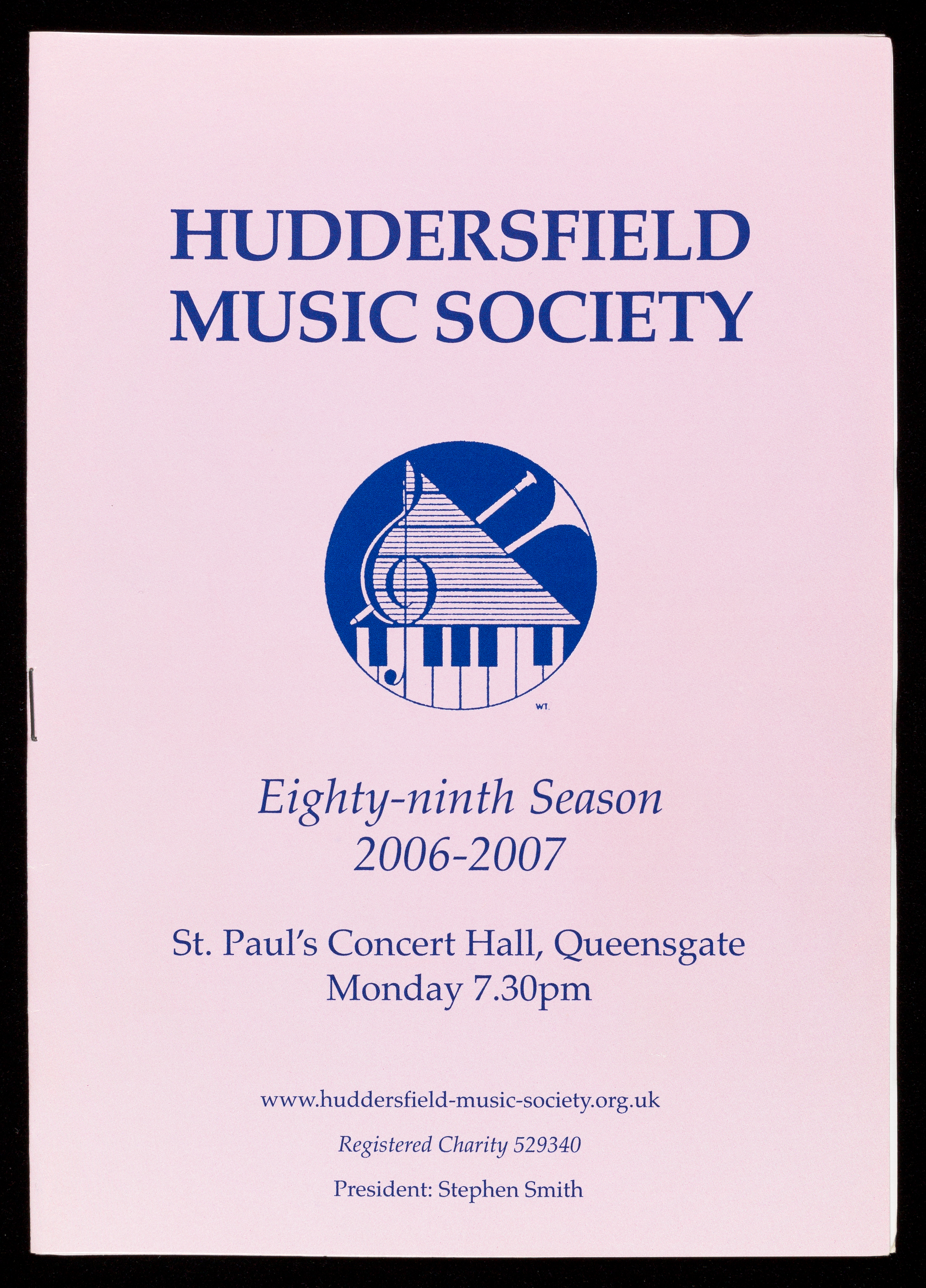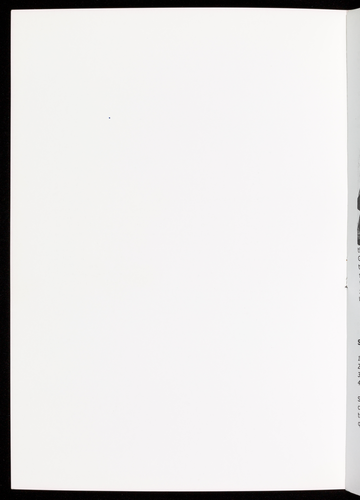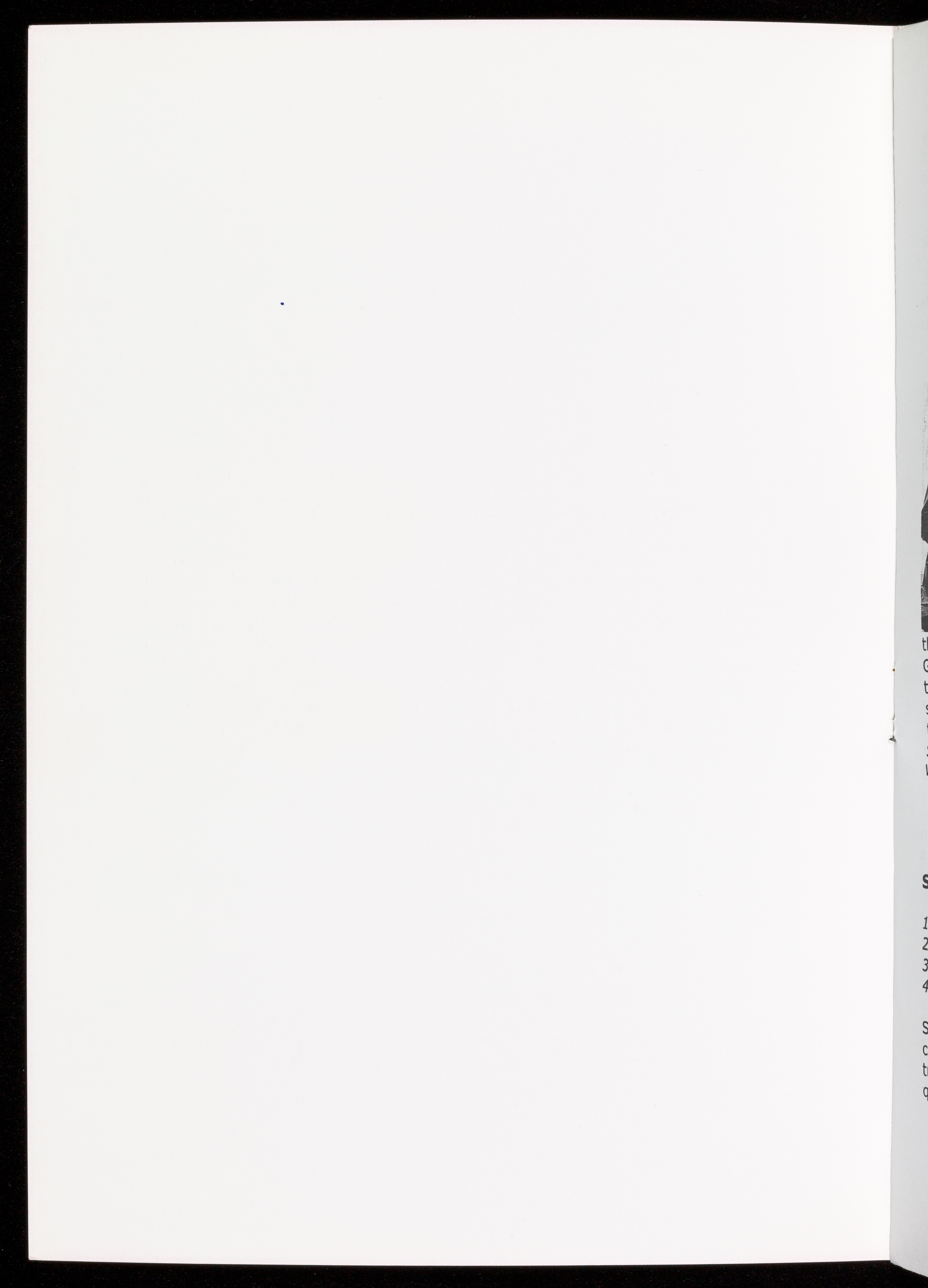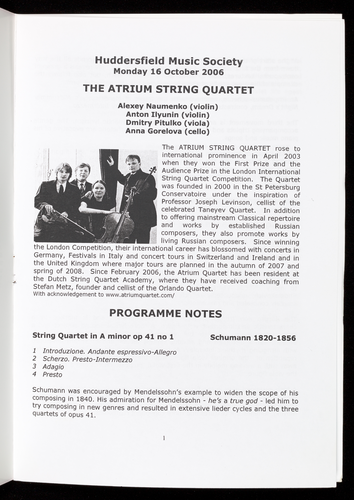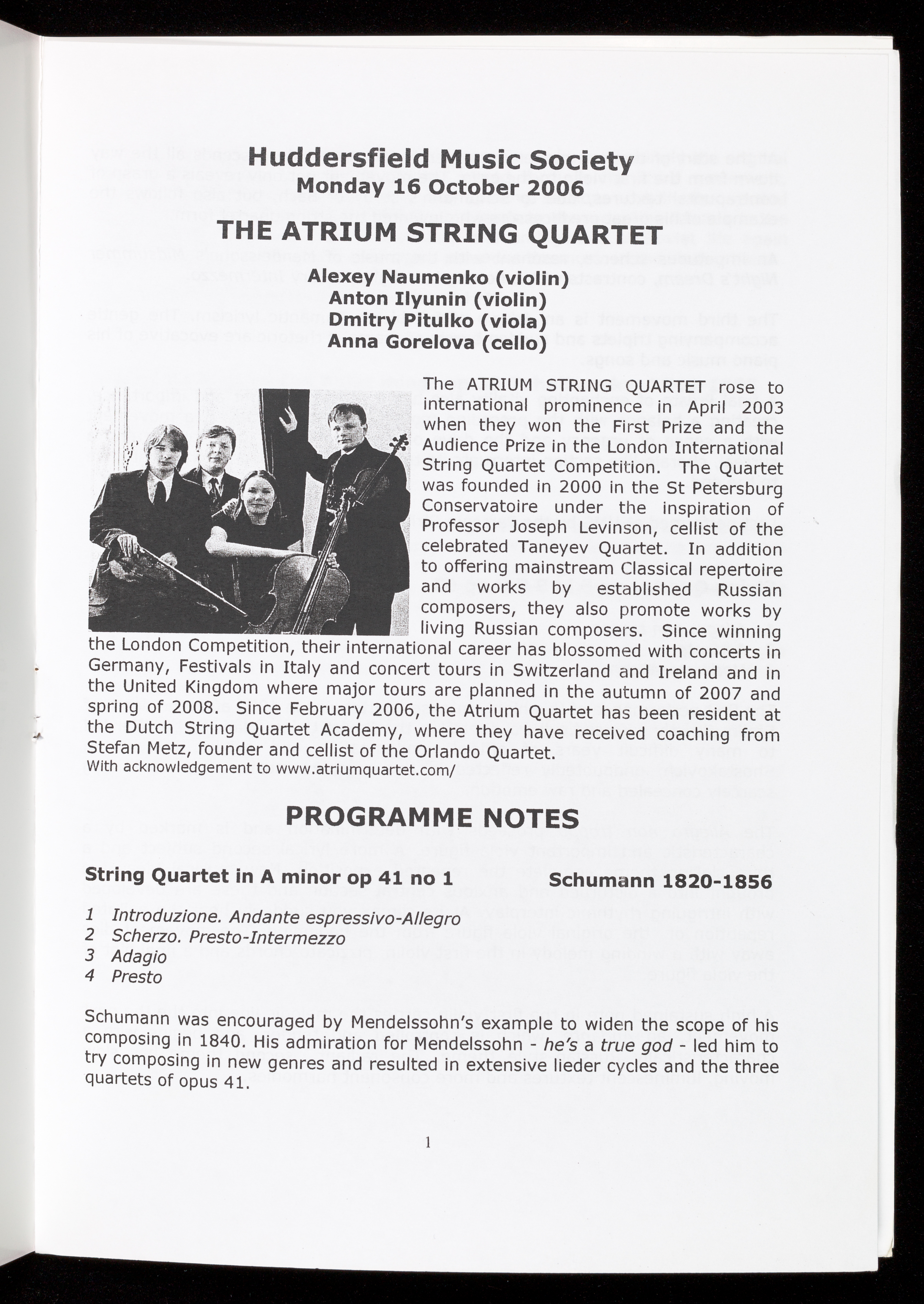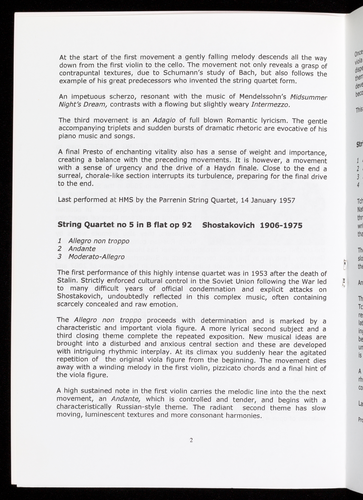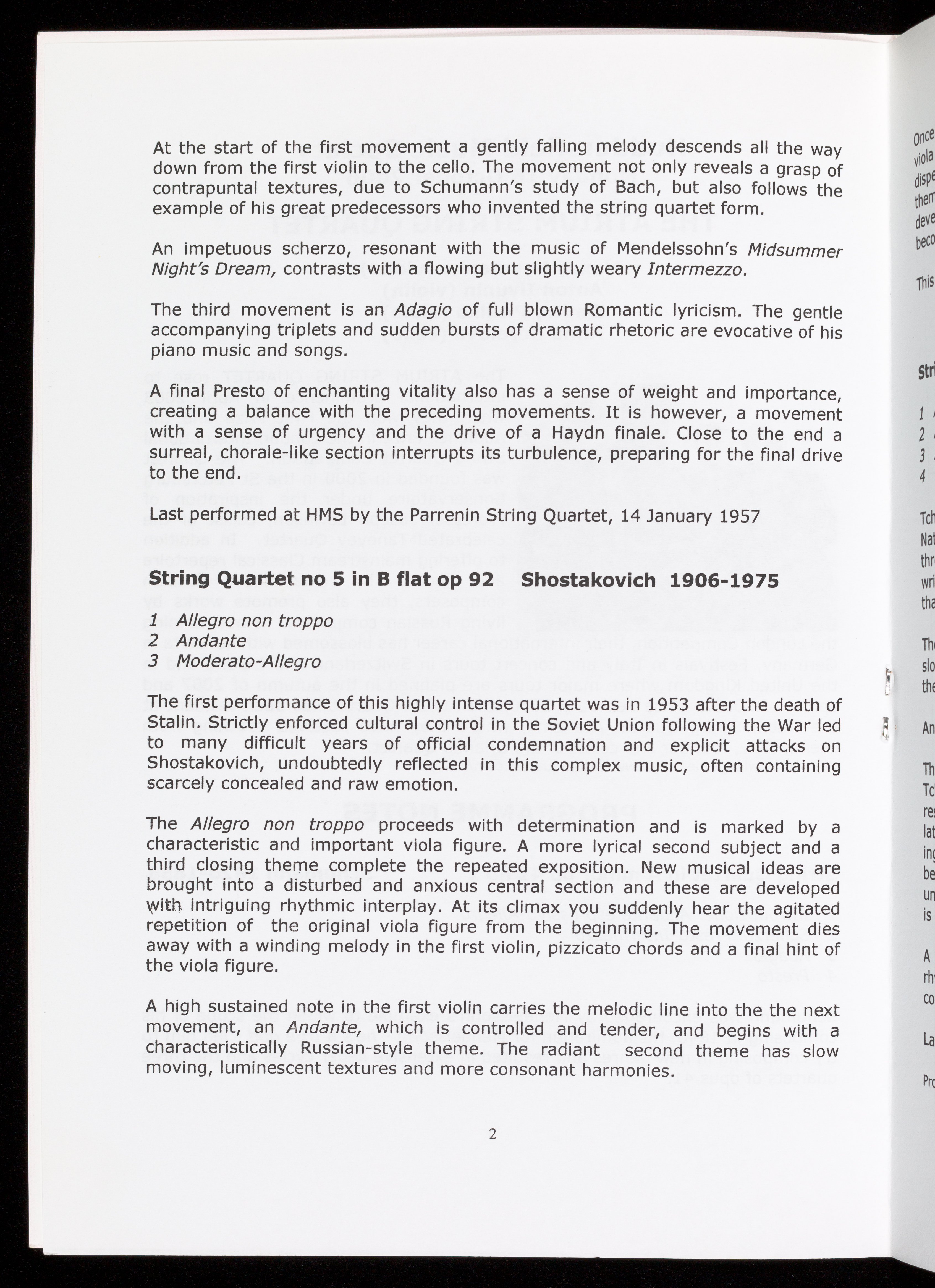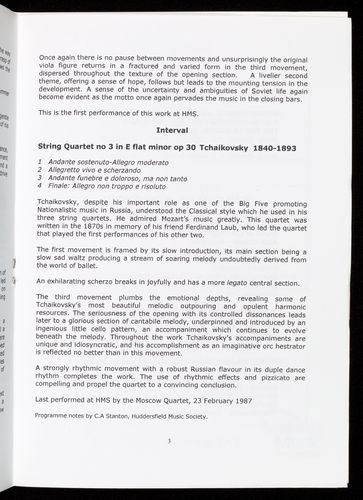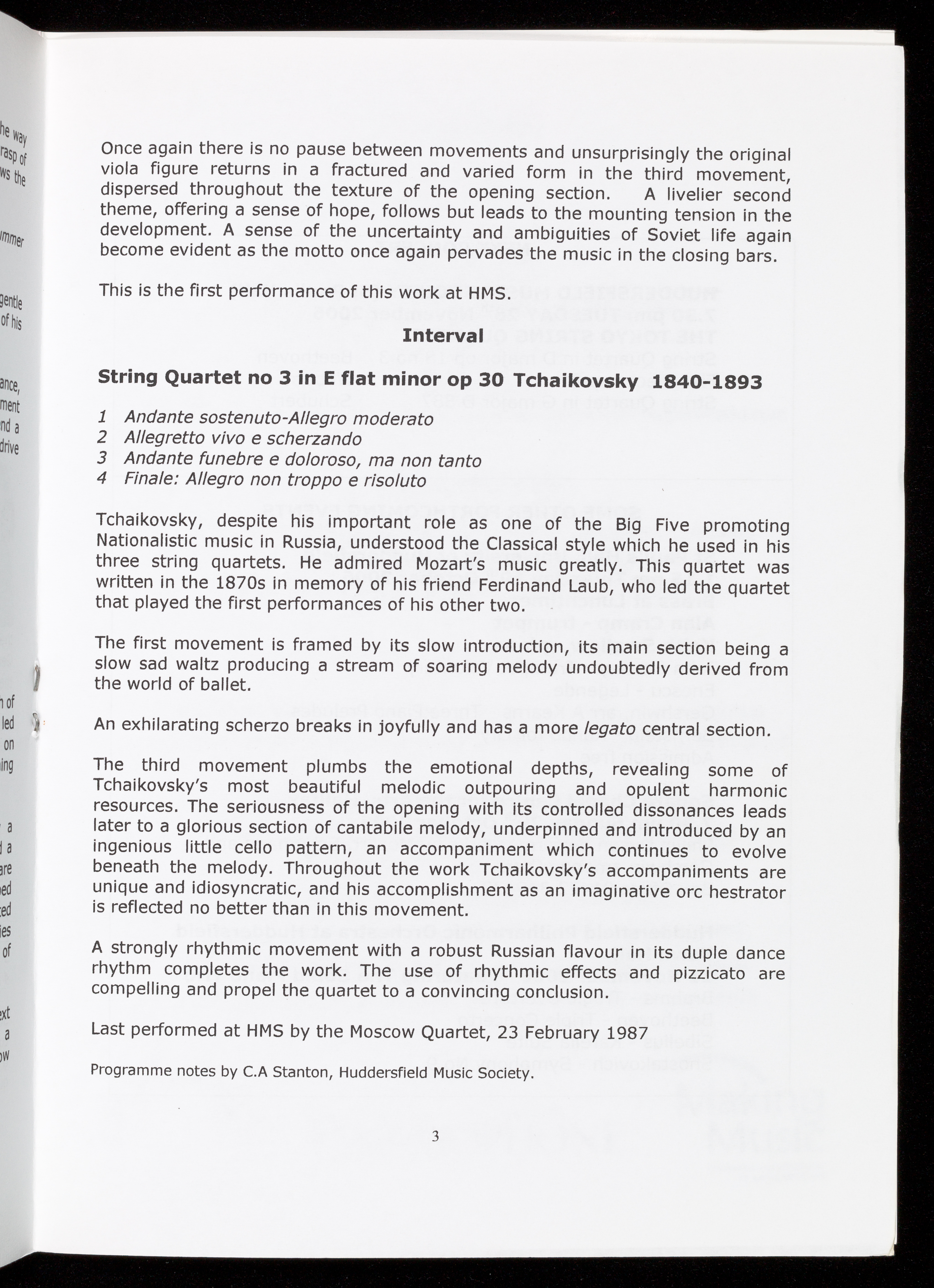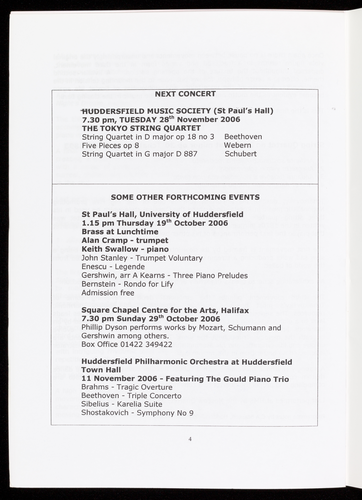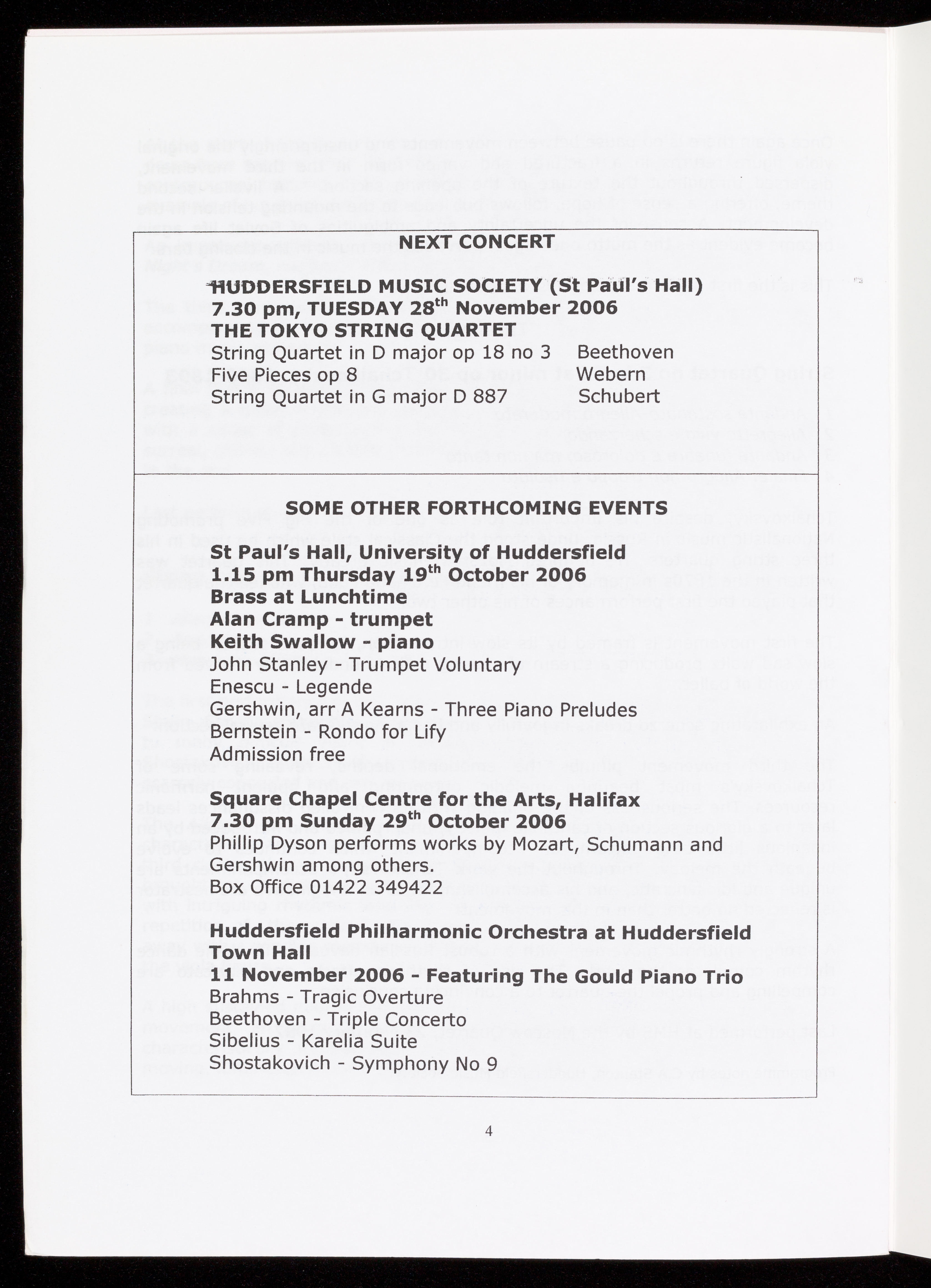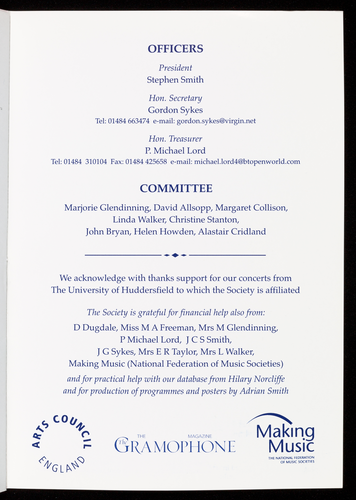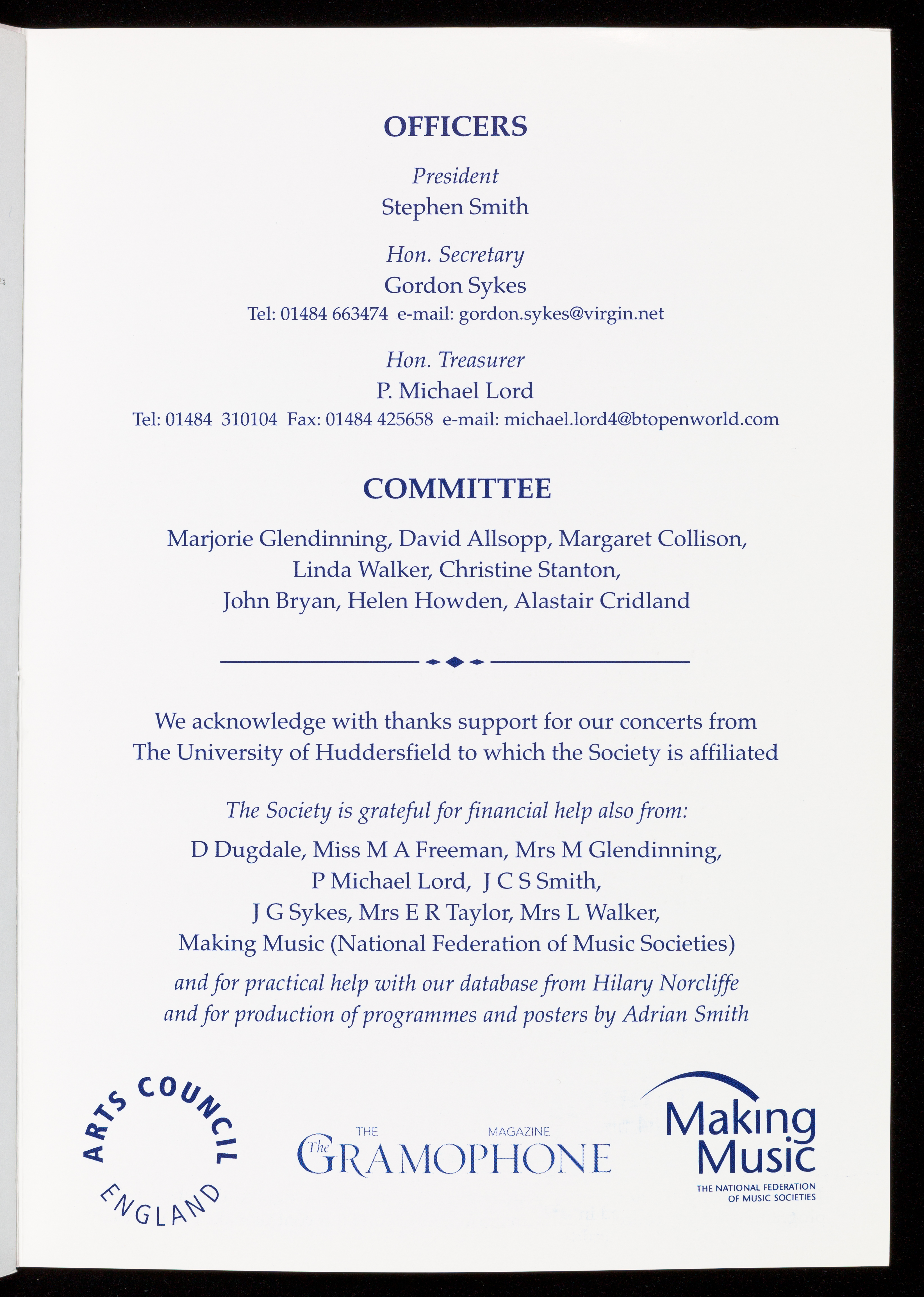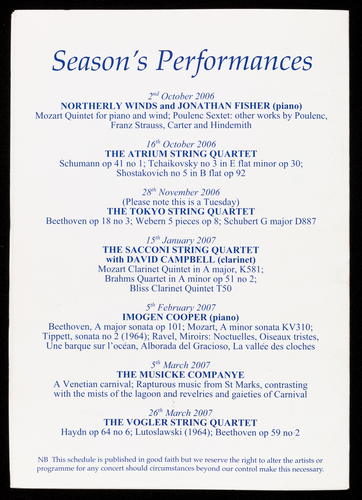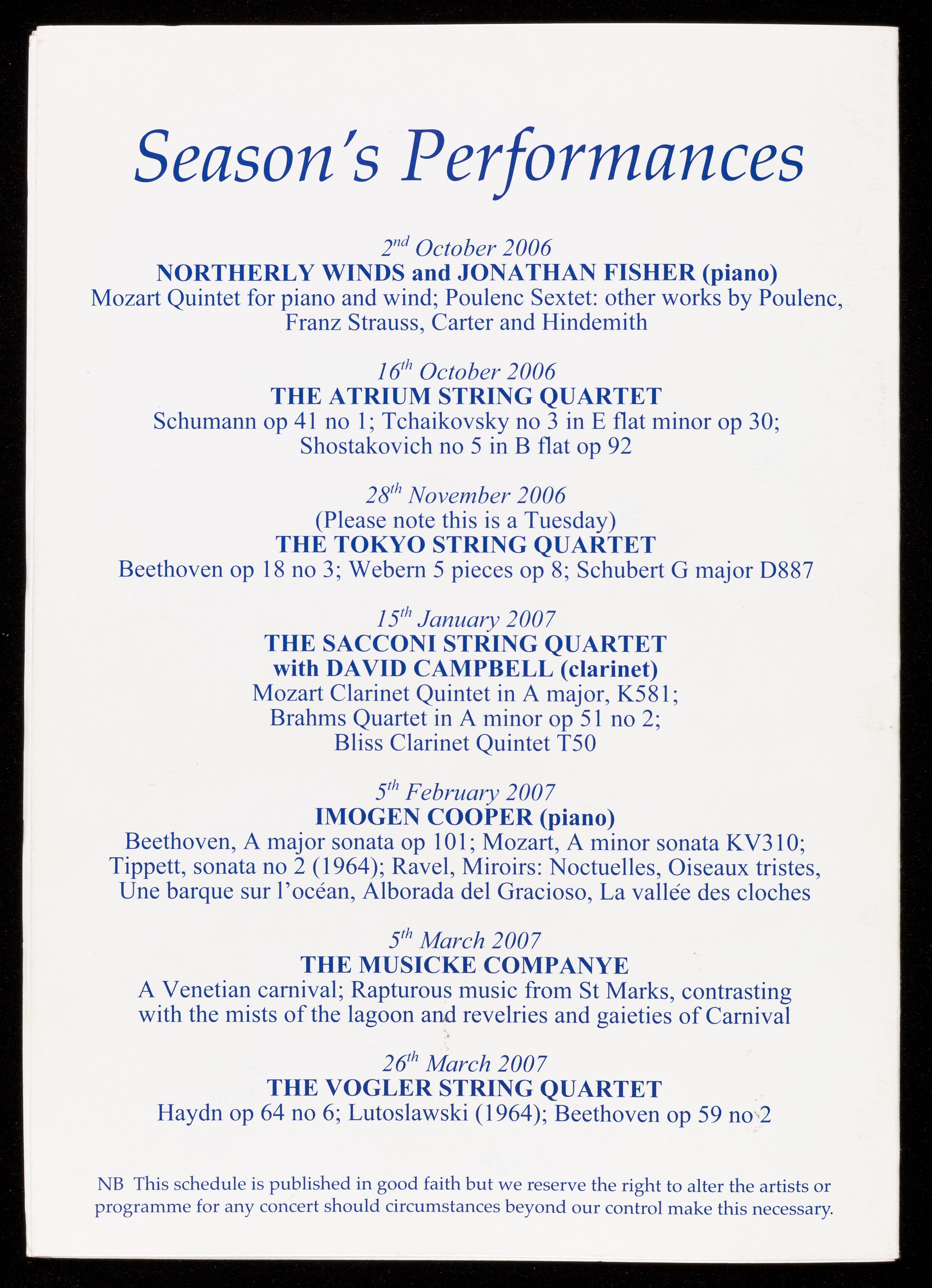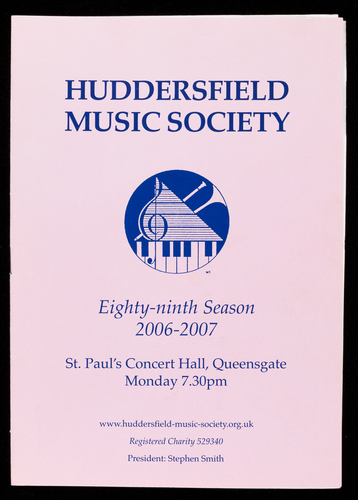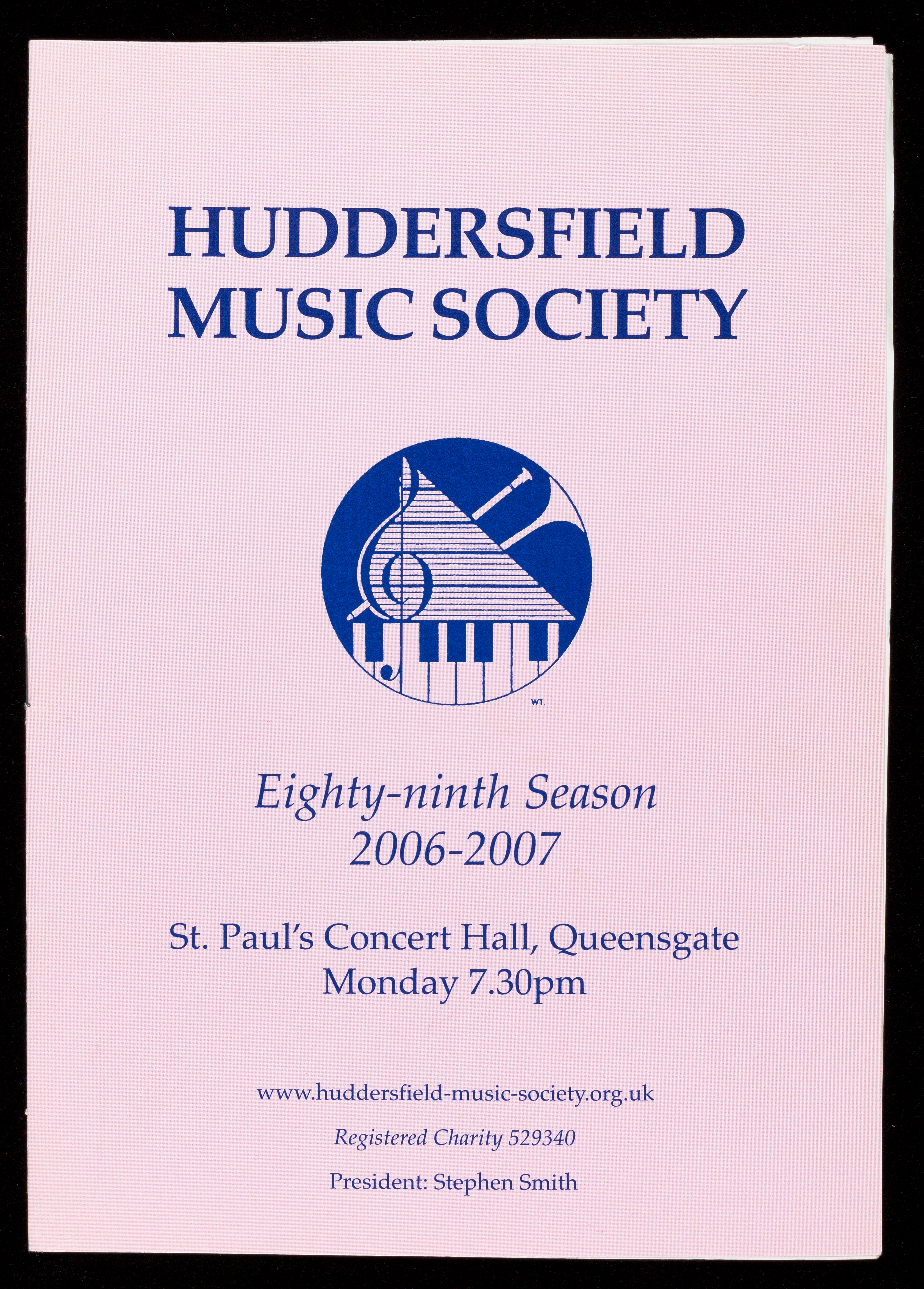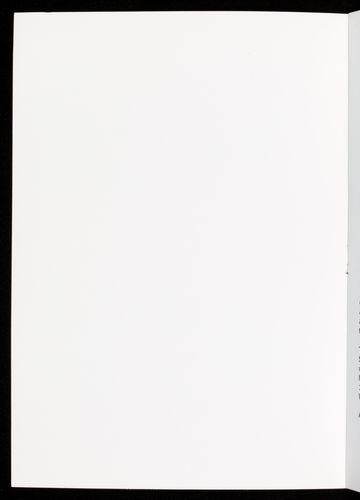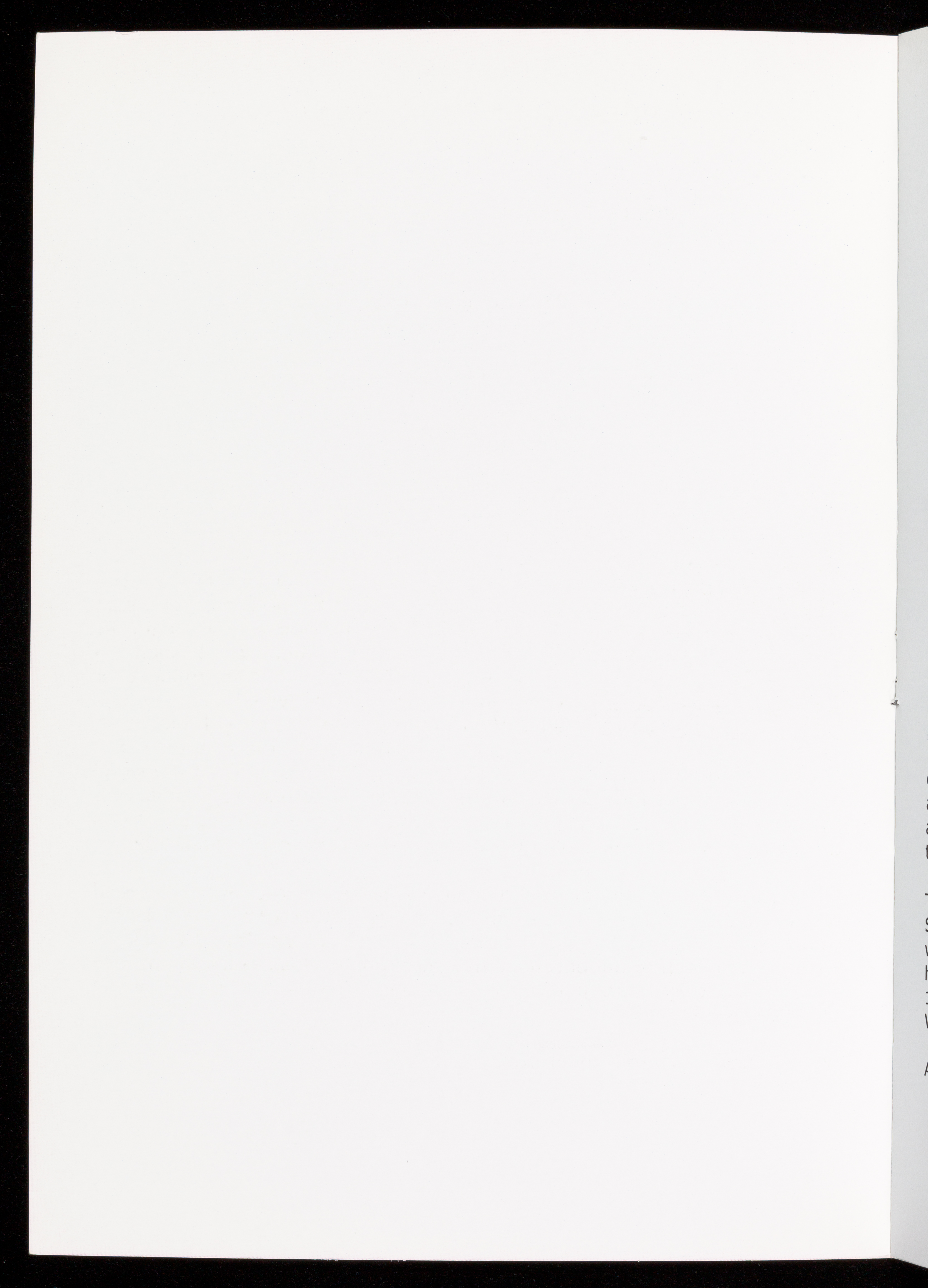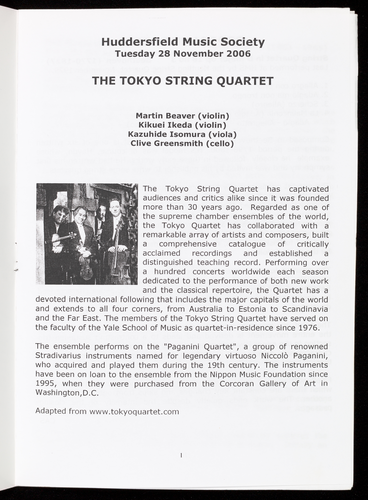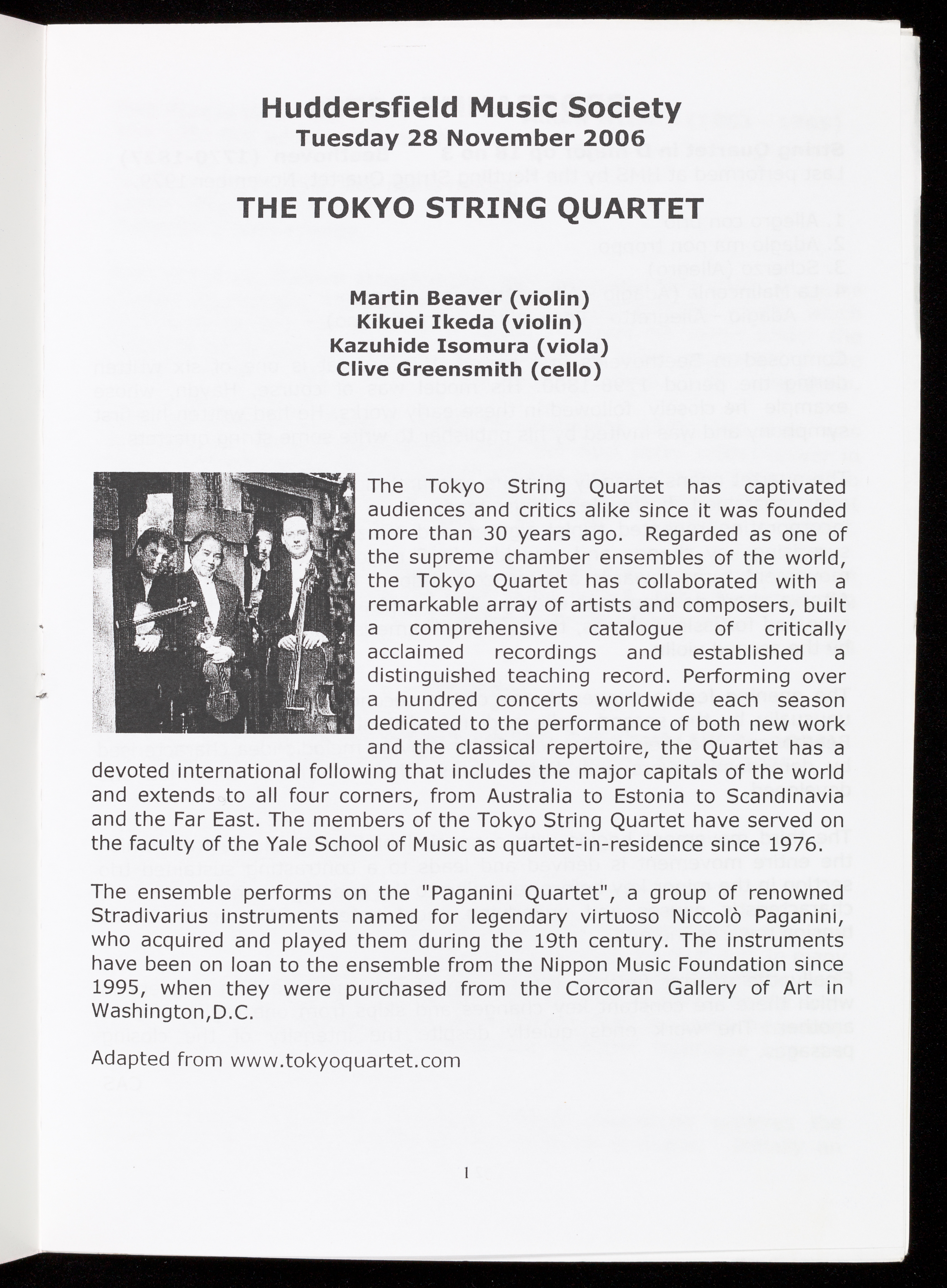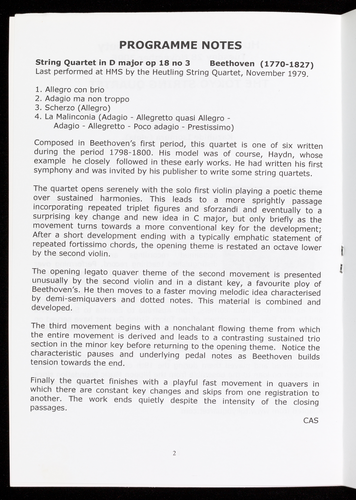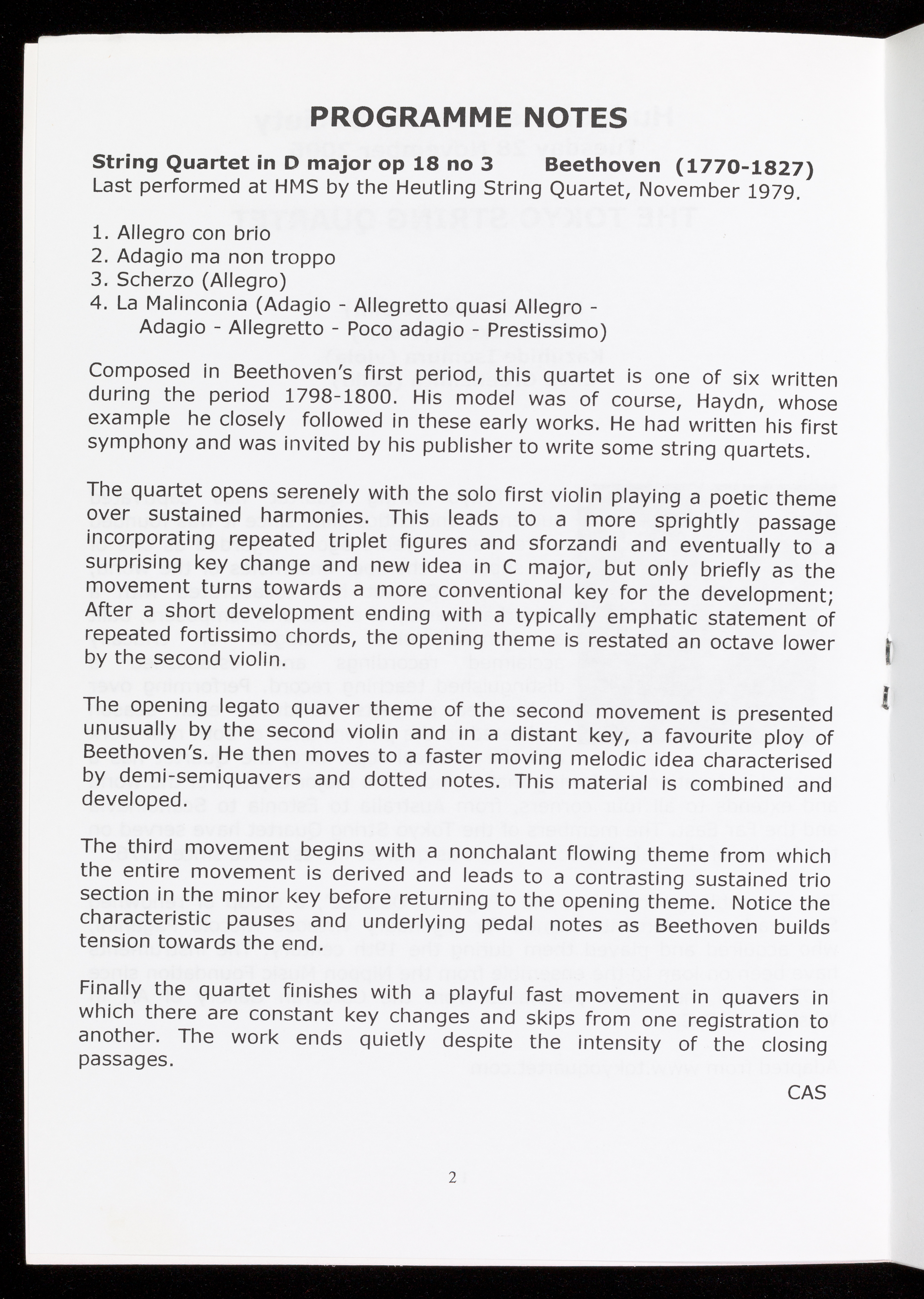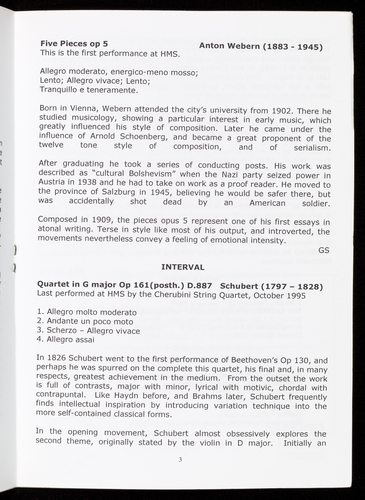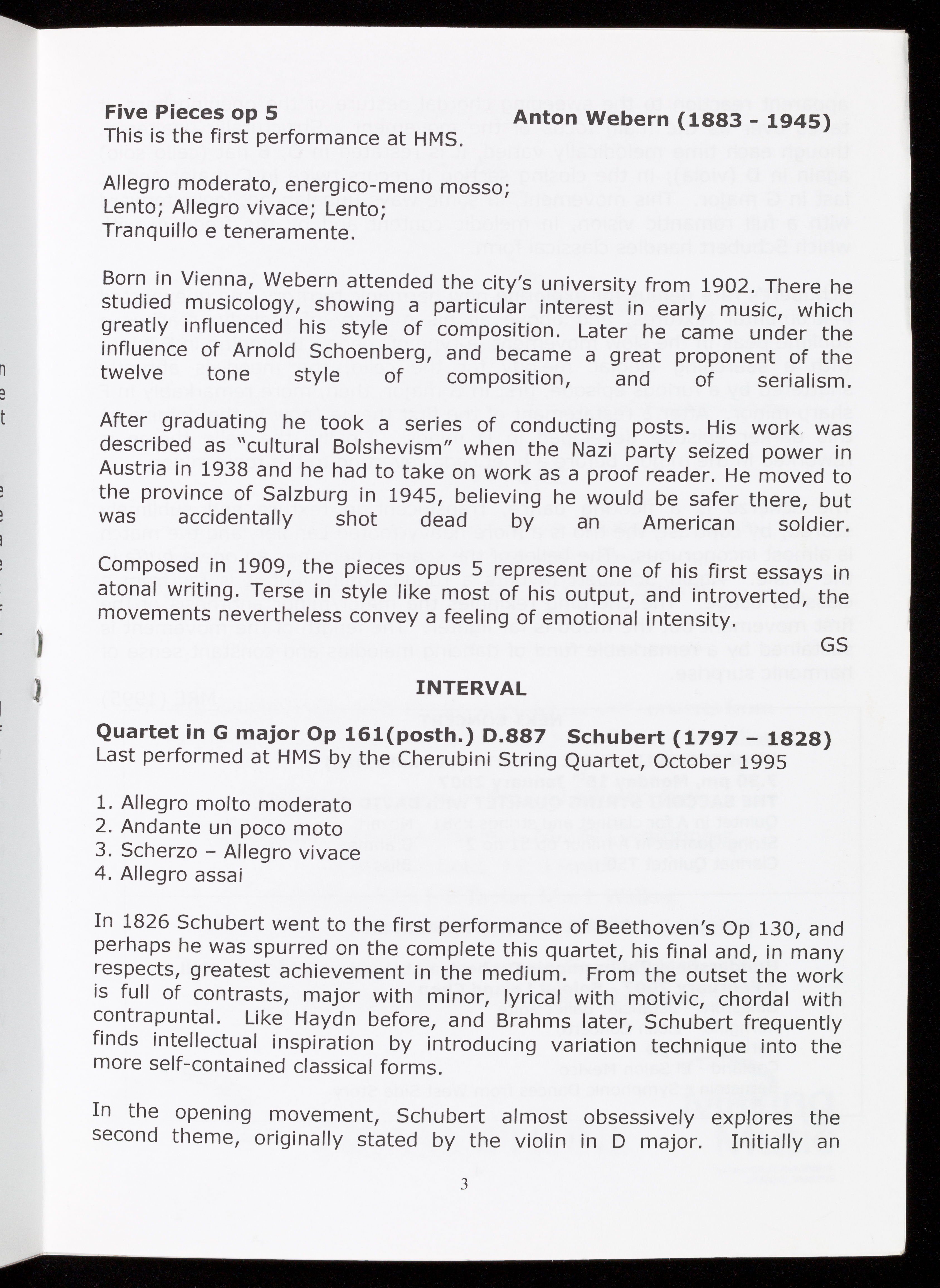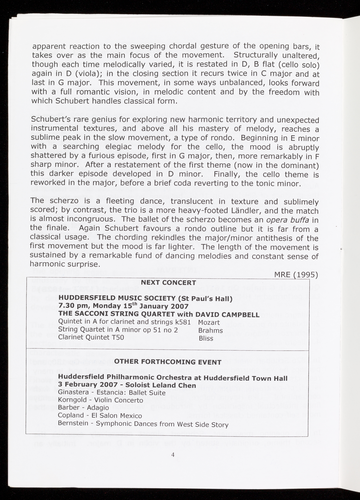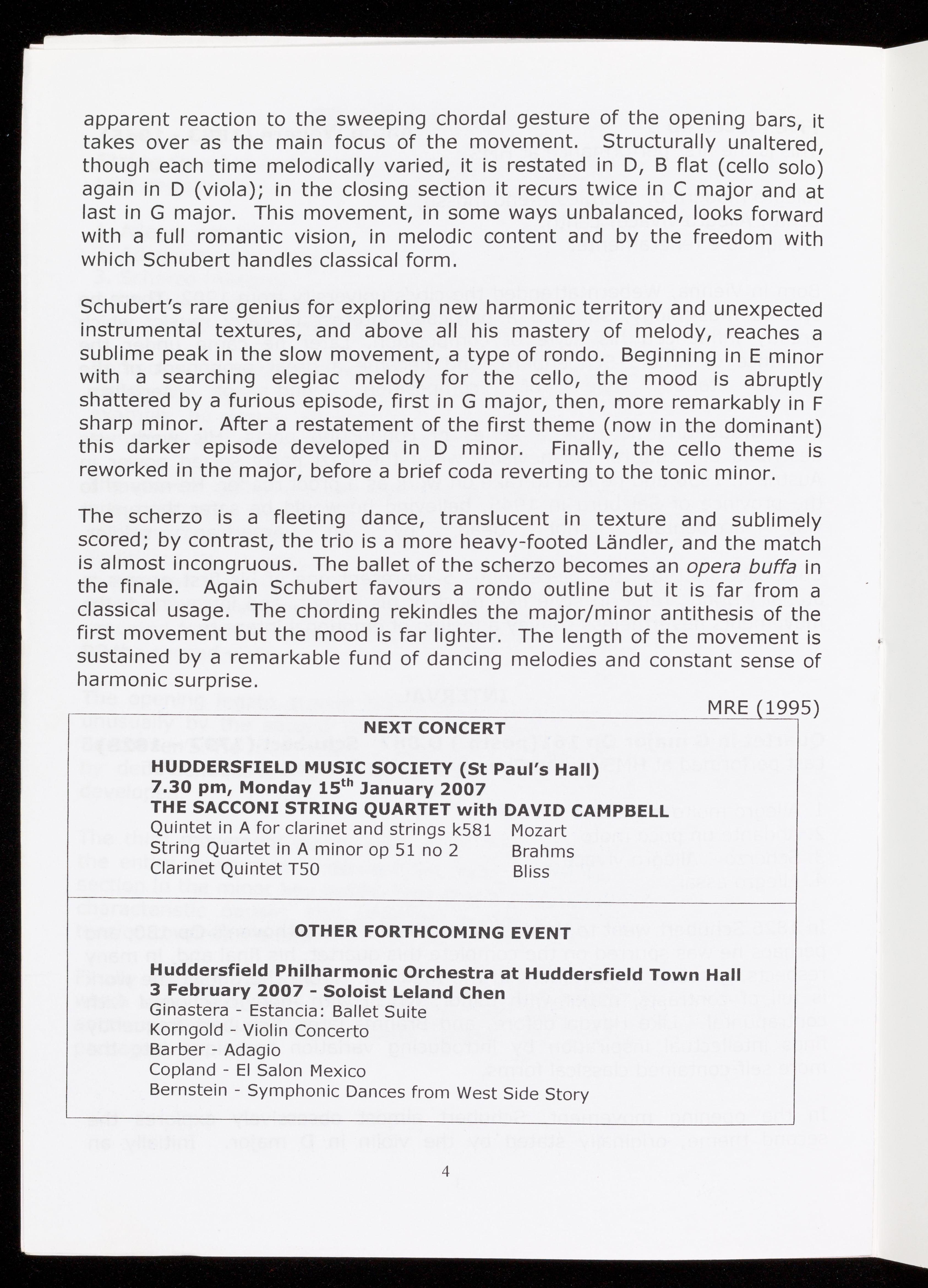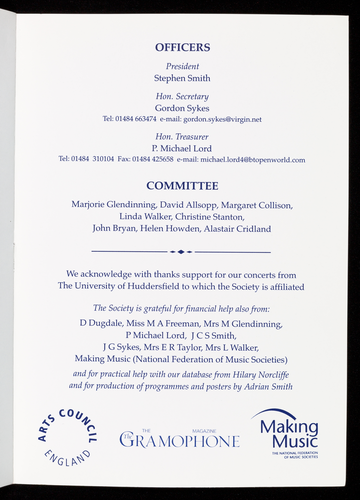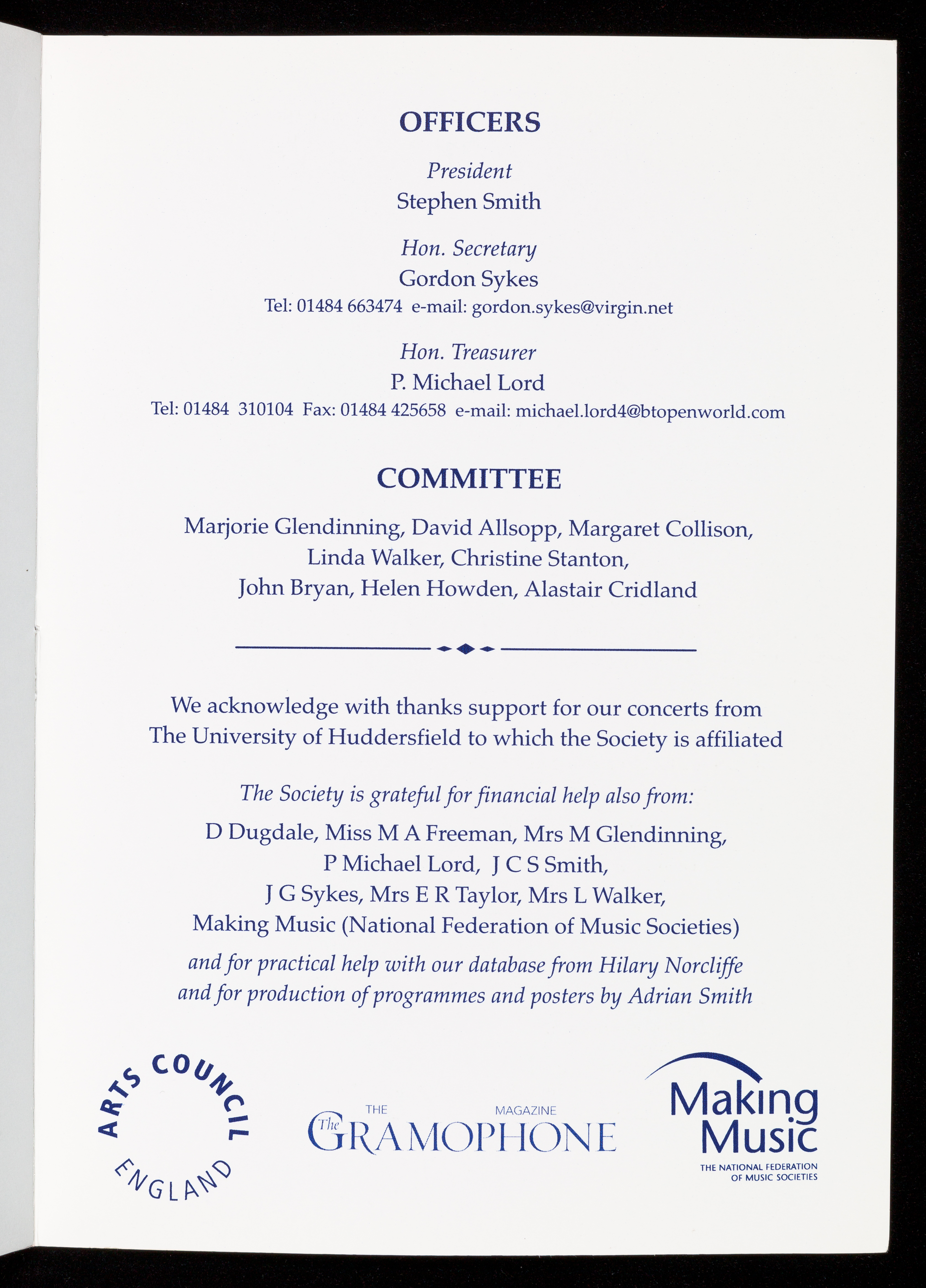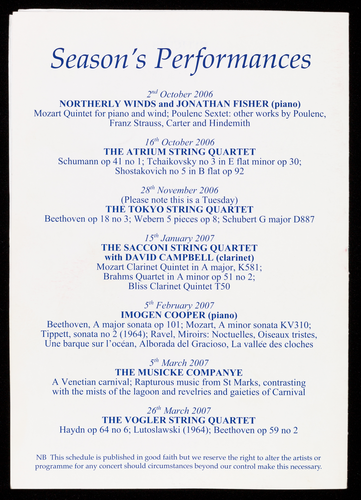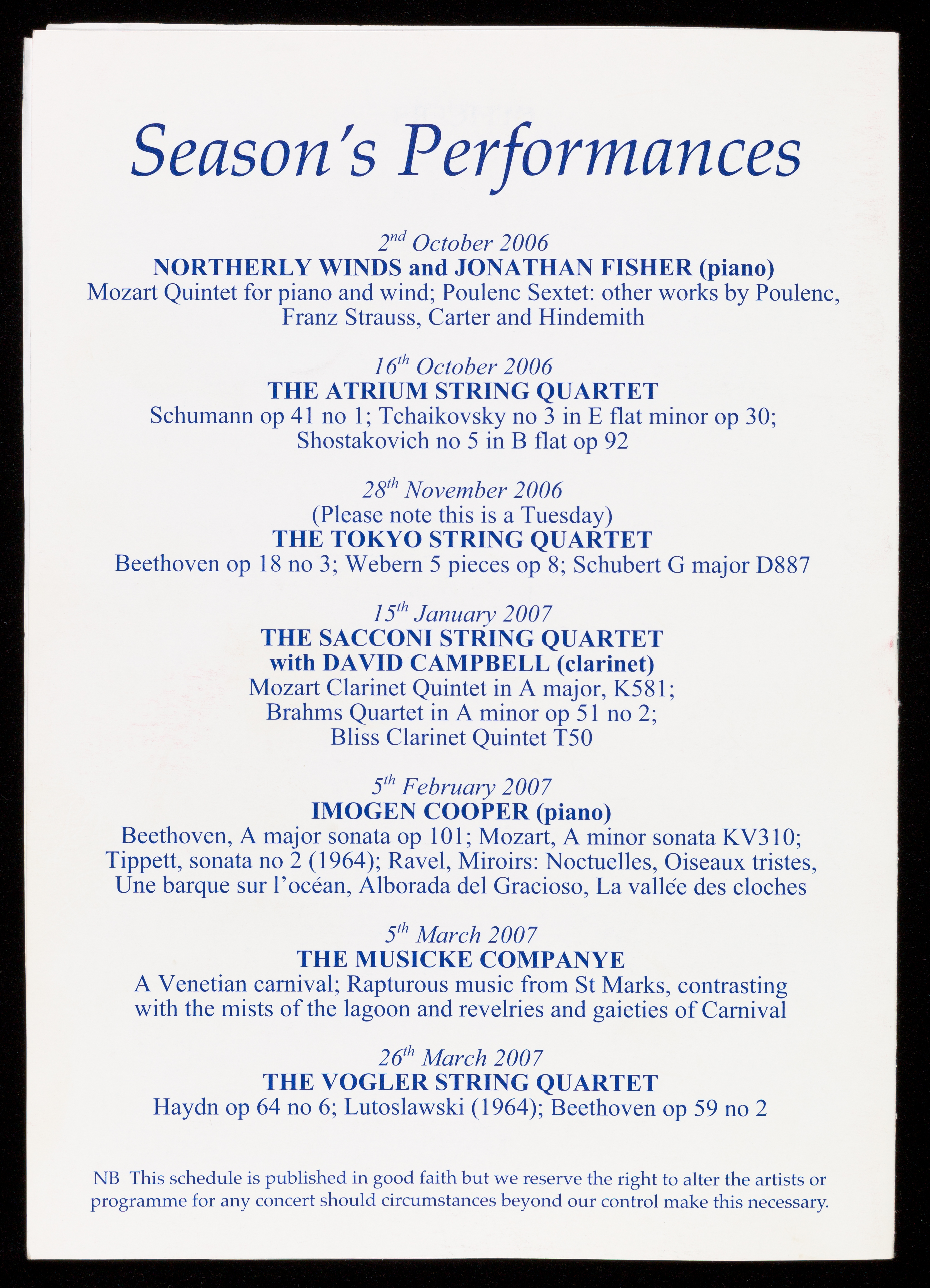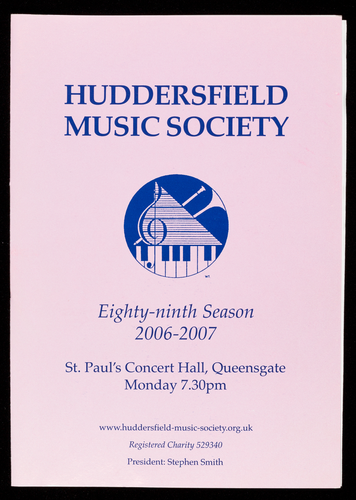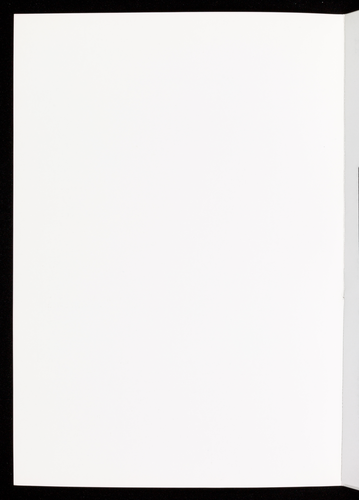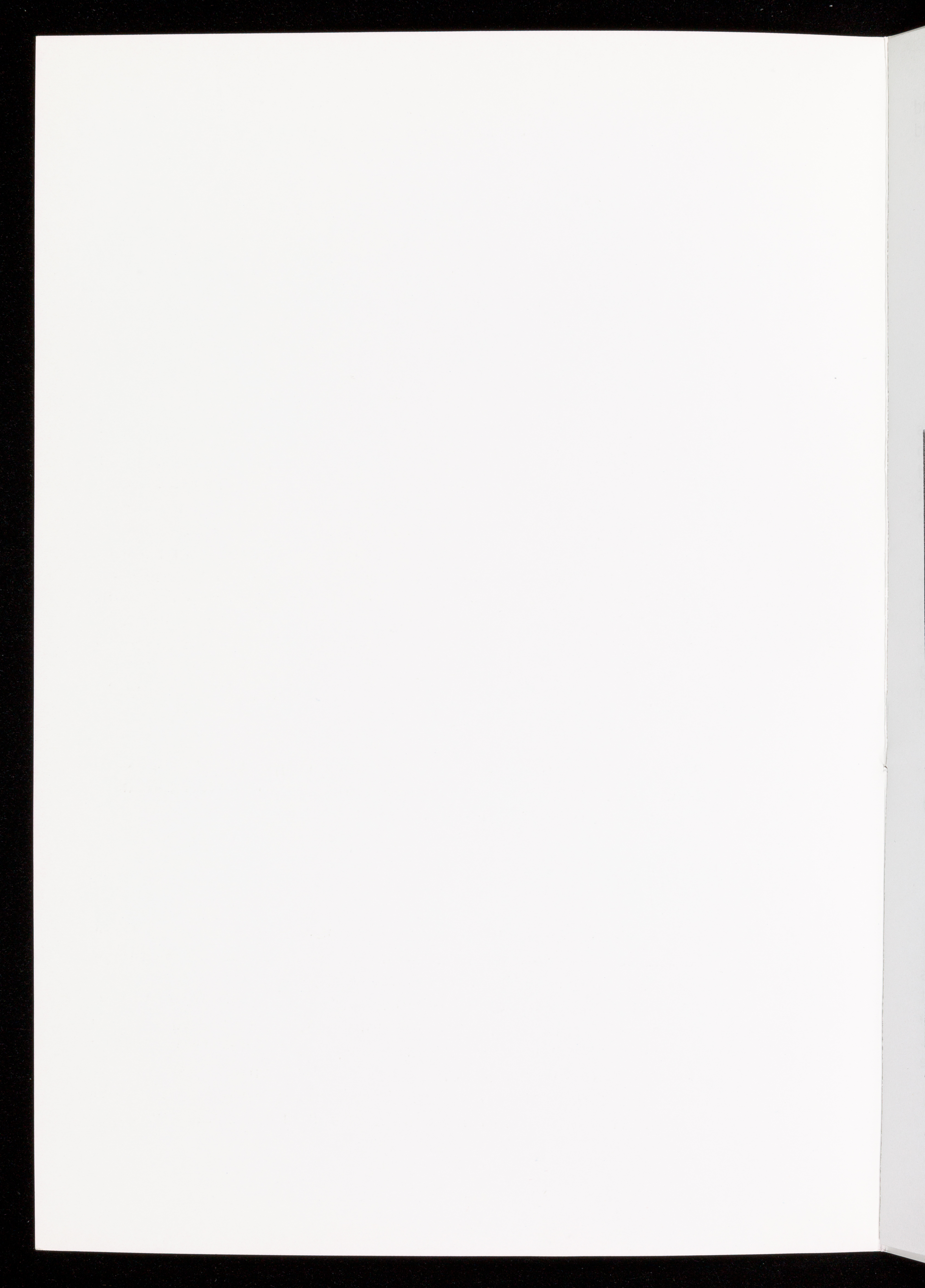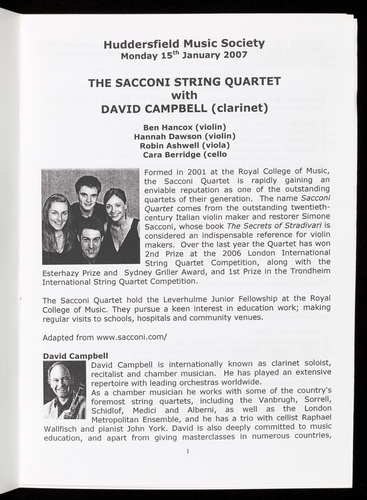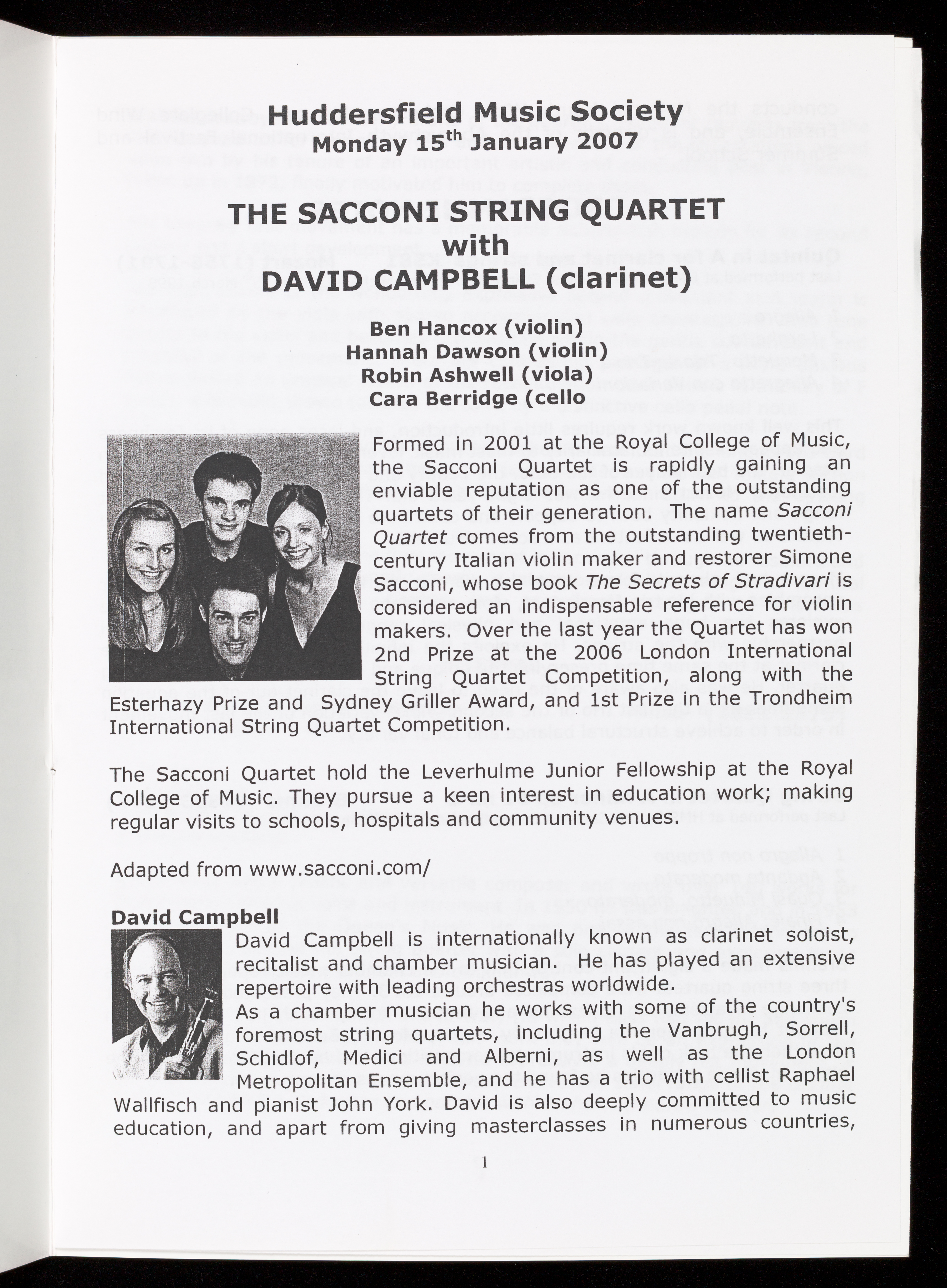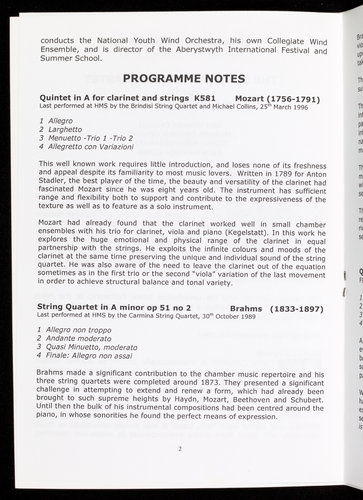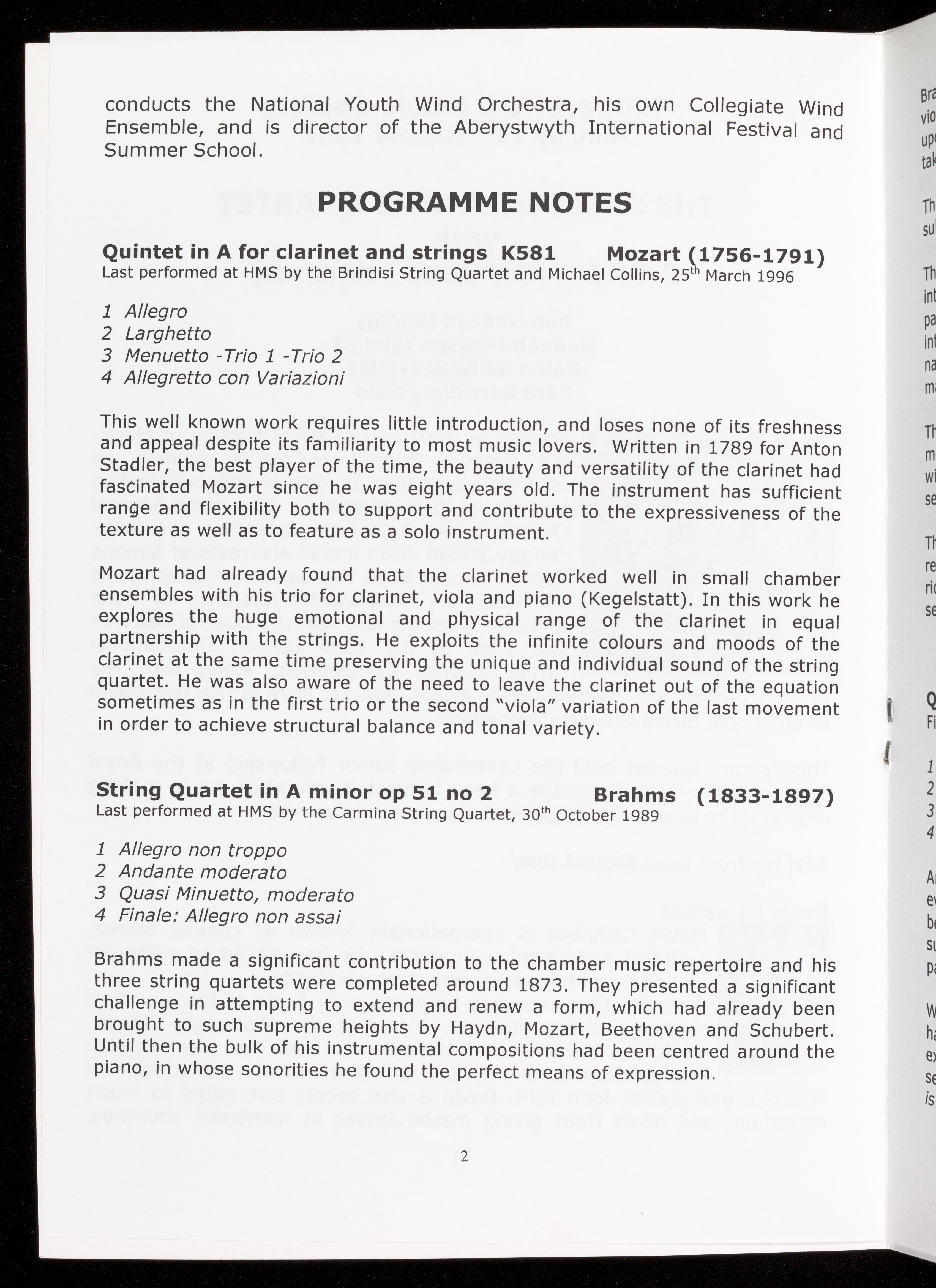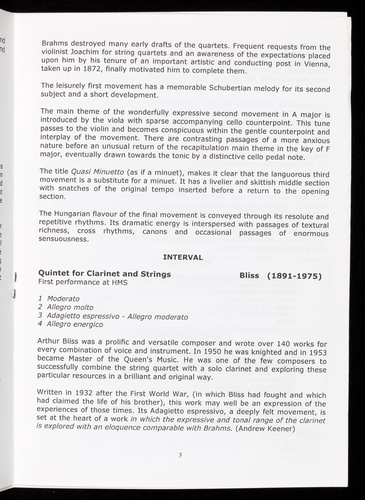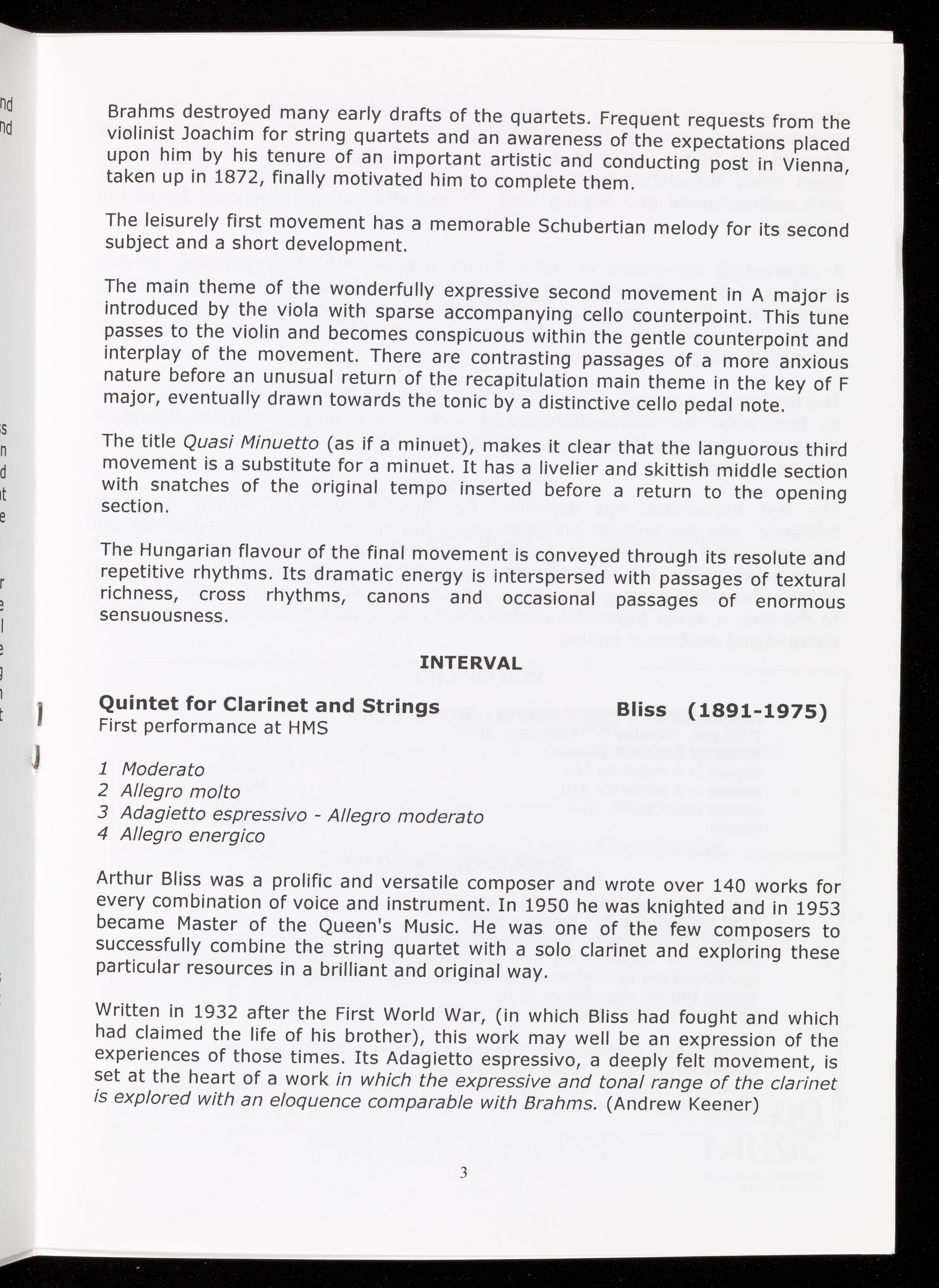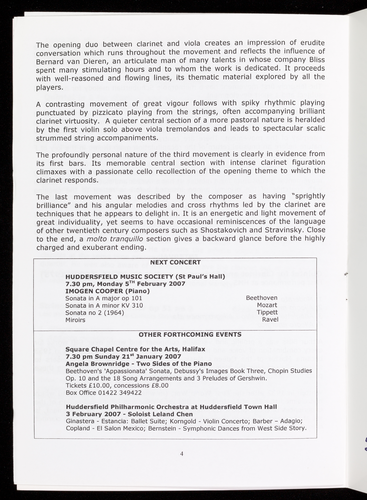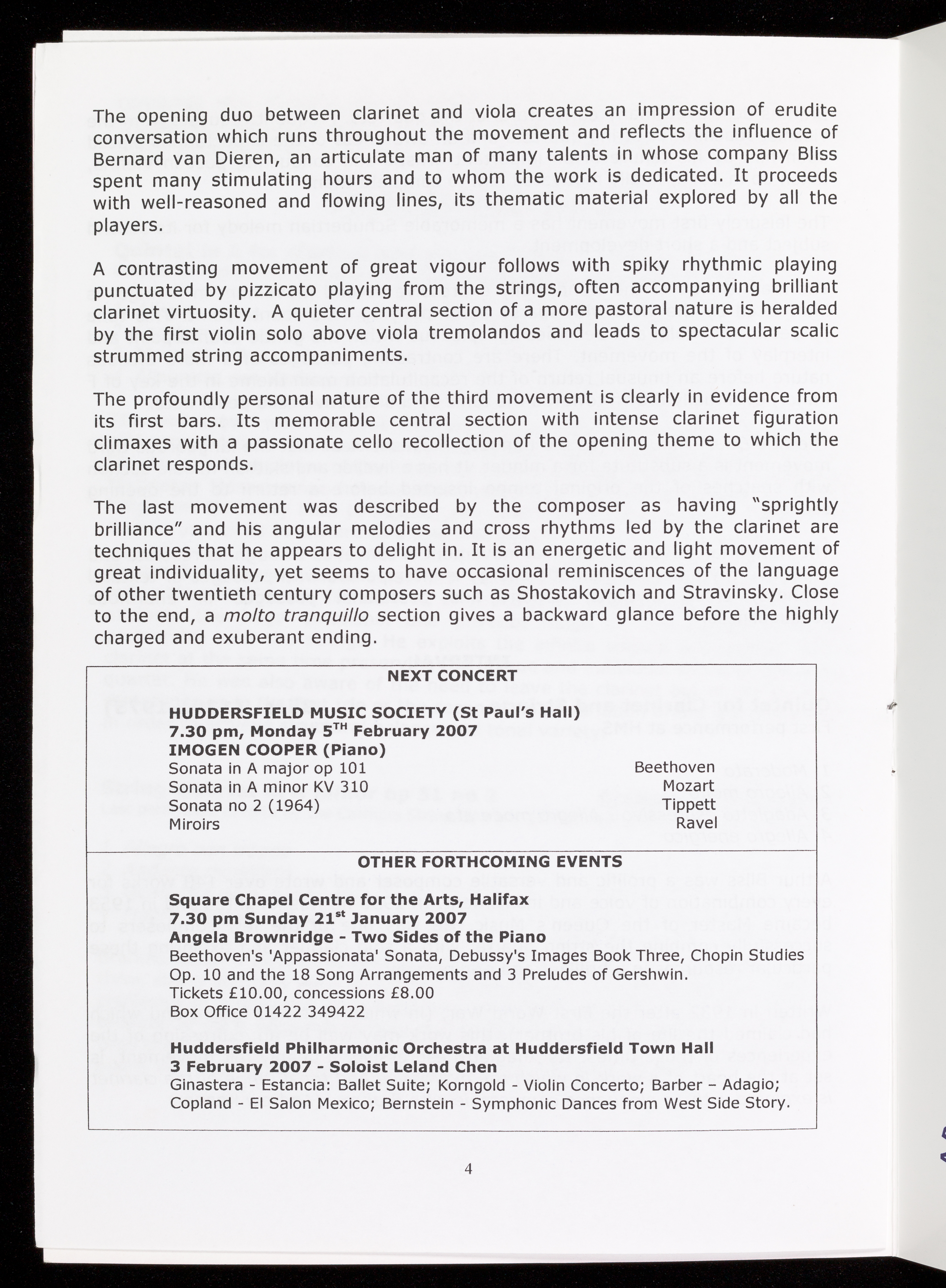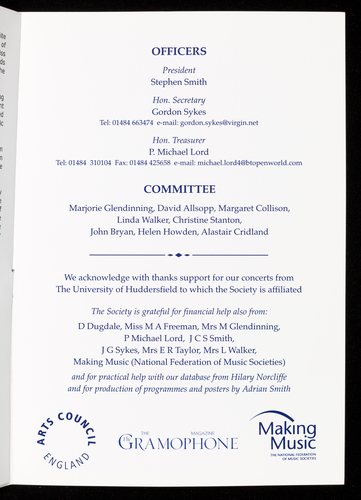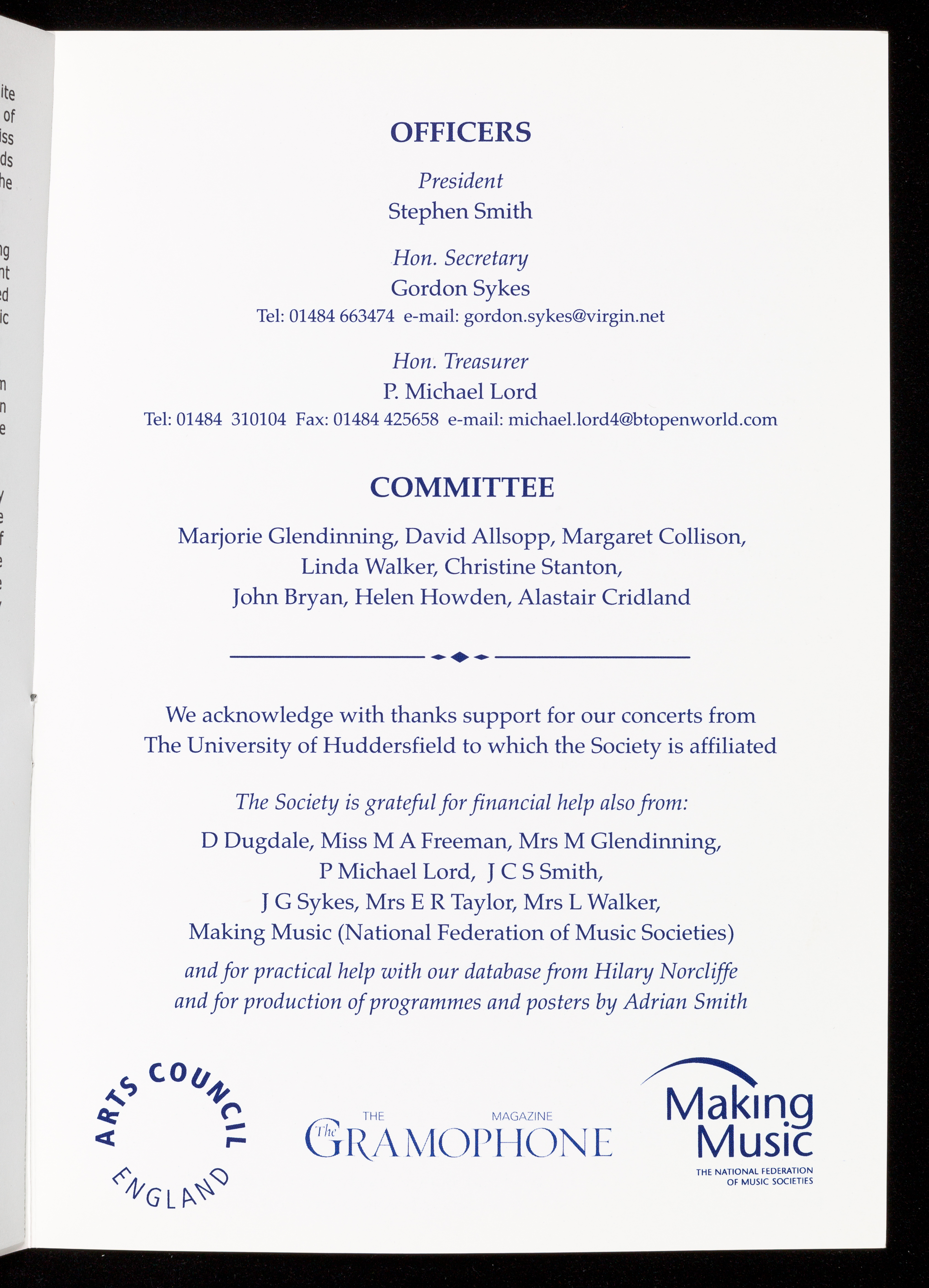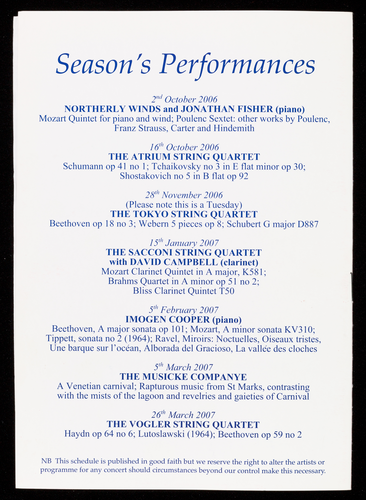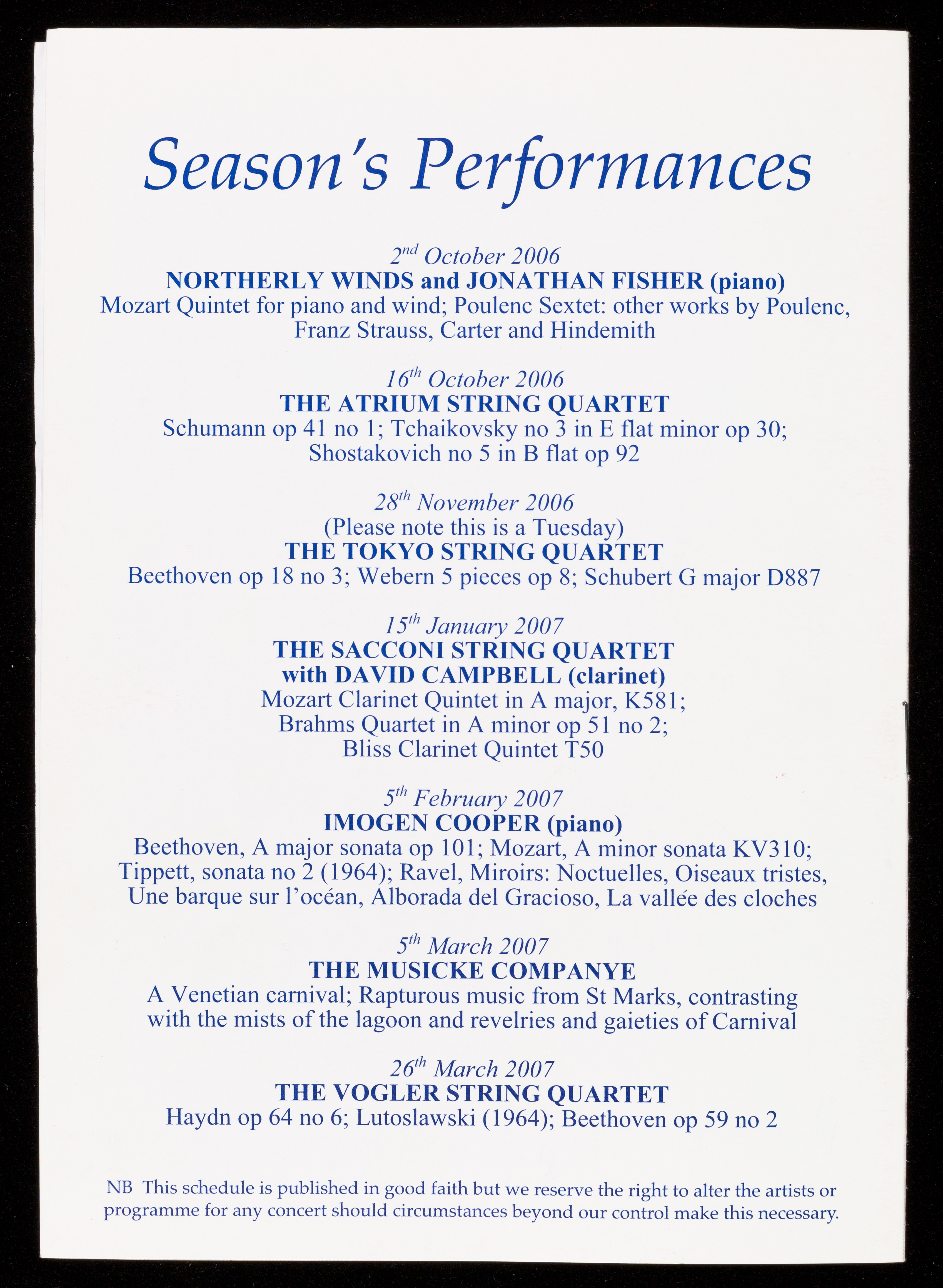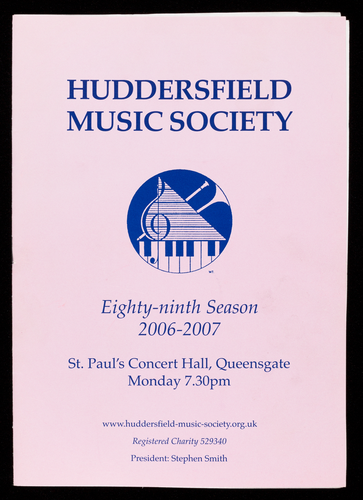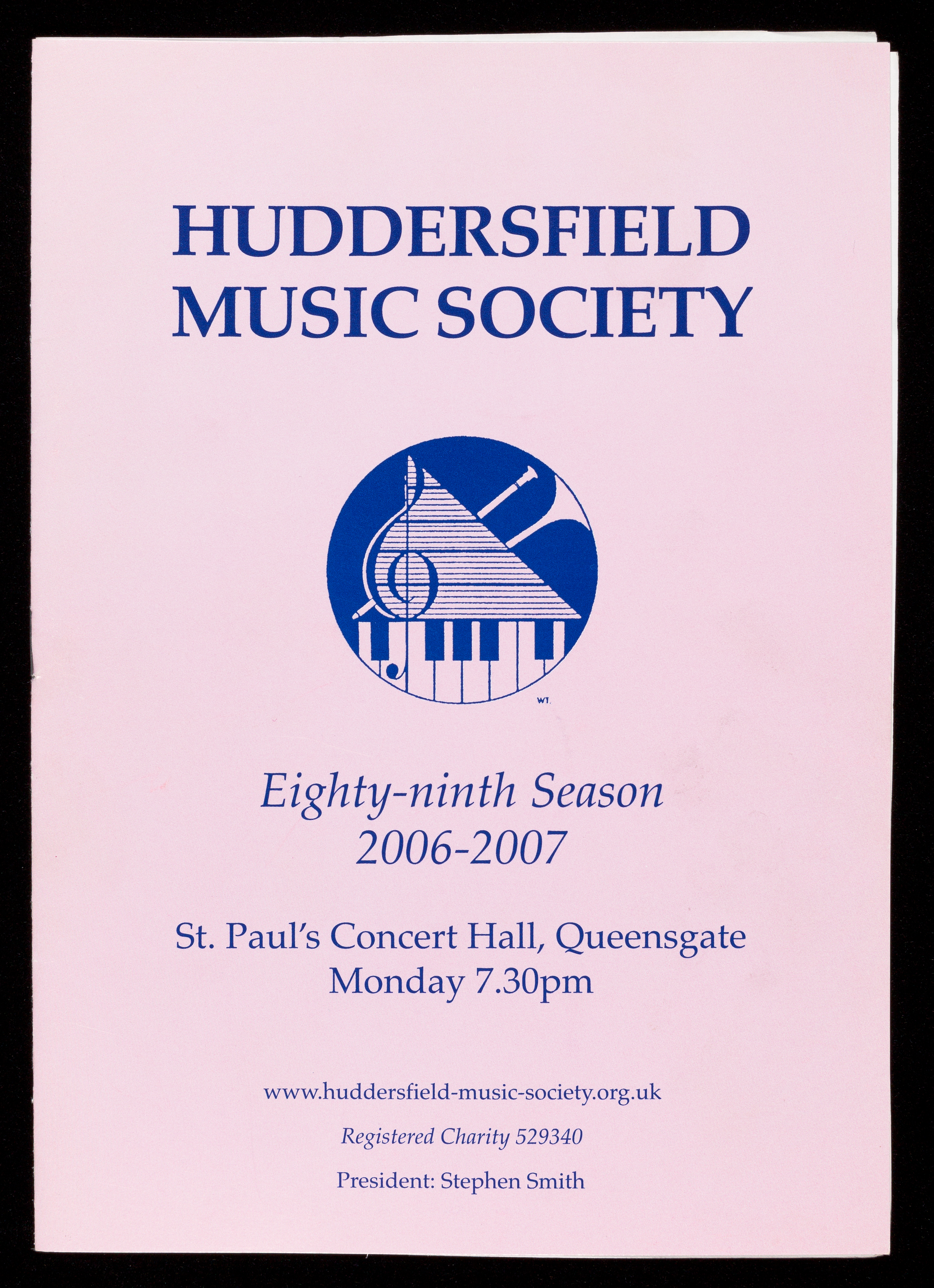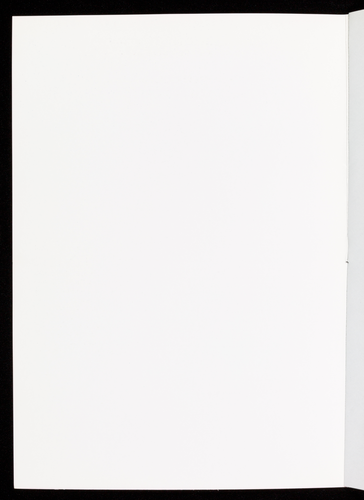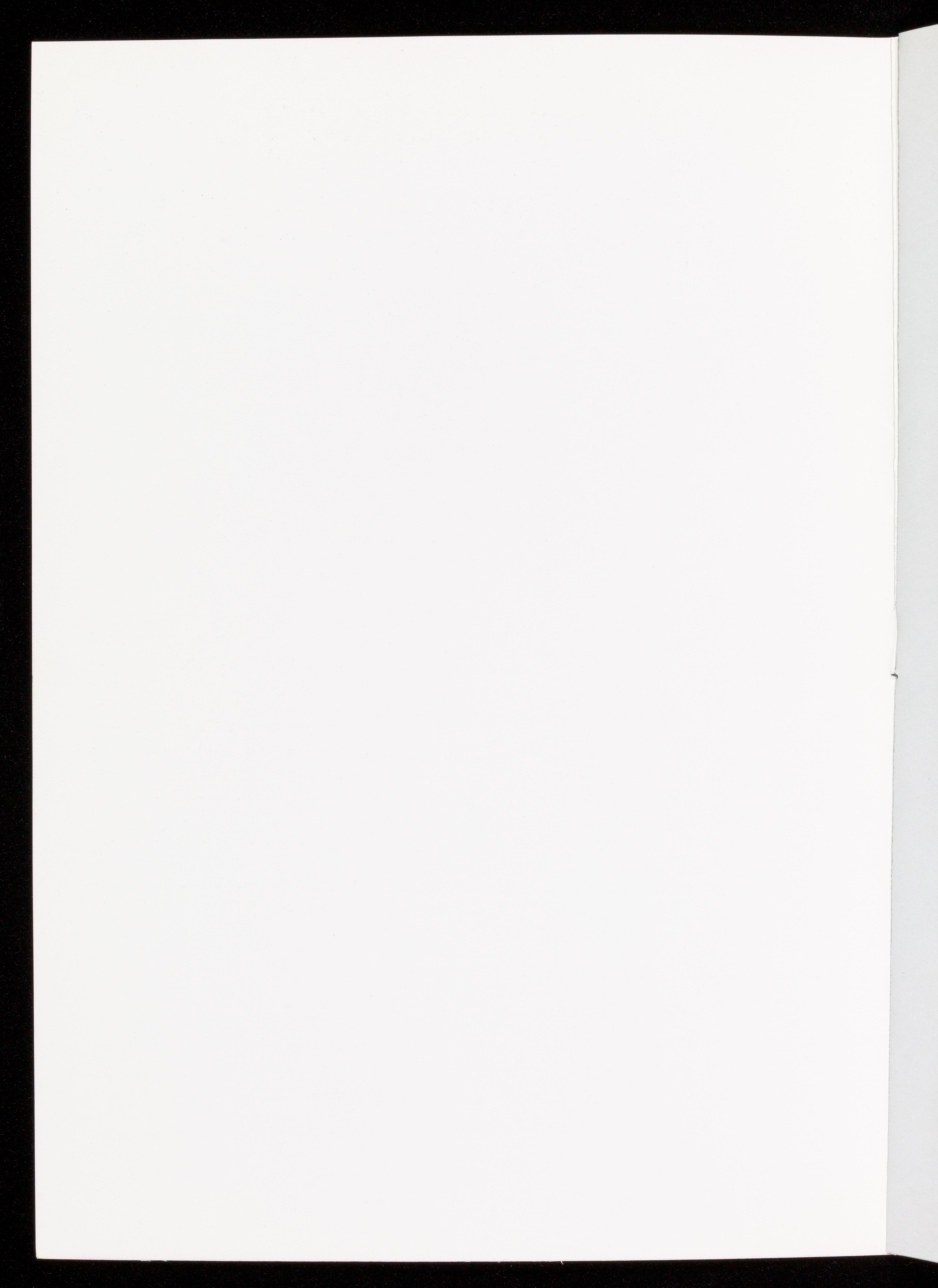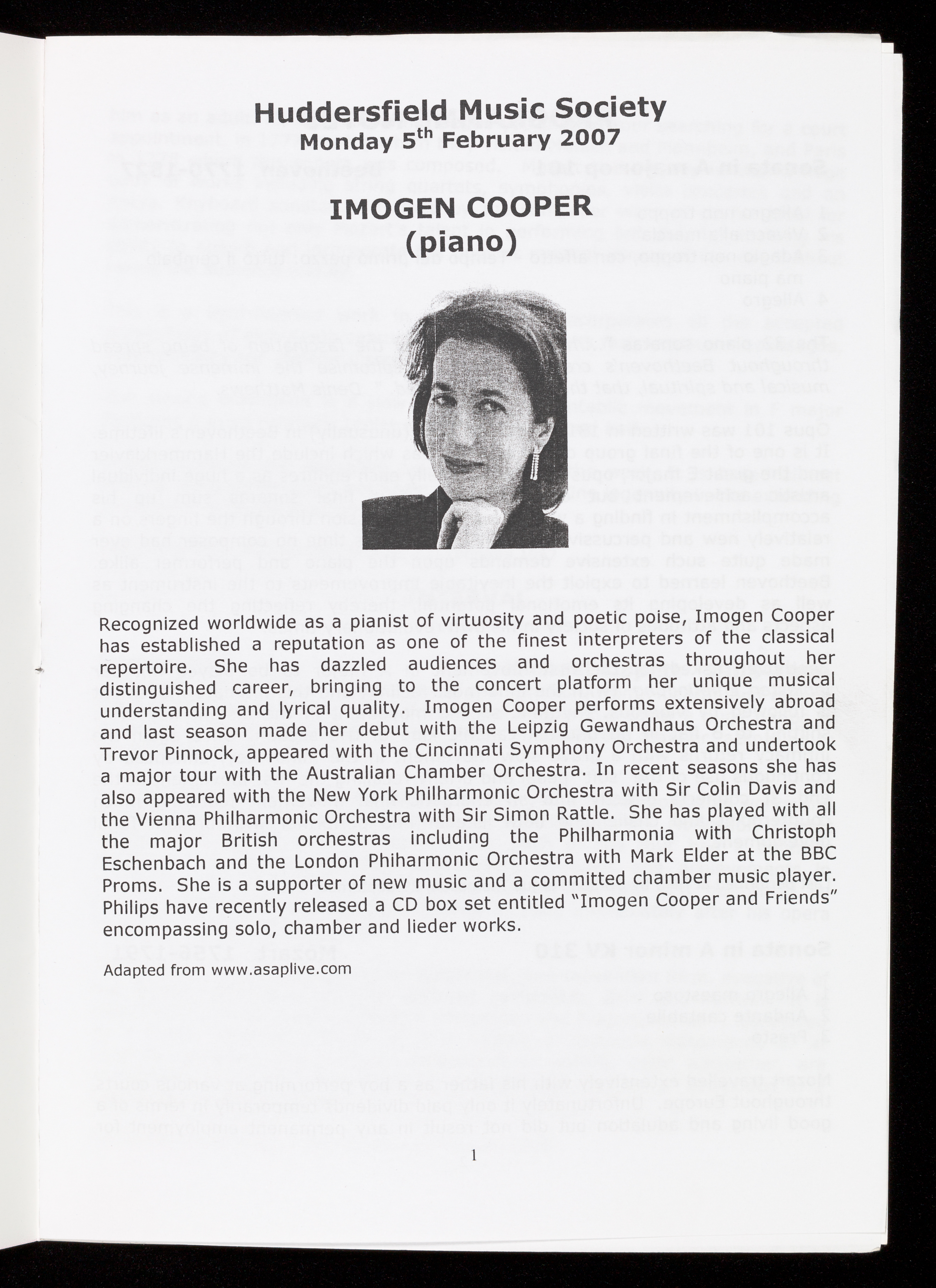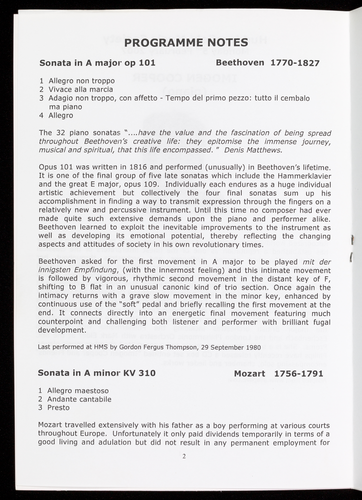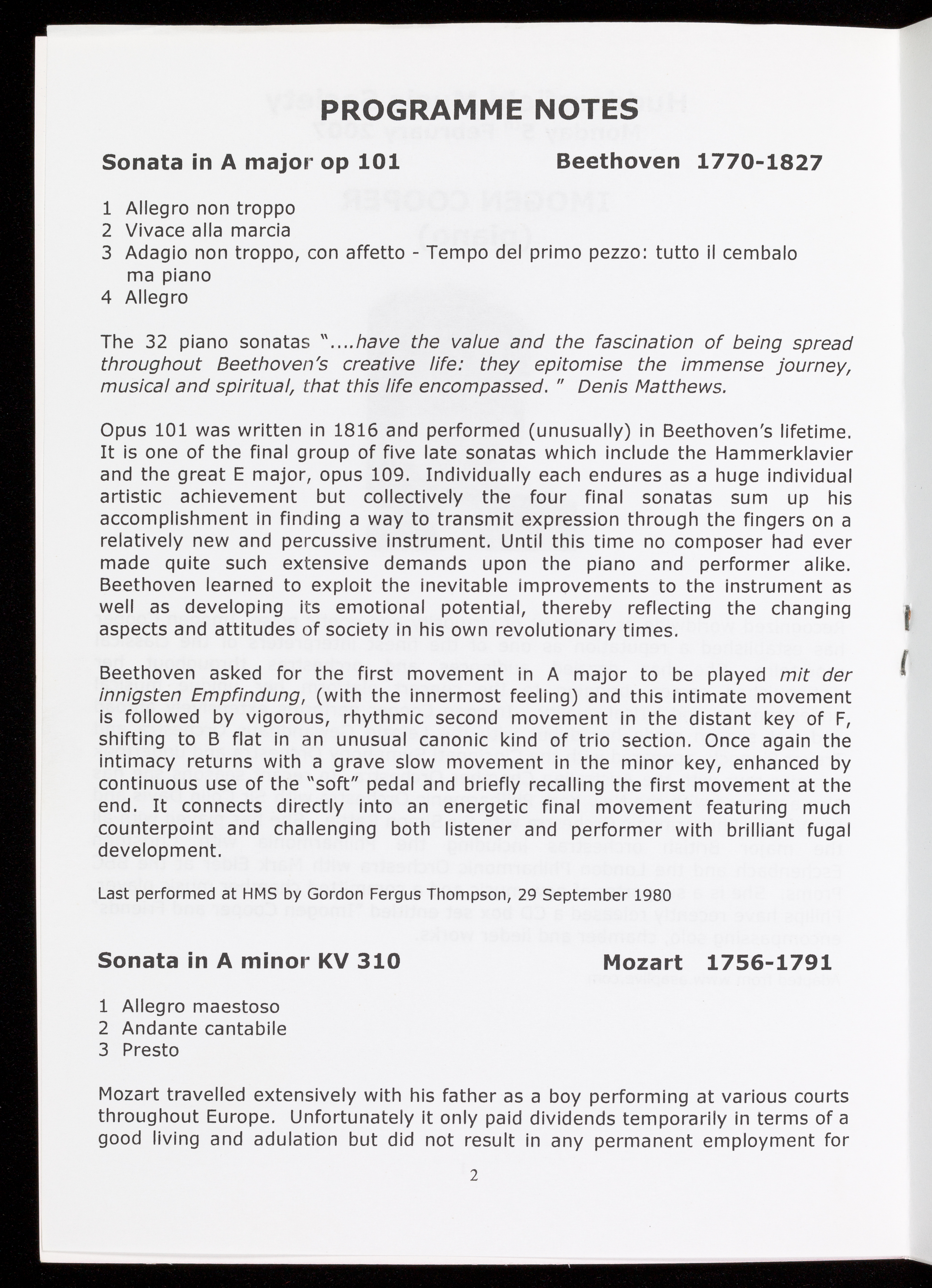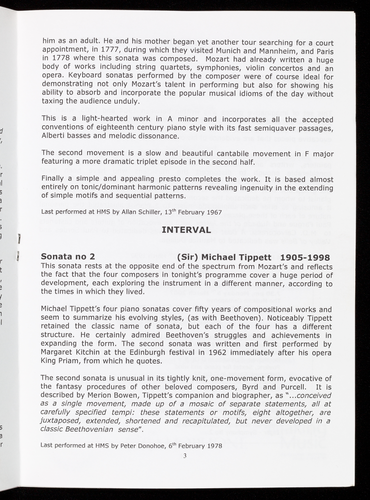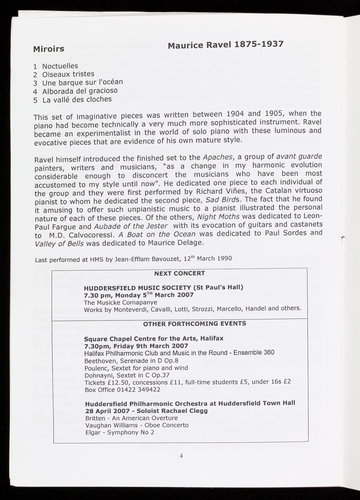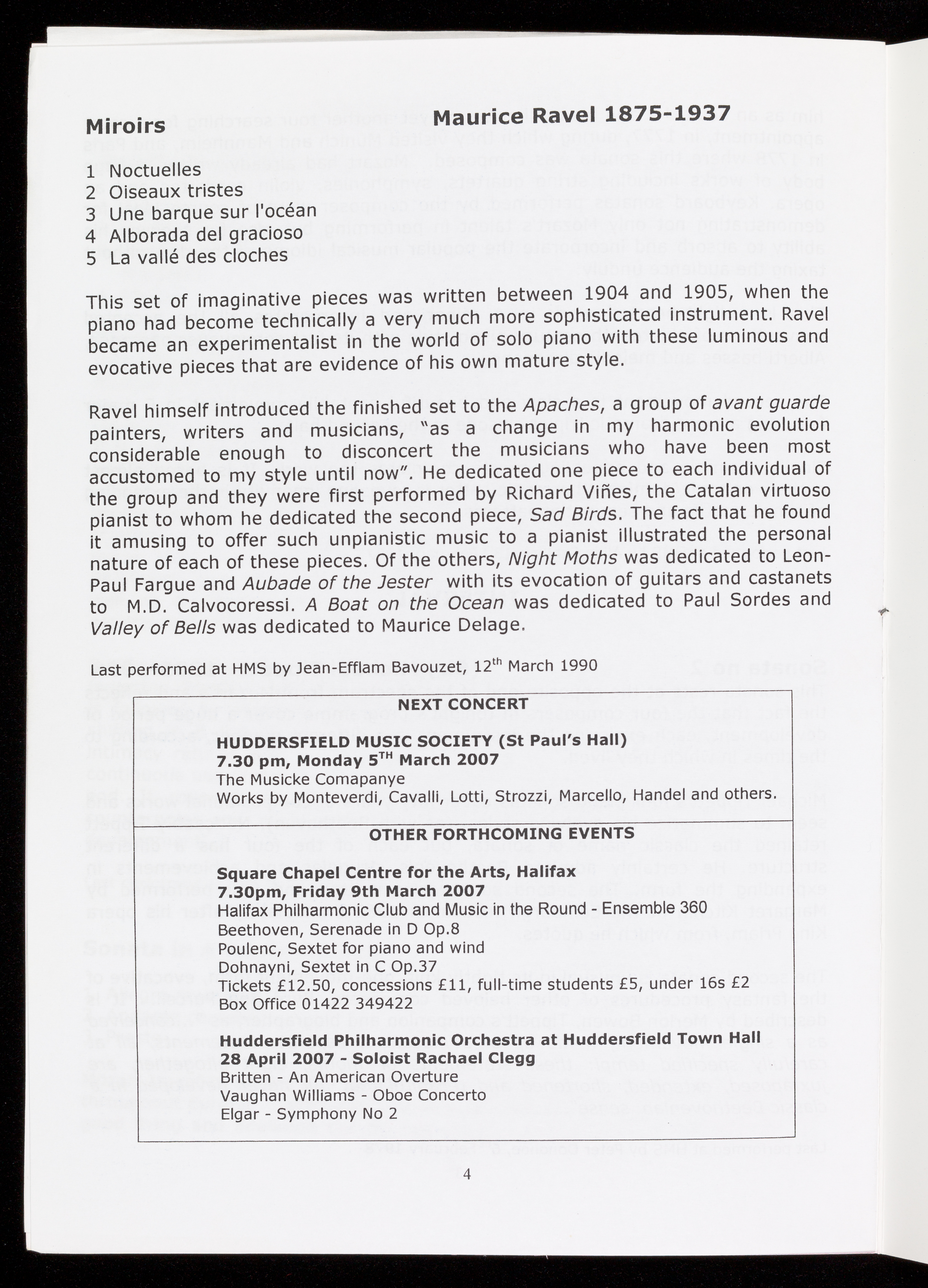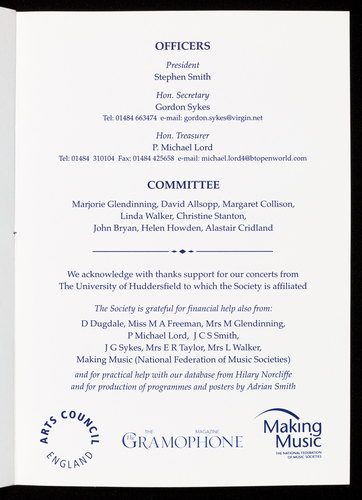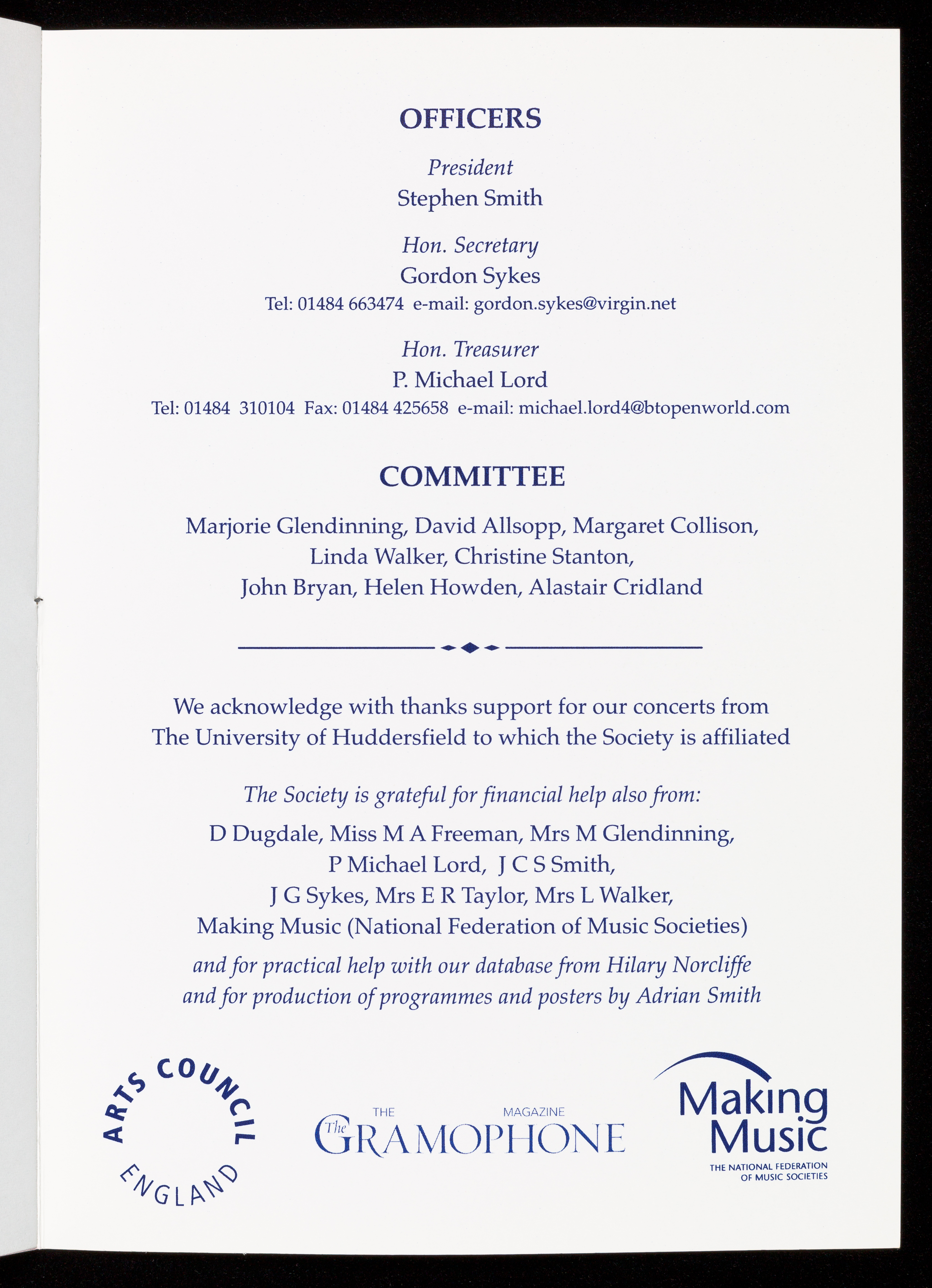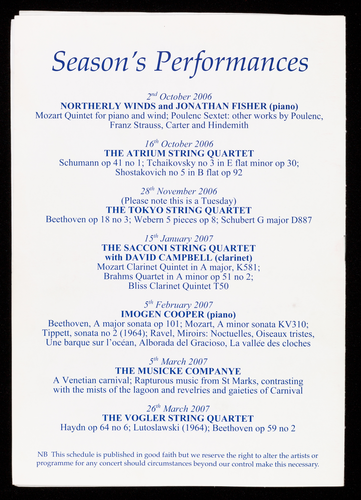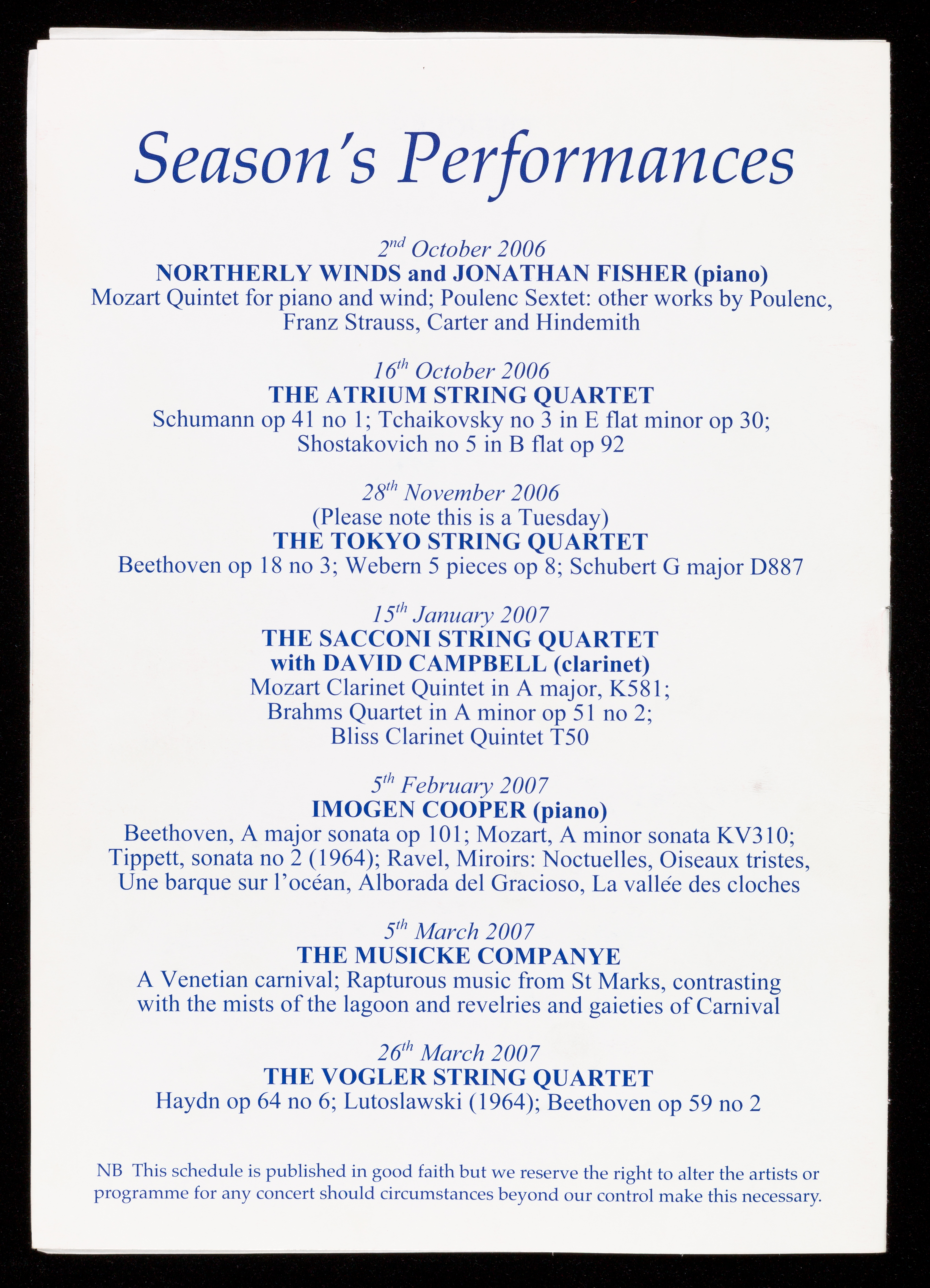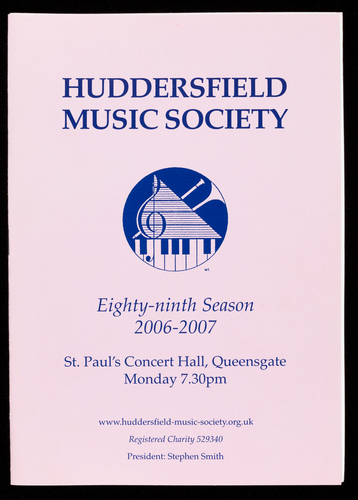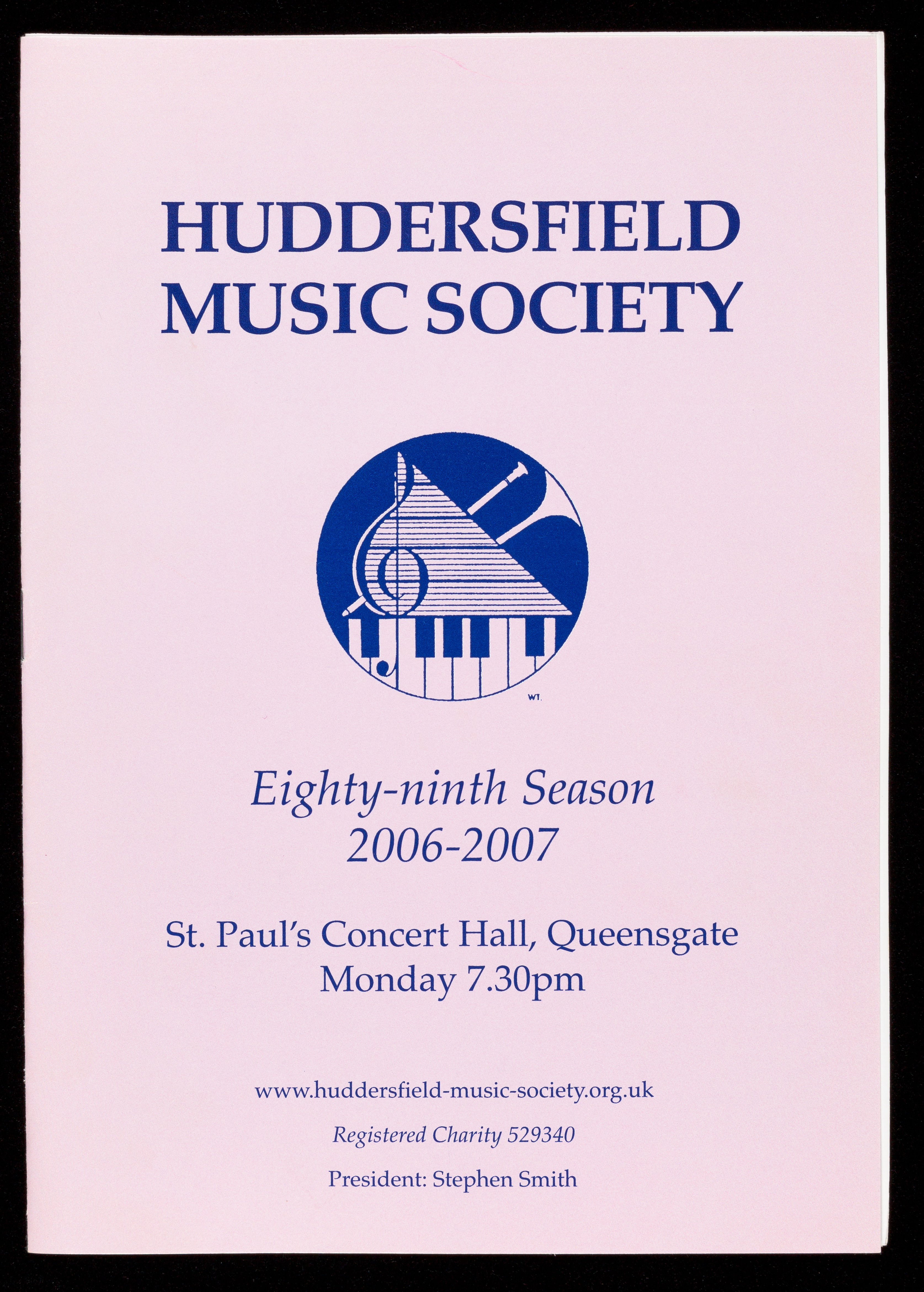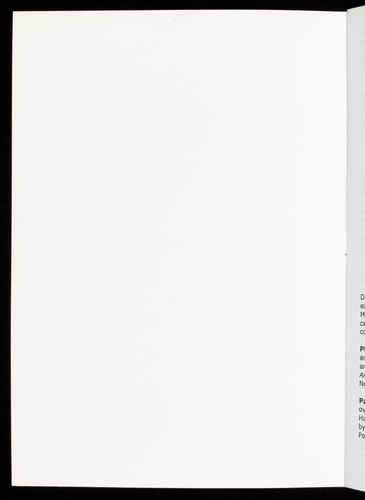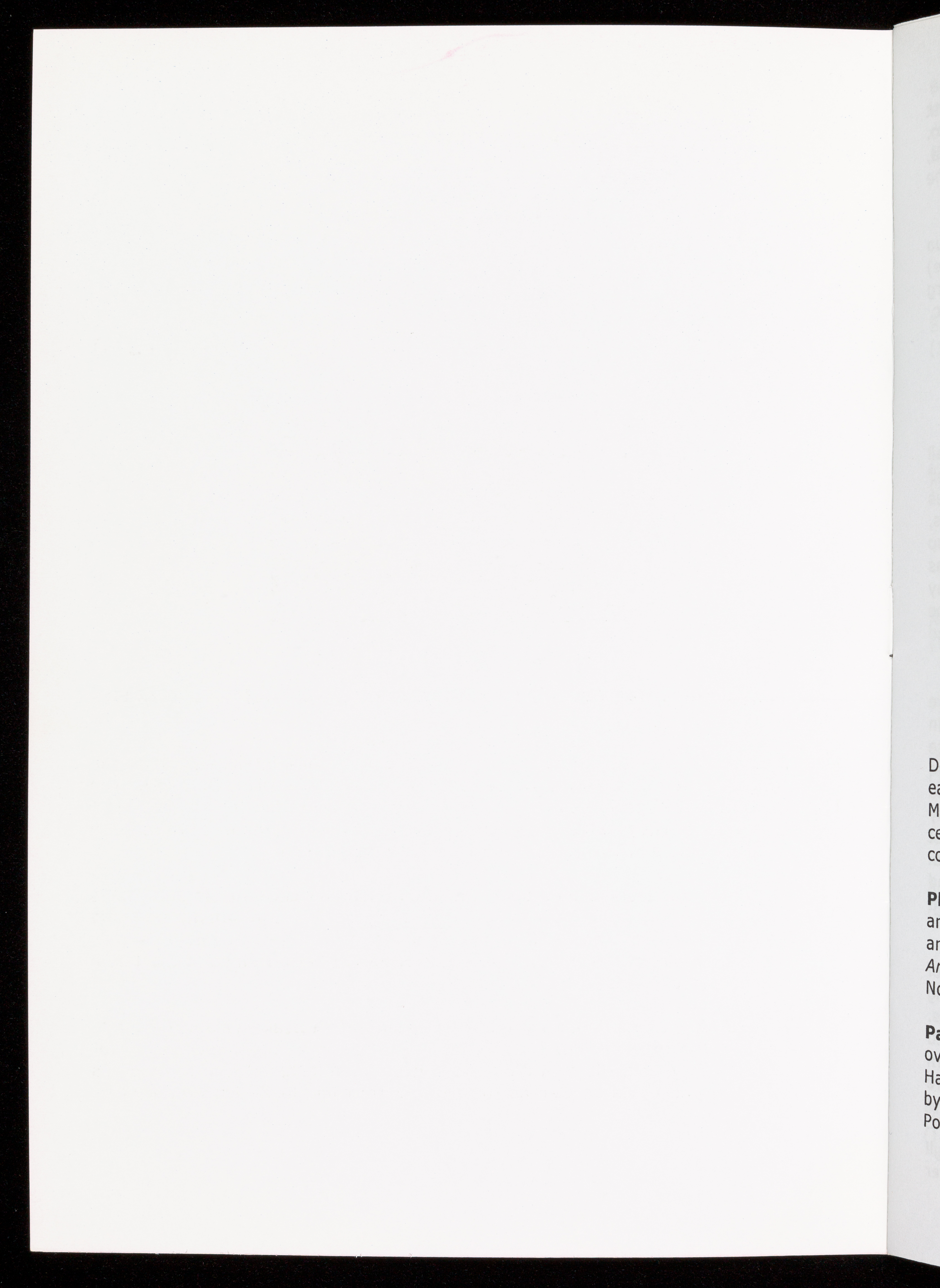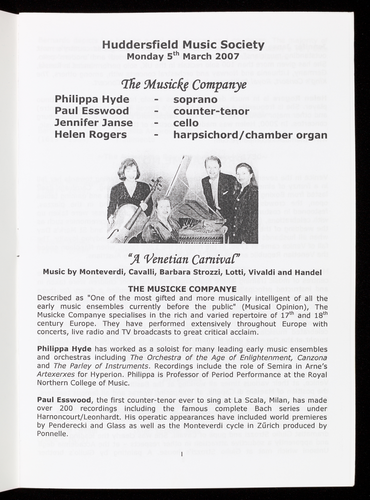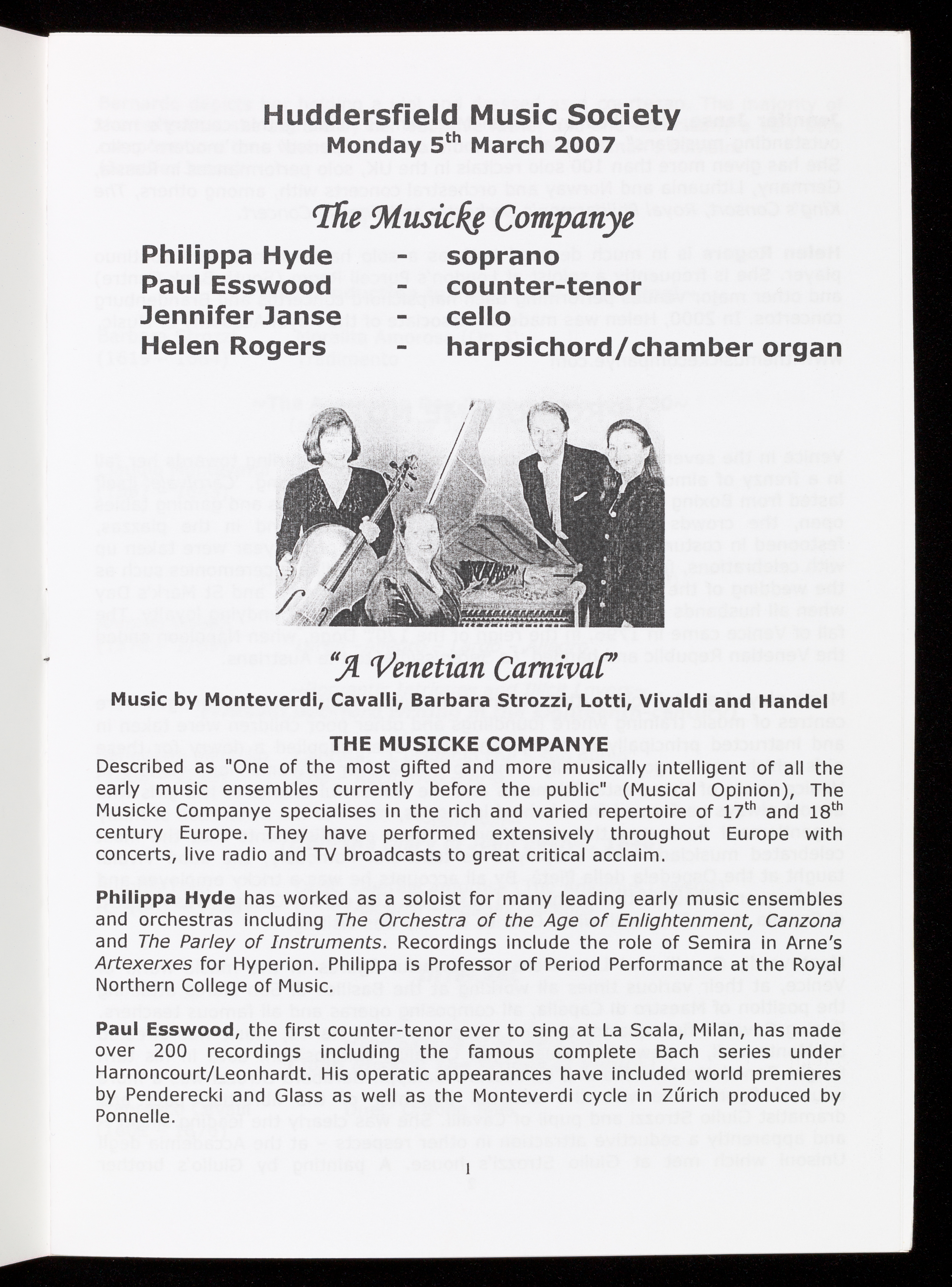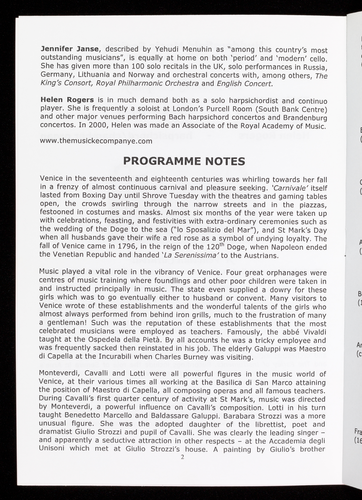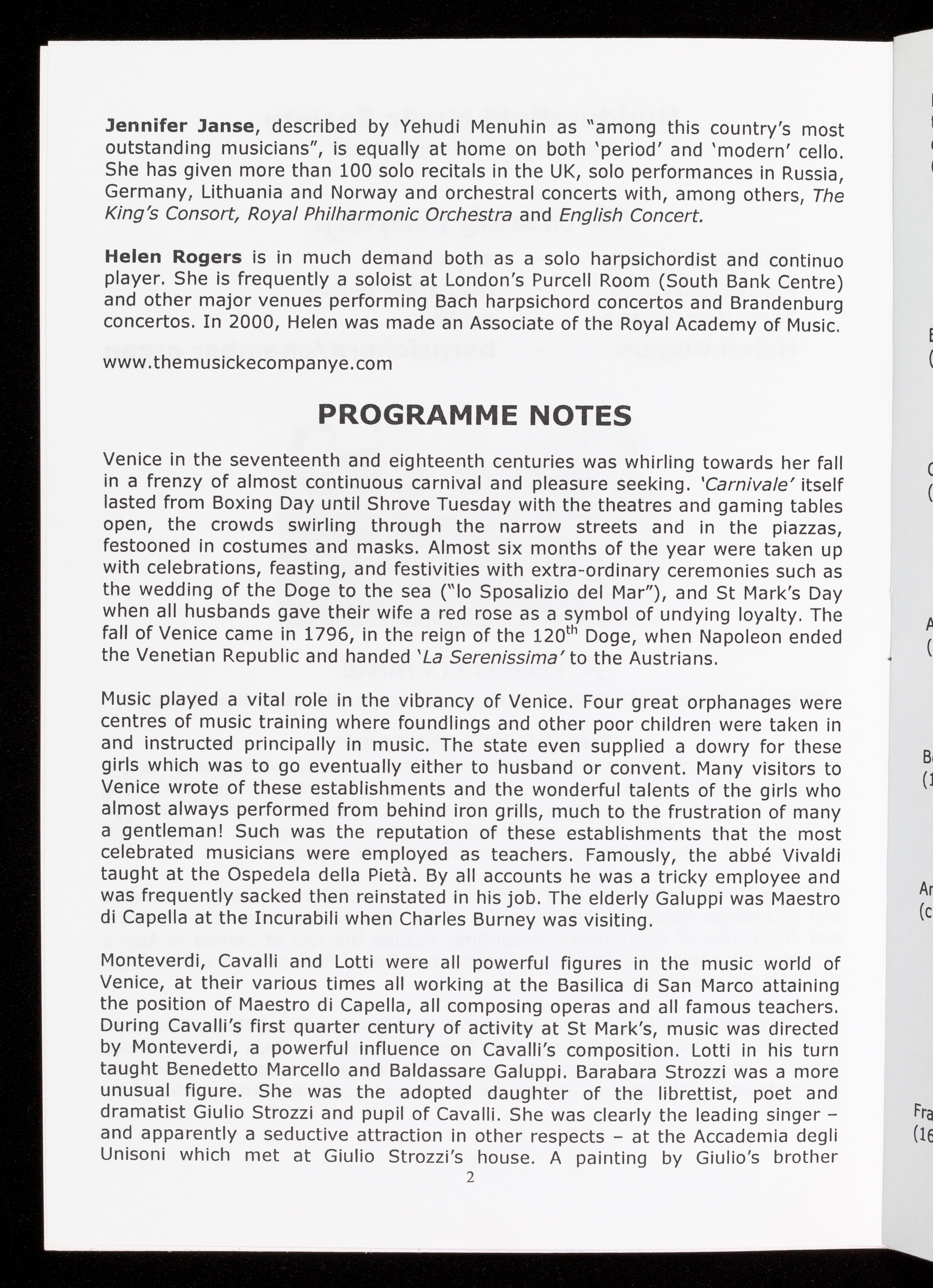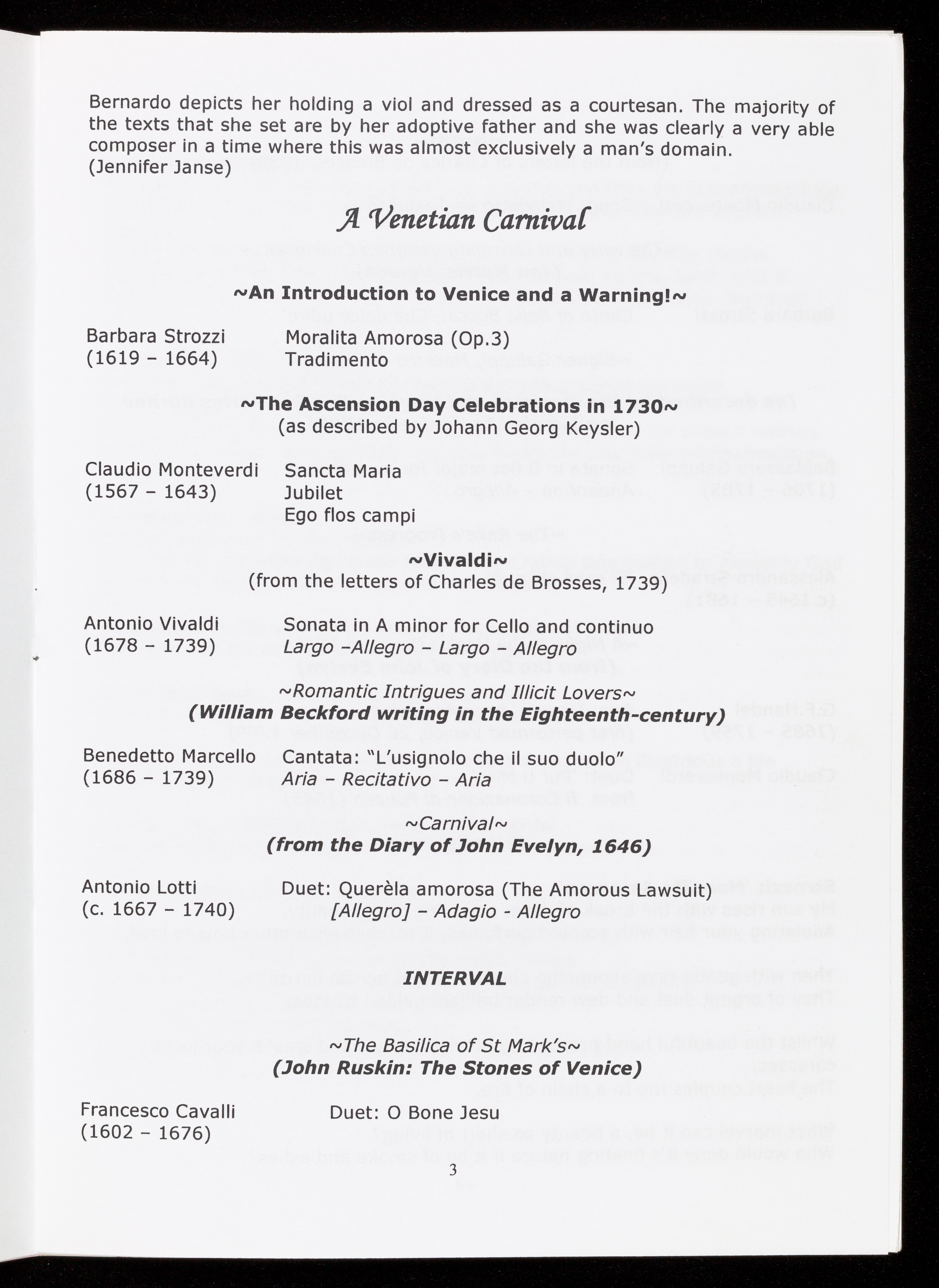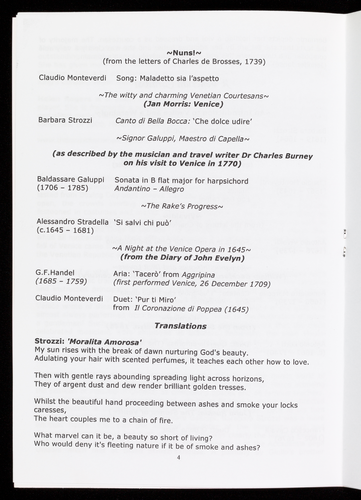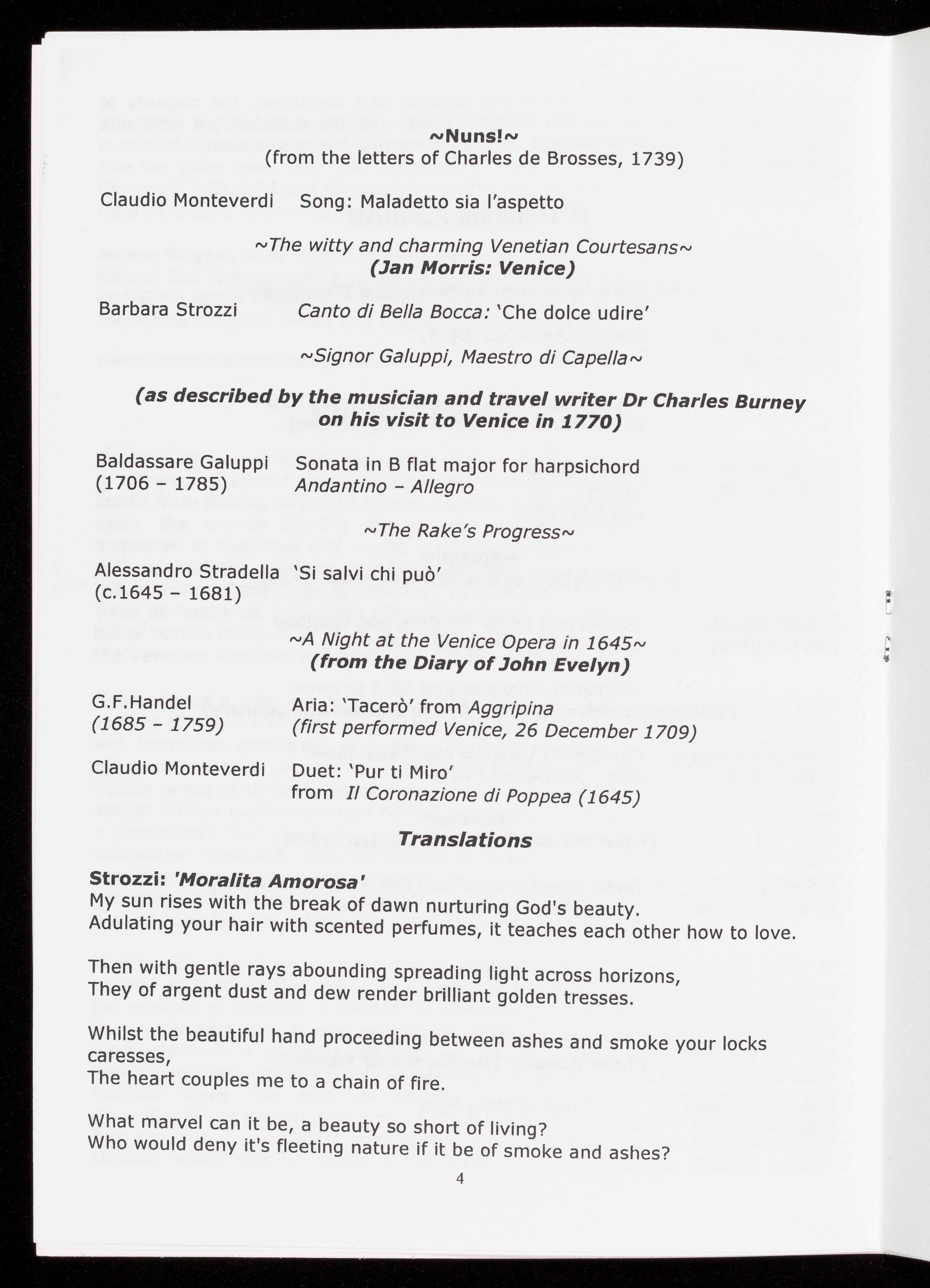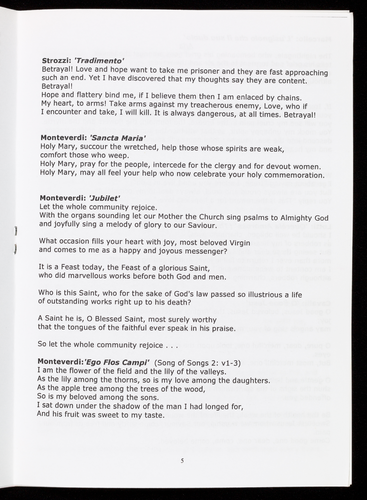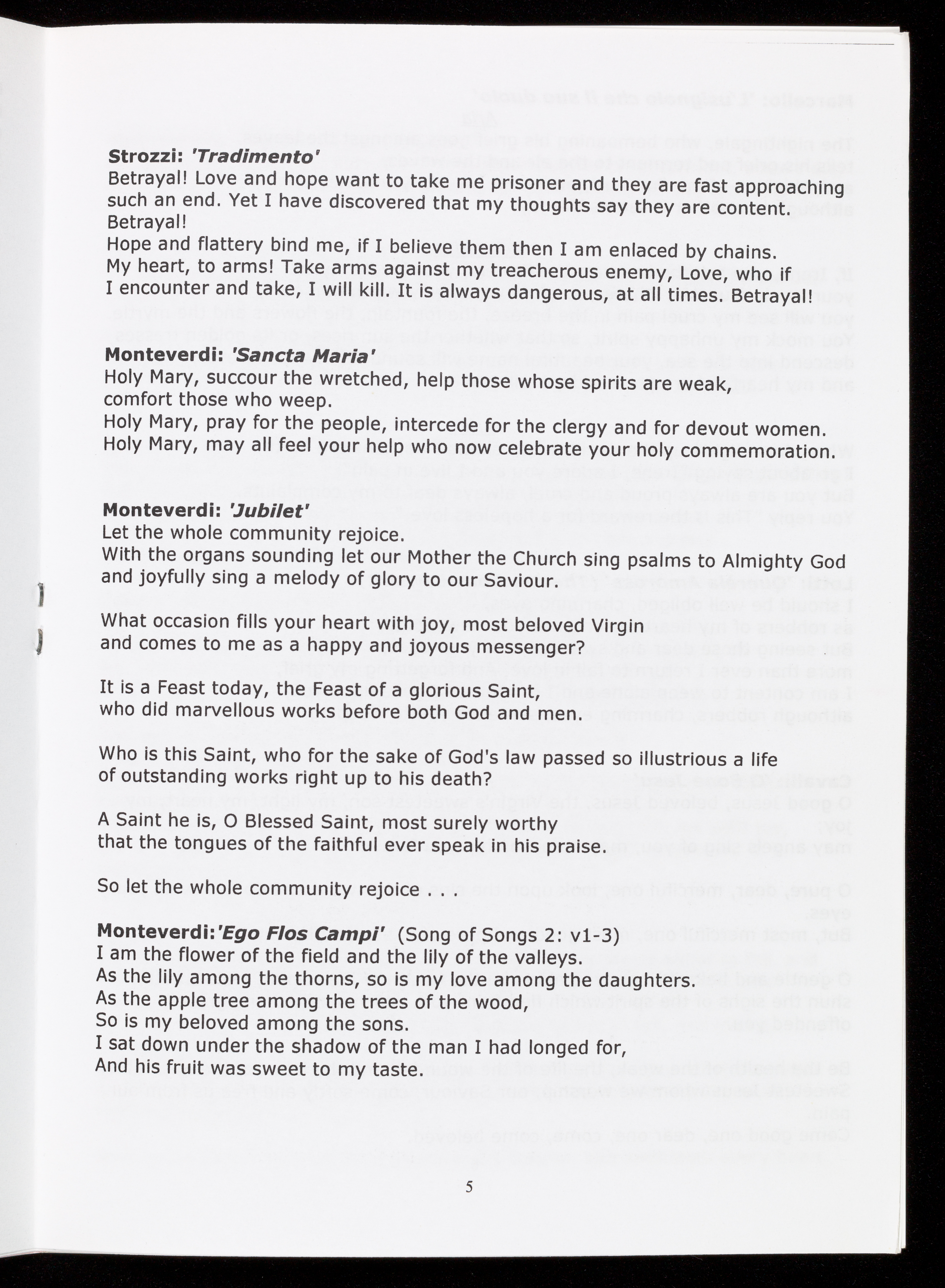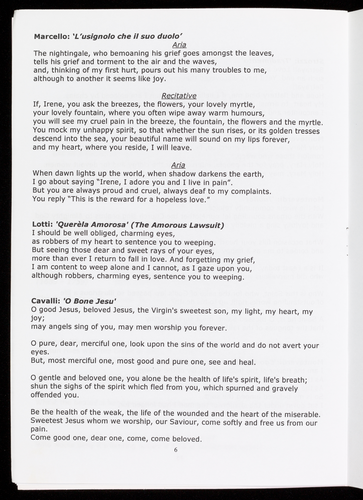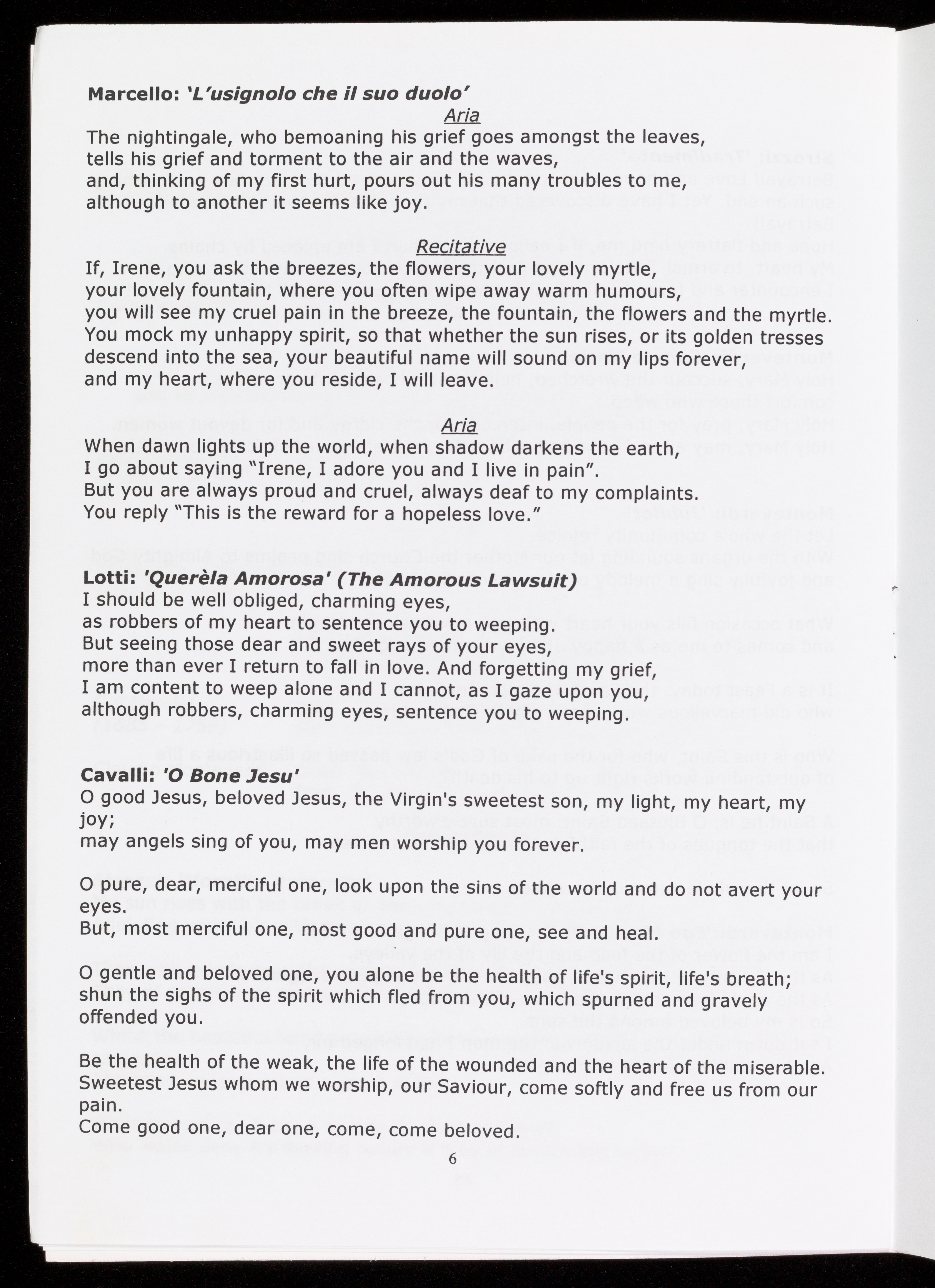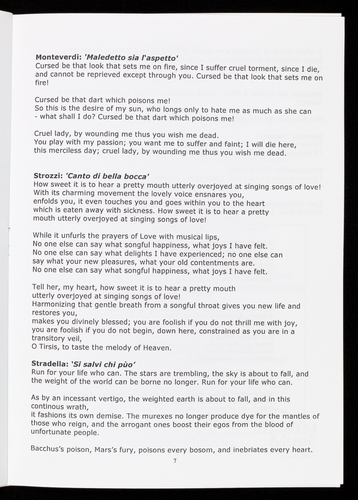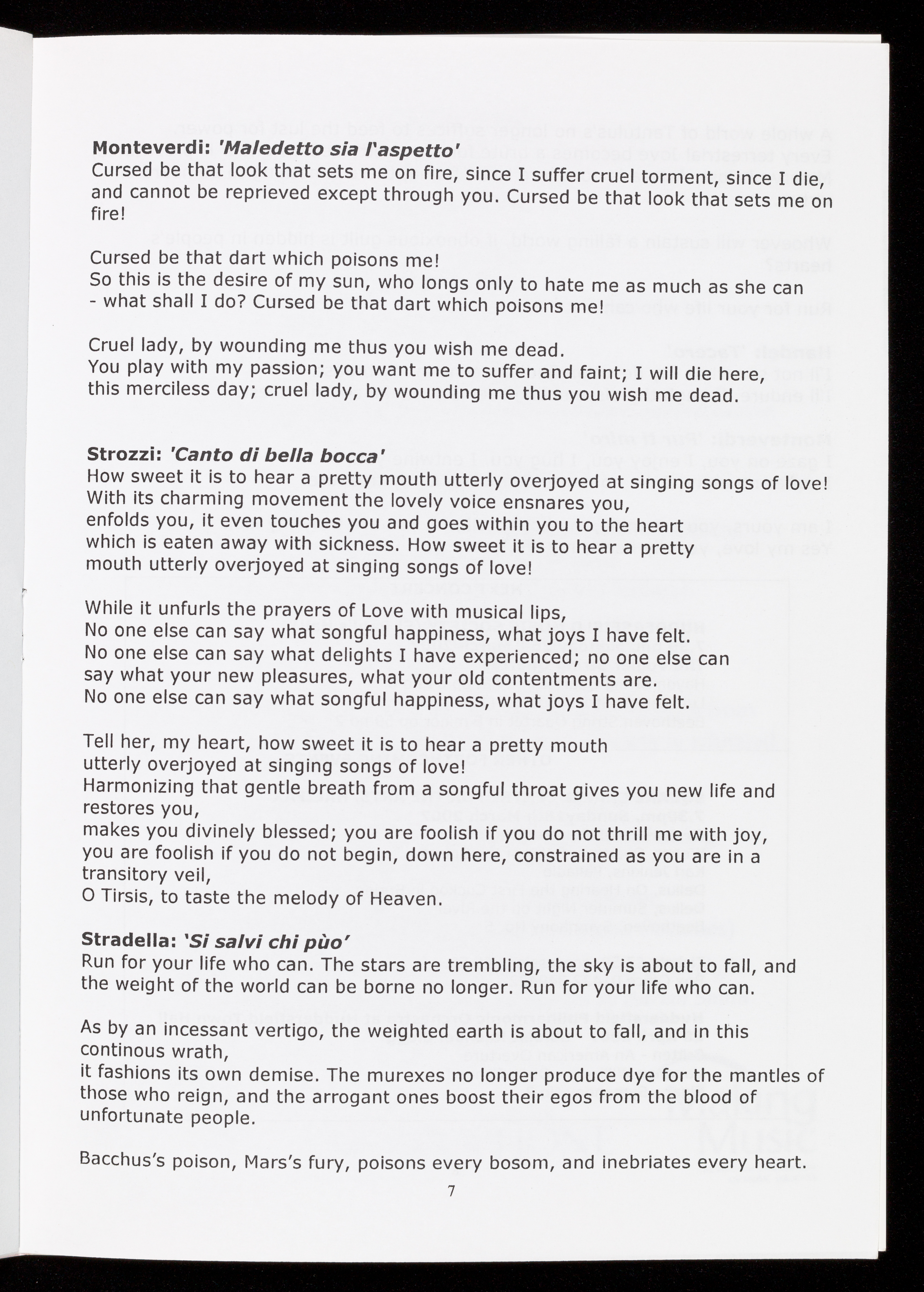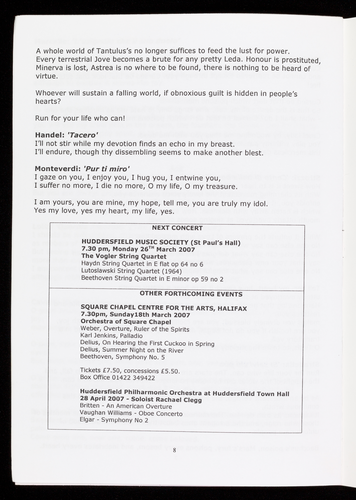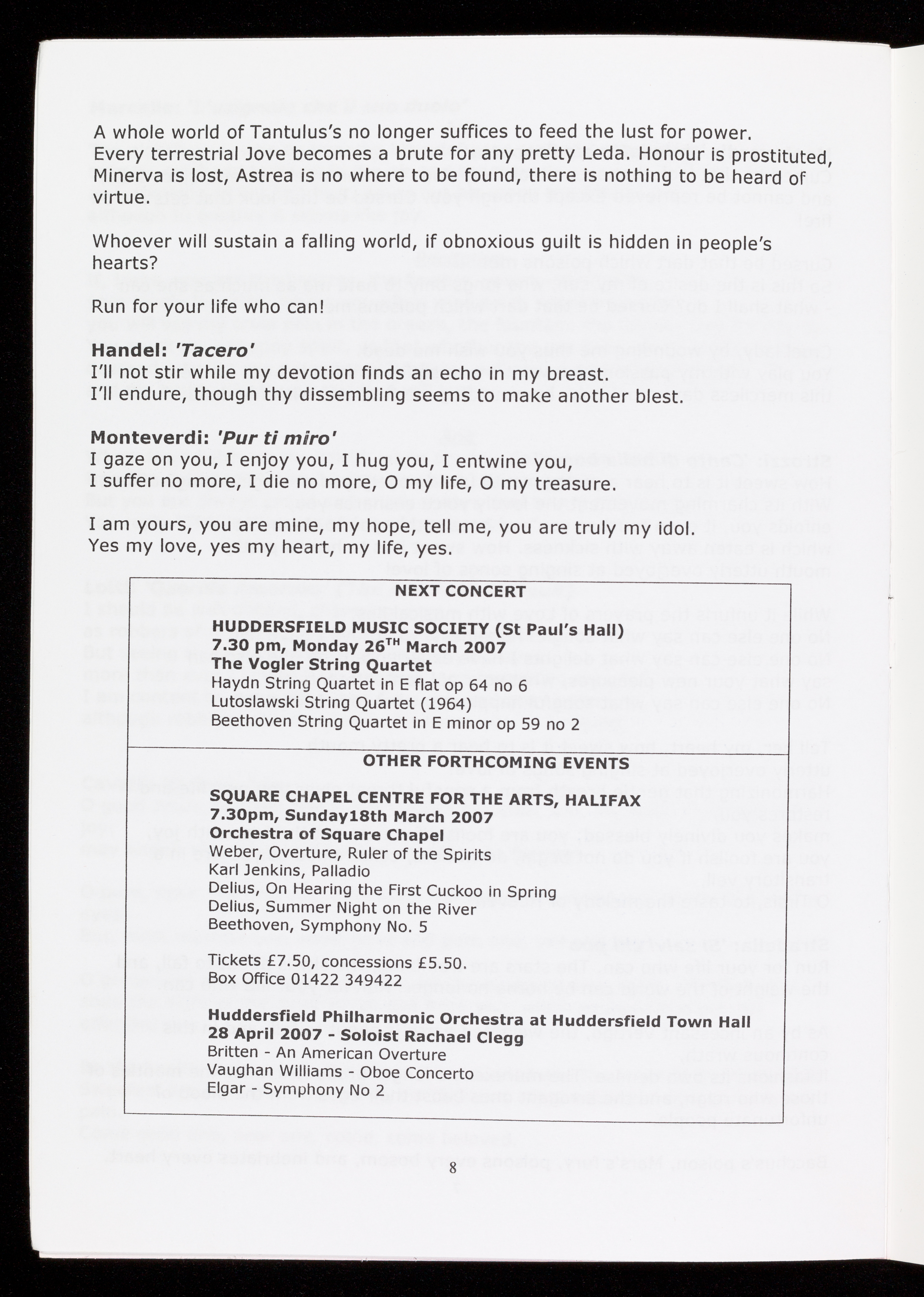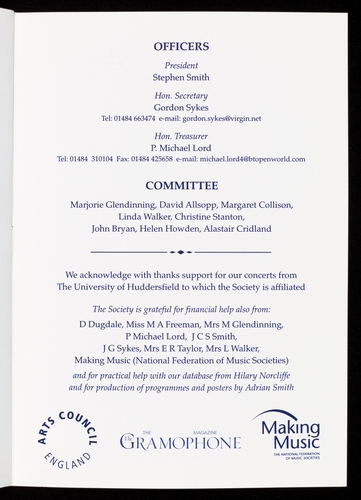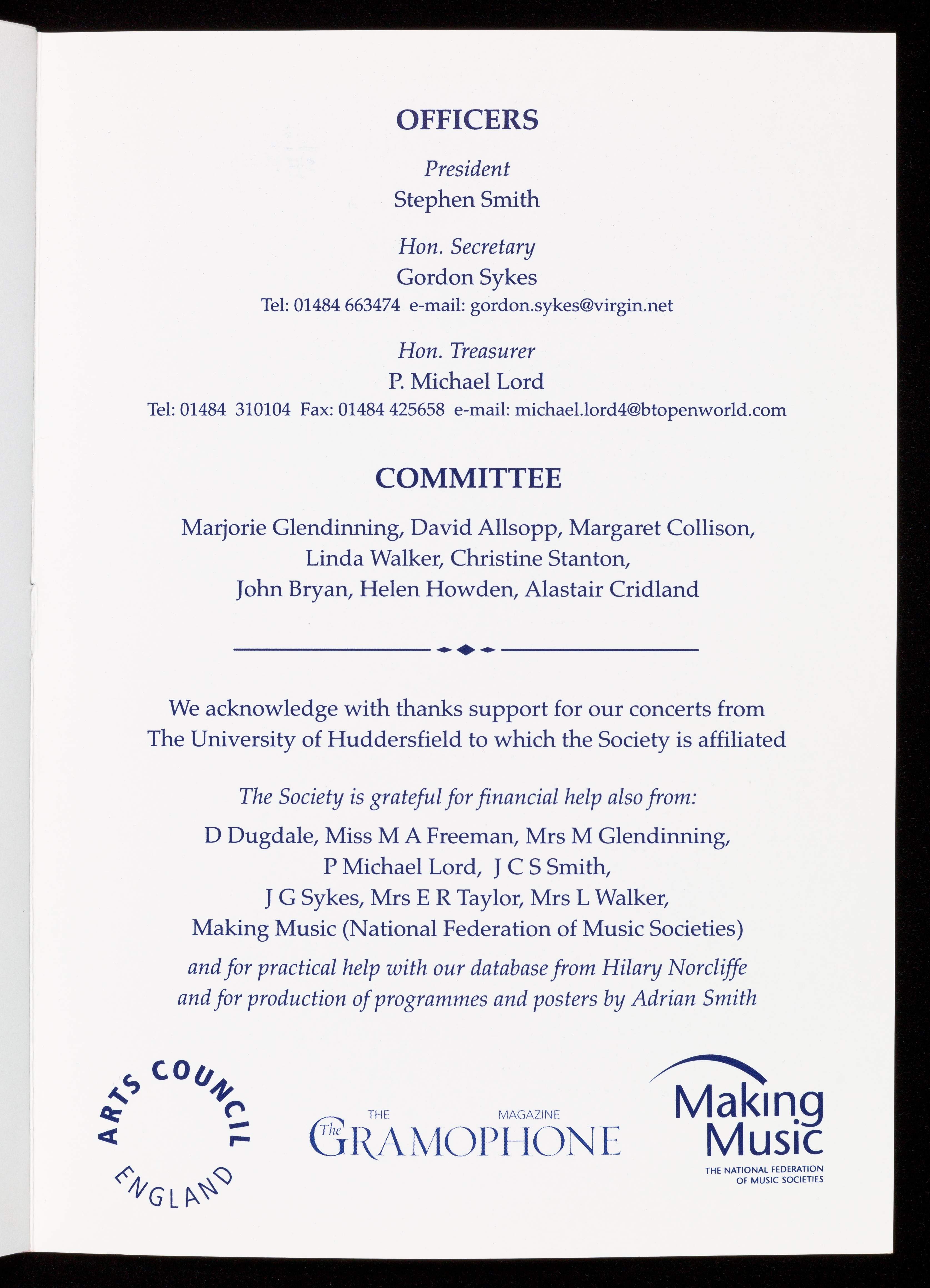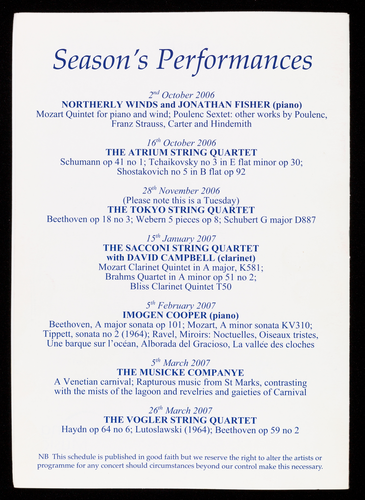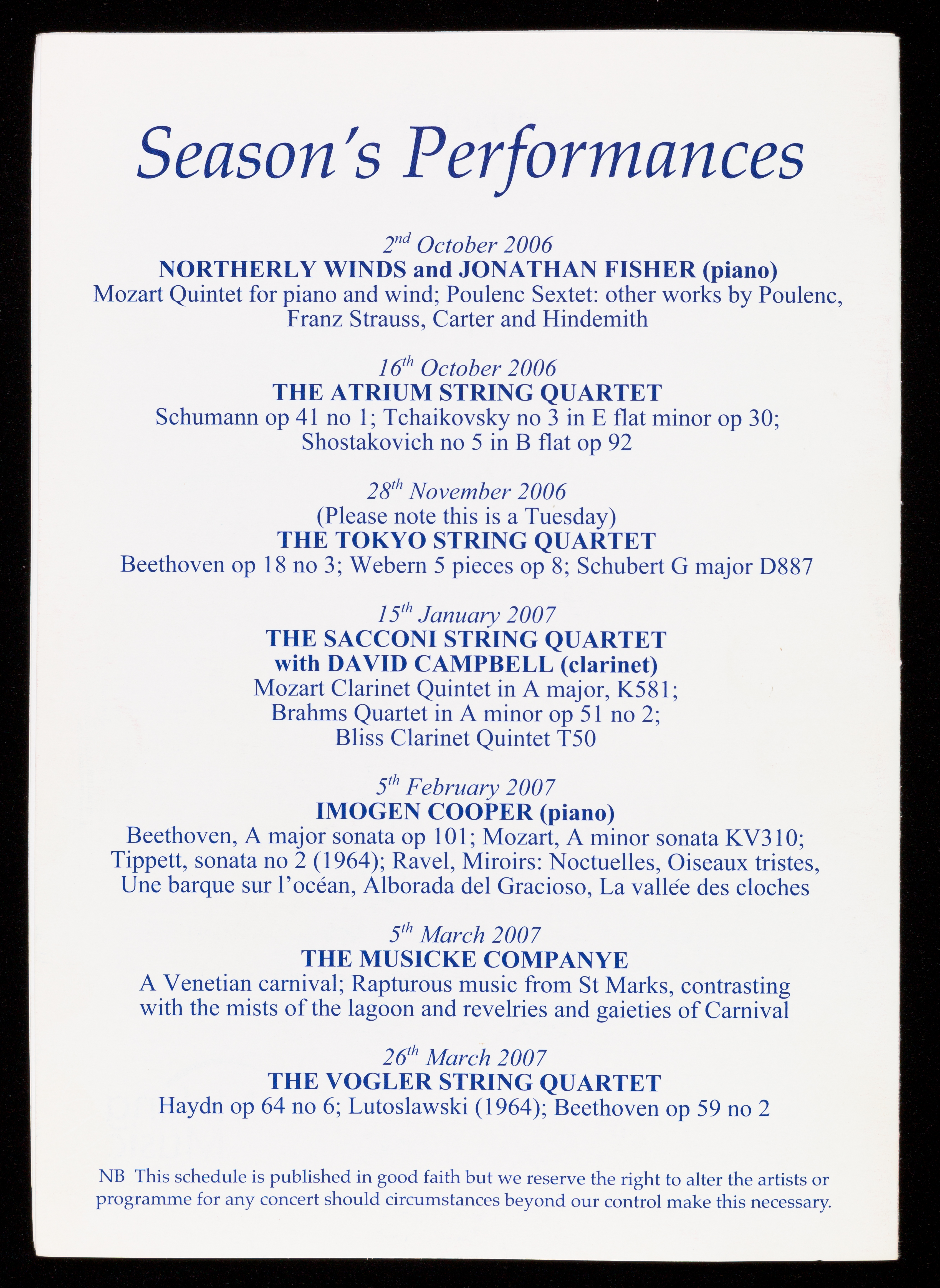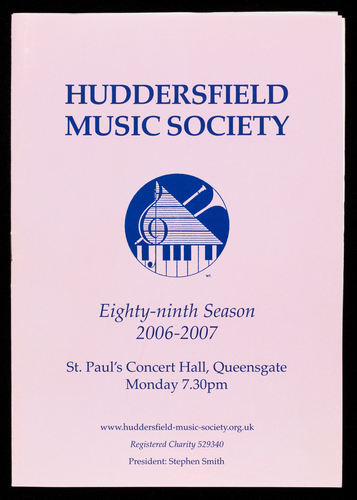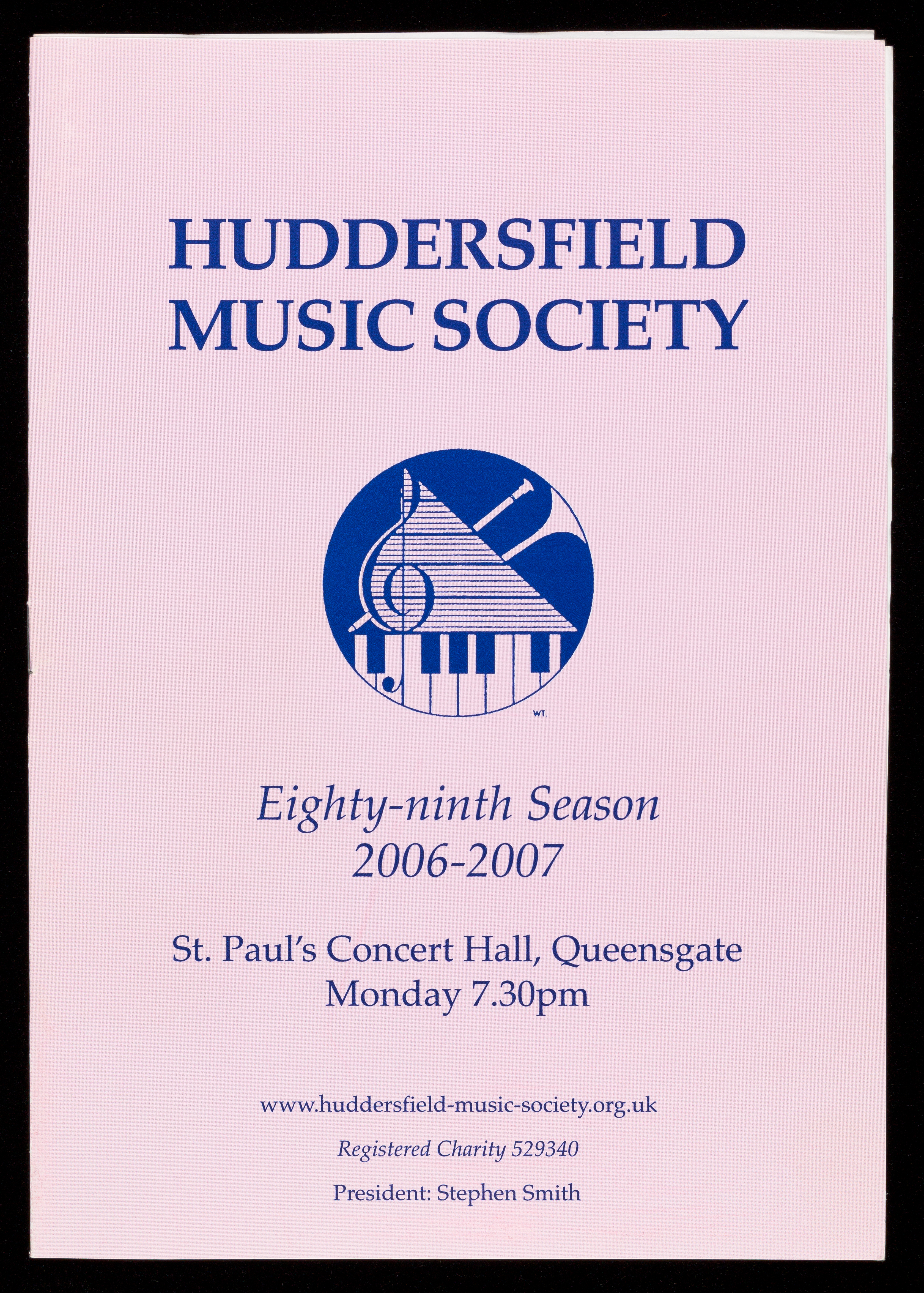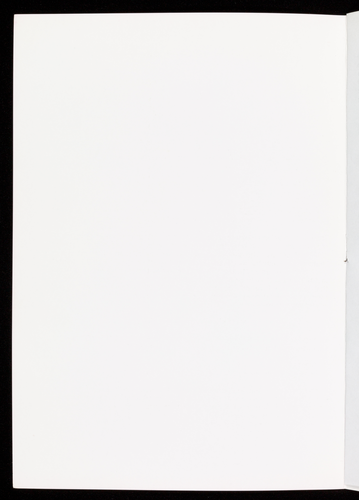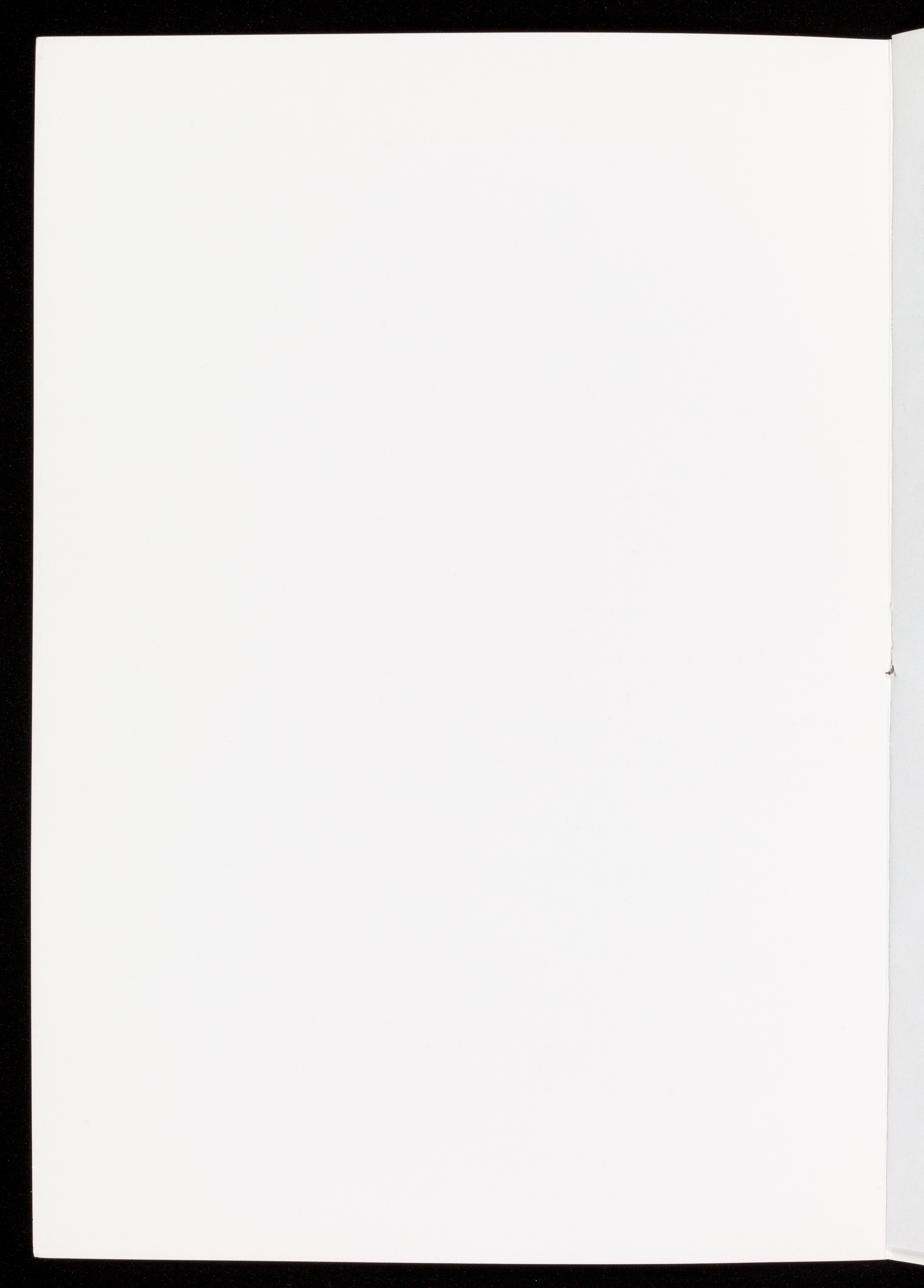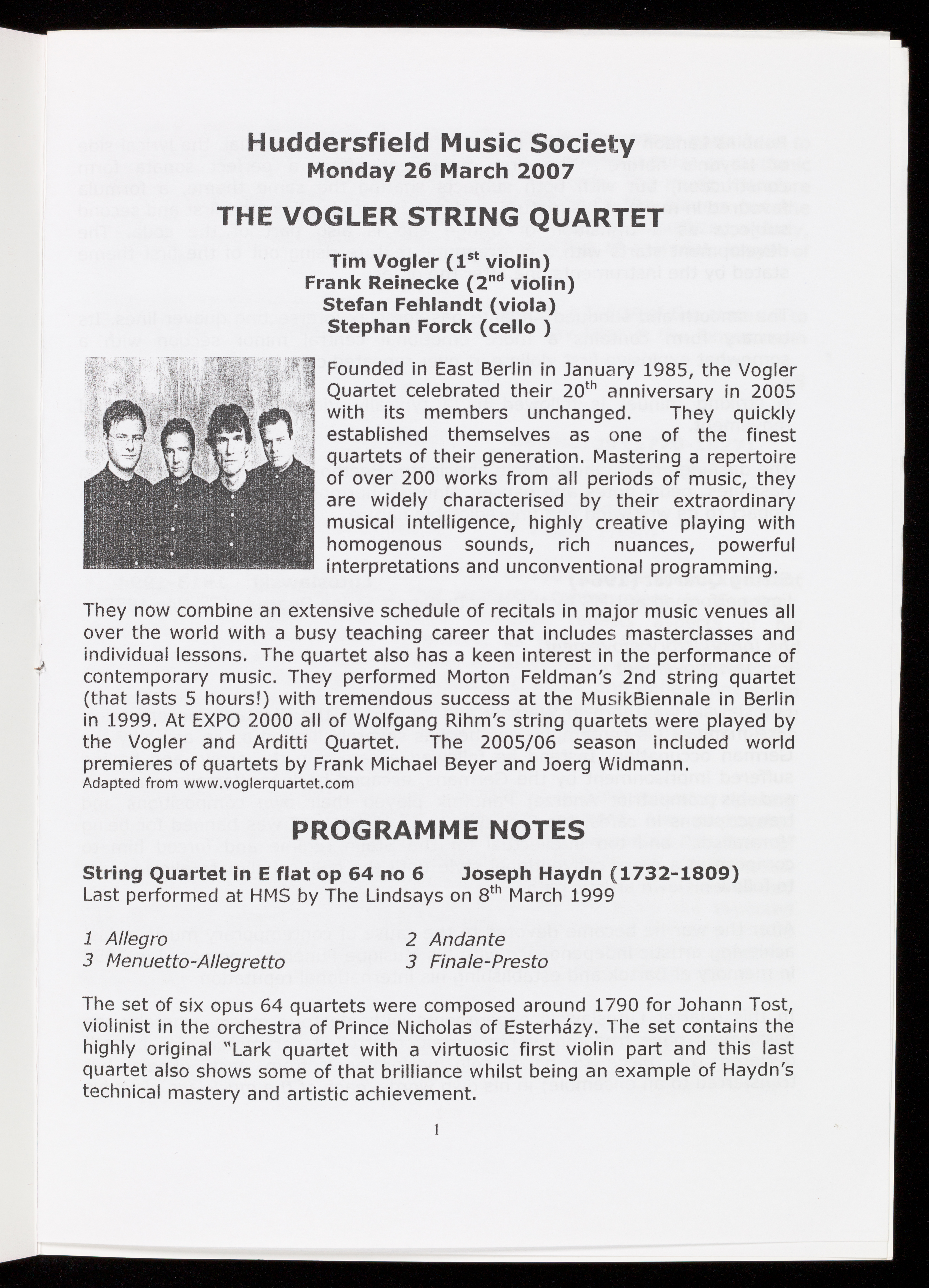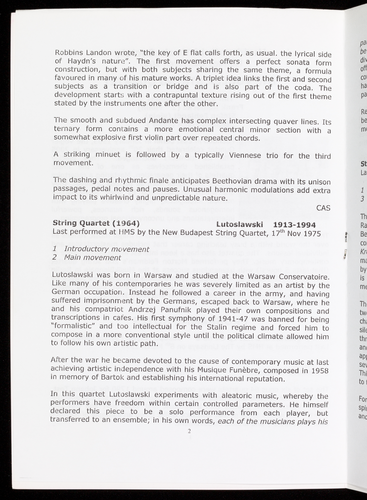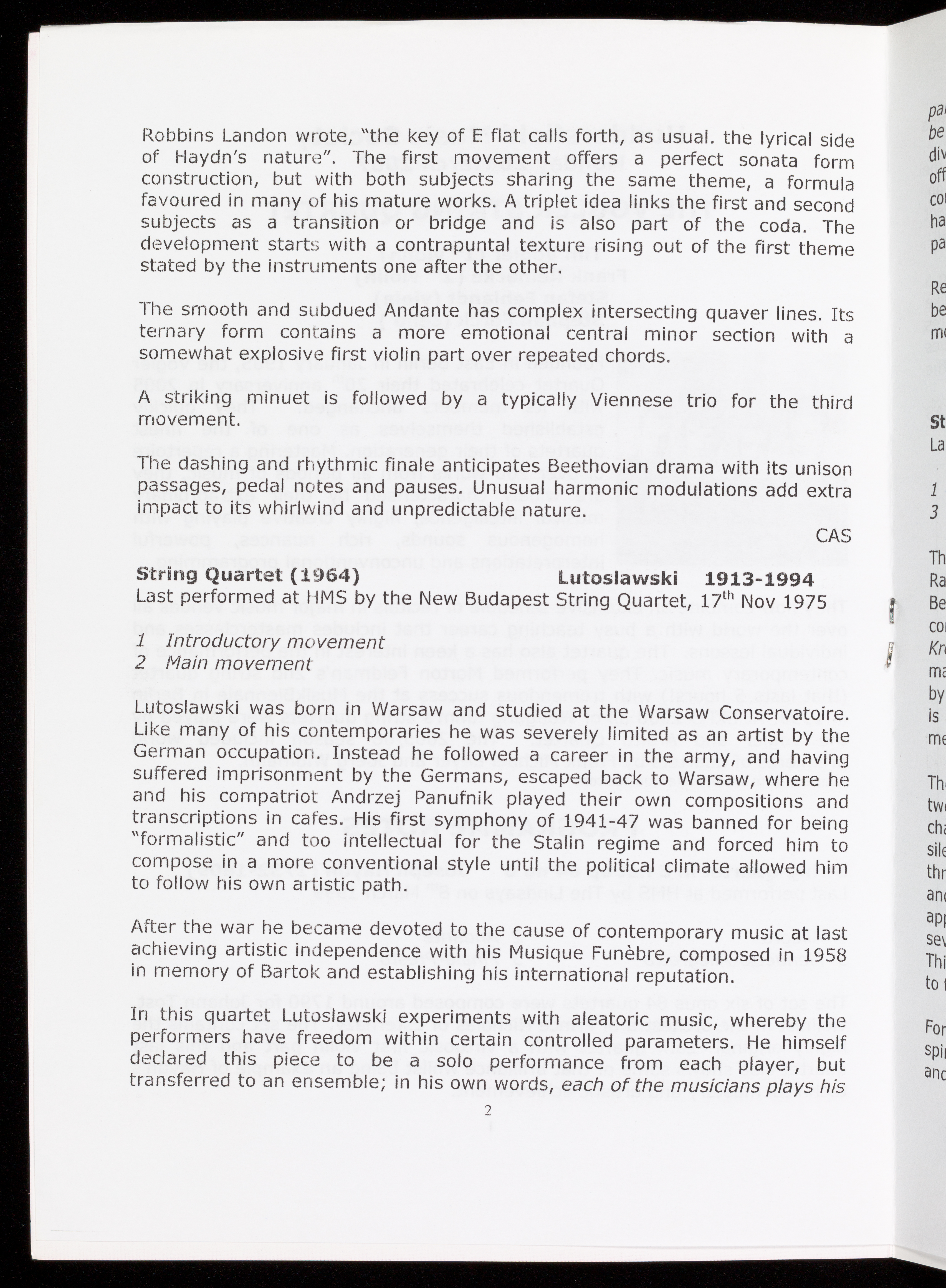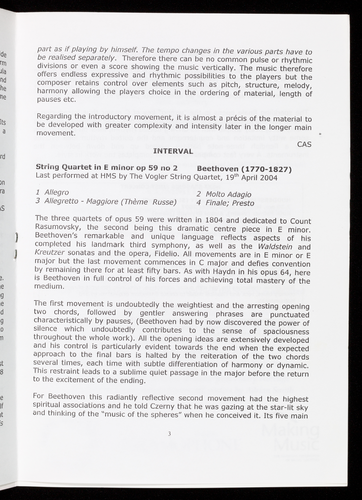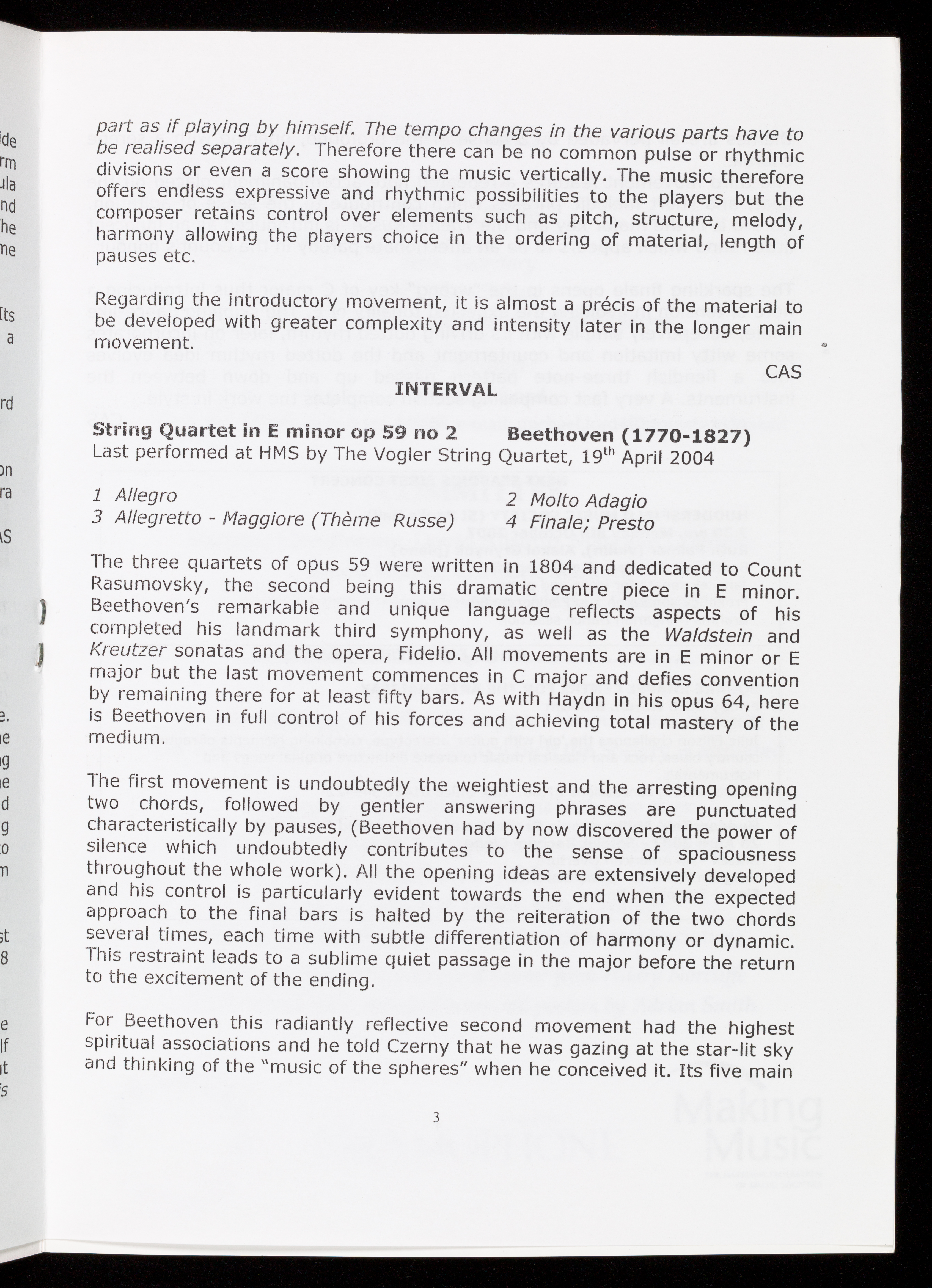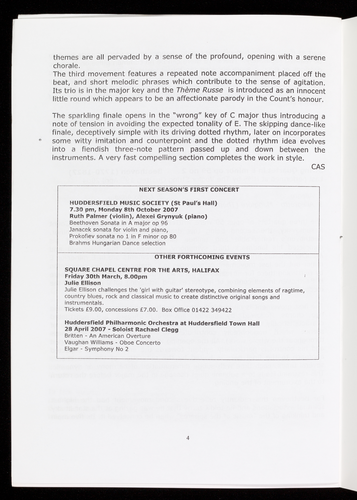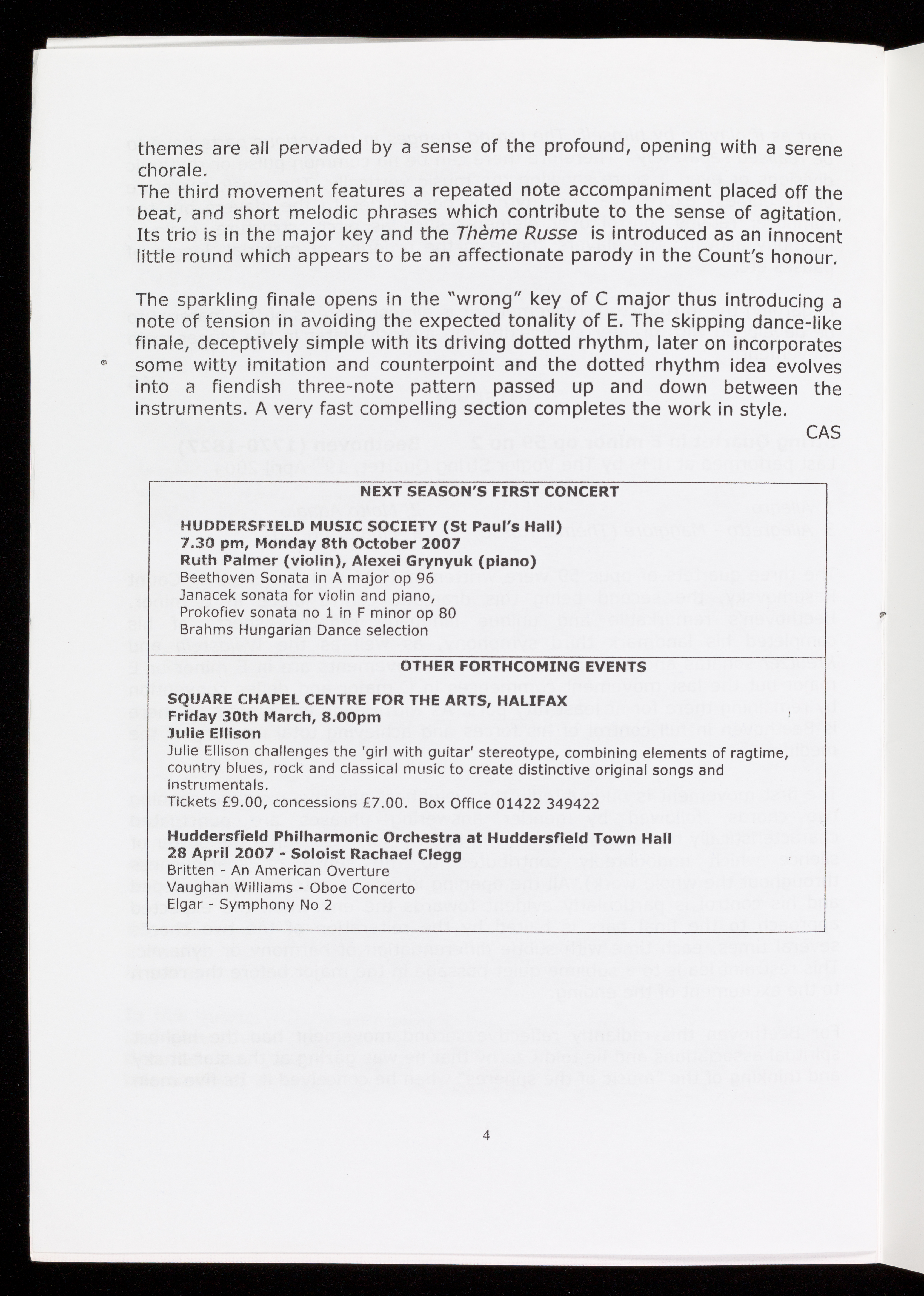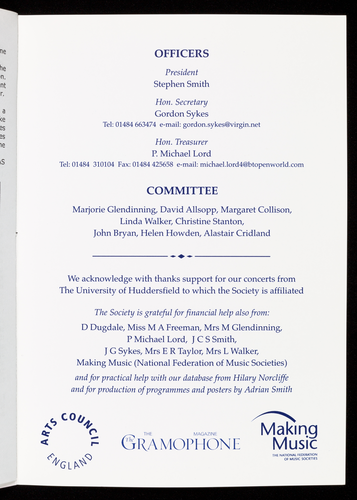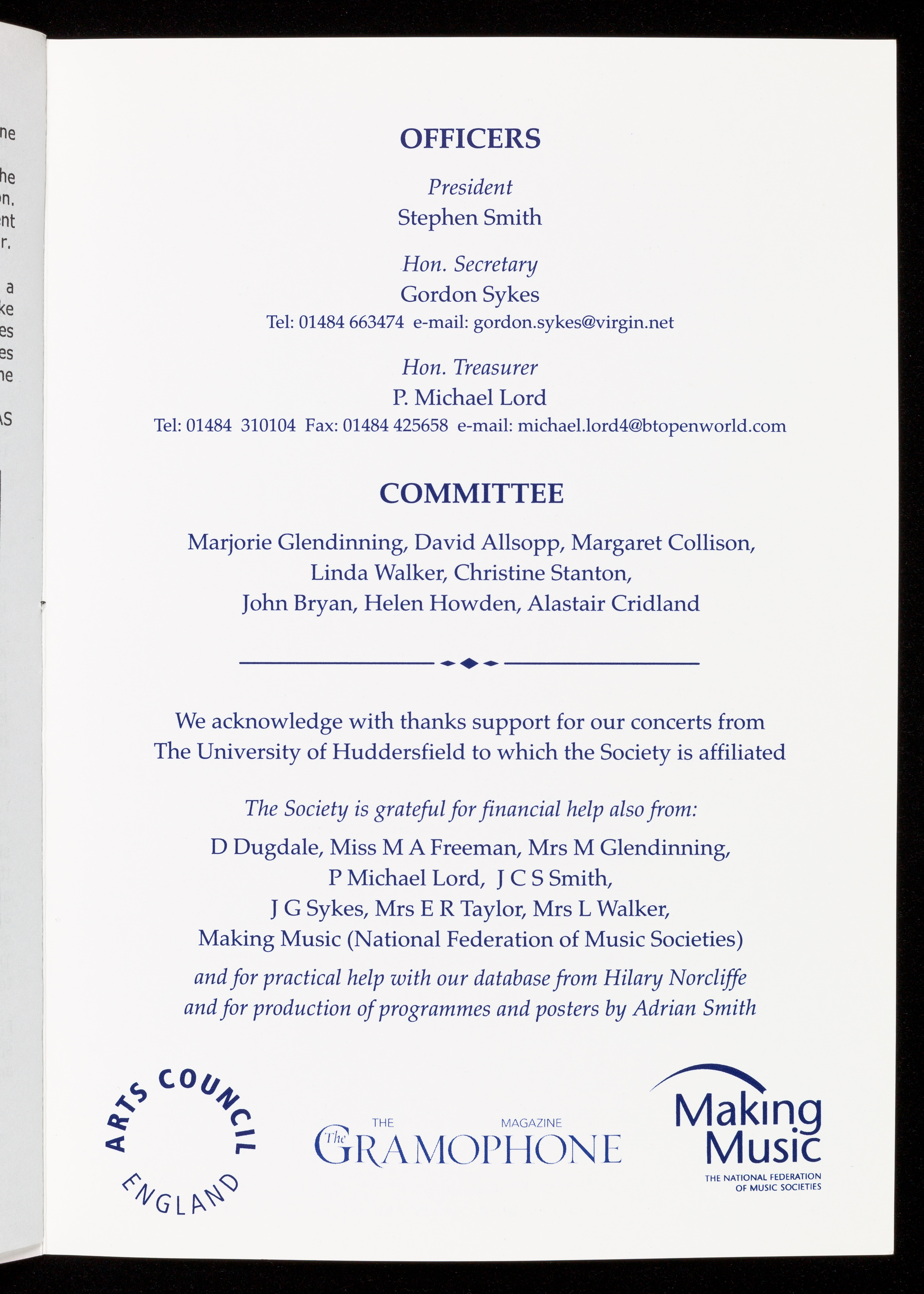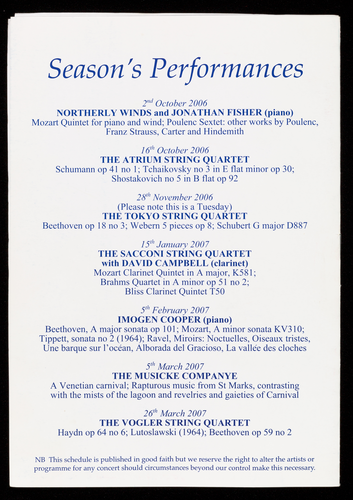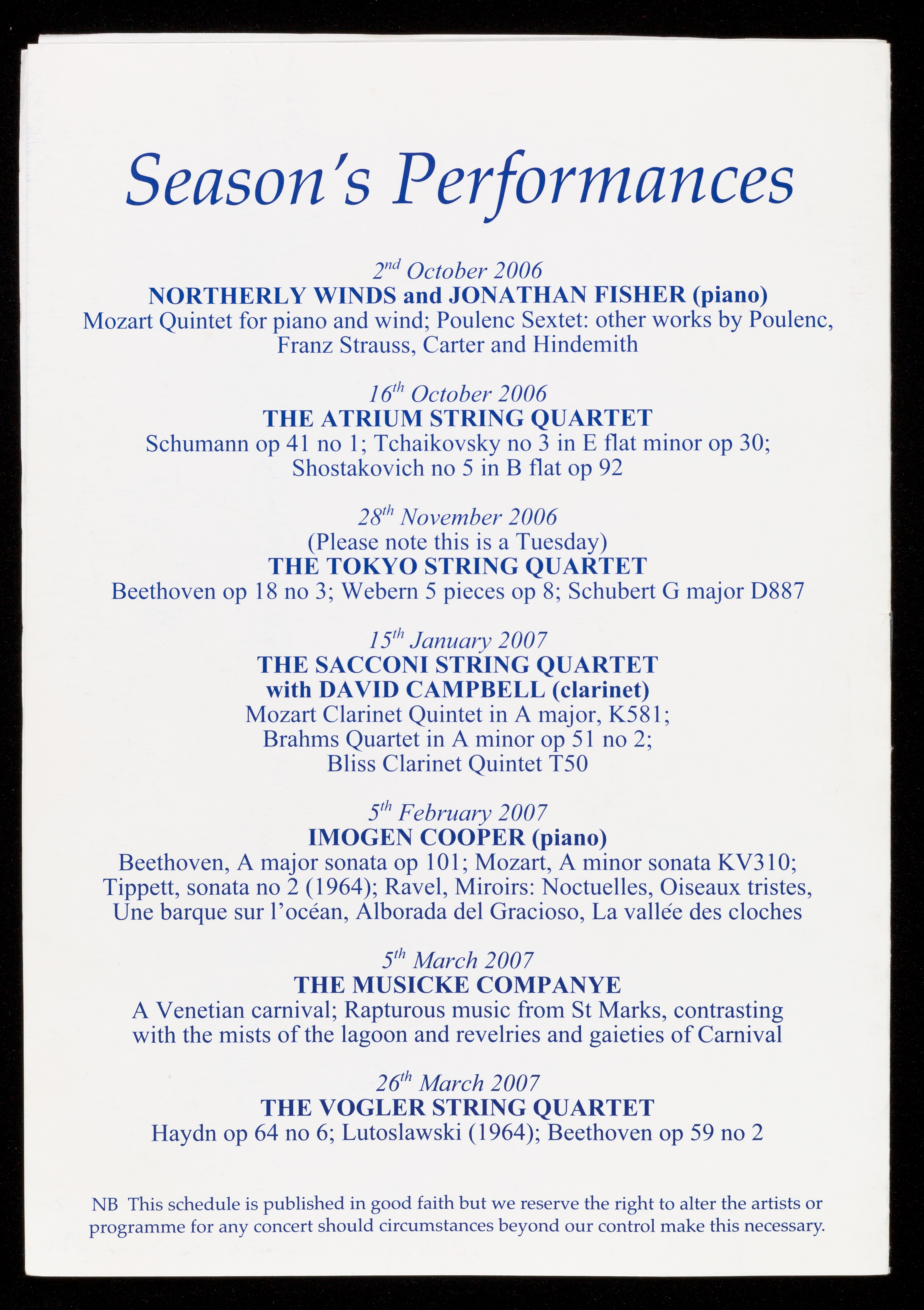Ocr'd Text:
2006-2007
Eighty-ninth
Season
10
St Paul's Hall
Huddersfield
The Atrium String Quartet
EXT
Given in association with the
'Music at the
University of Huddersfield'
Evening Concert Series
COX
Huddersfield Music Society is a
Registered Charity
HUDDERSFIELD MUSIC SOCIETY
Ocr'd Text:
Monday 2nd October 2006 at 7.30 pm
NORTHERLY WINDS and
JONATHAN FISHER (piano)
1
These enterprising young musicians from the Royal
Northern College of Music offer us an eclectic programme
with various combinations of instruments, in a programme
ranging from the 18th to the 20th centuries and including a
work by the father of Richard Strauss.
Quintet in E flat for piano and wind K452
Horn Solo
Novelette for wind quintet
Quintet
Wind Quintet
Sextet for piano and wind
Mozart
Franz Strauss
Poulenc
Hindemith
Monday 16th October 2006 at 7.30 pm
THE ATRIUM STRING QUARTET
2
This young Russian String Quartet includes in its
performance the Shostakovich string quartet which it
played in the final when winning the 2003 London
International String Quartet Competition.
String Quartet in A minor op 41 no 1
String Quartet no 3 in E flat minor op 30
String Quartet no 5 in B flat op 92
Elliot Carter
Poulenc
The Vogler String Quartet
Schumann
Tchaikovsky
Shostakovich
Sing
Dou
Stuc
Stuc
Ocr'd Text:
ramme
gamme
Poulenc
demith
Poulenc
ET
its
ndon
vich
TICKETS
Single Season Ticket
Double Season Ticket
Single Concert Ticket:
£77
£150
Concerts nos 3 and 5 £18; others £15
Student Season Ticket
Student Single Ticket
We acknowledge with thanks support from
the University of Huddersfield
to which the Society is affiliated.
£15
£3
The Society is grateful for financial help also from:
David Dugdale, Miss M A Freeman,
Mrs M Glendinning, P Michael Lord,
PL Michelson, J C S Smith, JG Sykes,
Mrs E R Taylor, Mrs L Walker and
Making Music (National Federation of Music Societies).
NB This brochure is published in good faith
but we reserve the right to alter the artists
or programmes for any concert
should circumstances beyond our control
make this necessary.
Ocr'd Text:
2006-2007
Eighty-ninth Season
TUESDAY 28th November 2006 at 7.30 pm
THE TOKYO STRING QUARTET
3:
We consider ourselves fortunate indeed to have secured a
visit from the world-famous ensemble.
4
String Quartet in D major op 18 no 3
Five pieces op 8
String Quartet in G major D 887
Y
The Sacconi String Quartet
Beethoven
Webern
Schubert
Monday 15th January 2007 at 7.30 pm
THE SACCONI STRING QUARTET
with DAVID CAMPBELL (clarinet)
Paying us a return visit, this young British Quartet joins
forces with the distinguished clarinettist David Campbell in
a performance of Mozart's sunny Clarinet Quintet and a
work by Arthur Bliss for the same combination. Their
recital is completed by one of the major works of the string
quartet repertoire.
Quintet in A for clarinet and strings K581
String Quartet in A minor op 51 no 2
Clarinet Quintet T50
Mozart
Brahms
Bliss
BOOKING ARRANGEMENTS
Single Season Ticket
Double Season Ticket
Single Concert Ticket:
Concerts nos 3 and 5 £18; others £15
Student Season Ticket
Student Single Ticket
Name
Tickets
Tickets may be obtained by using the booking form below
or from Huddersfield Information Centre, Albion Street
(tel 01484 223200), or at the door. Please return unwanted
season tickets to the Treasurer by 25th September 2006.
Address
Post this form with cheque payable to
Huddersfield Music Society
to the Hon Treasurer, Mr Michael Lord,
14 Garsdale Road, Newsome,
Huddersfield HD4 6QZ.
BOOKING FORM
Please send
single/double season tickets
Please send .......... single concert tickets
for concert number(s)
Postcode
Tel 01484 310104
Fax 01484 425658
E-mail michael.lord4@btopenworld.com
.......
£77
£150
.....●●●●●●
Telephone
£15
£3
Total £
I enclose cheque
Would Double Season Ticket holders please add the name
of the second purchaser for our membership register:
Ocr'd Text:
Monday 5th February 2007 at 7.30 pm
IMOGEN COOPER (piano)
5
Born in London, Imogen has achieved an enviable
international reputation, and her recital will be keenly
anticipated.
Sonata in A major op 101
Sonata in A minor KV 310
Sonata no 2 (1964)
Mirroirs
Monday 5th March 2007 at 7.30 pm
THE MUSICKE COMPANYE
6
In a programme entitled "A Venetian Carnival" these artists
devised a programme of rapturous music from St Marks,
contrasting with the mists of the lagoon and revelries and
gaiety of the Carnival.
Beethoven
Mozart
Tippet
Ravel
Works by Monteverdi, Cavalli, Lotti, Strozzi, Marcello,
Handel and others, interwoven with tales of love, intrigue
and murder.
The Tokyo String Quartet
Imogen Cooper
Monday 26th March 2007 at 7.30 pm
THE VOGLER STRING QUARTET
7
Paying us a return visit this well-established German
Quartet brings our season to a fitting close with a twentieth
century quartet surrounded by two mainstream classics of
the Repertoire.
String Quartet in E flat op 64 no 6
String Quartet (1964)
String Quartet in E minor op 59 no 2
Haydn
Lutoslawski
Beethoven
HUDDERSFIELD
MUSIC SOCIETY
Season 2006-2007
BOOKING FORM
(to be detached)
Ocr'd Text:
A629
HUDDERSFIELD
NEW NORTH ROAD
ROADO
MUSIC SOCIETY
Making
Music
www.huddersfield-music-society.org.uk
President
Stephen Smith
Honorary Secretary
Mr Gordon Sykes
Tel: 01484 663474
E-mail: gordon.sykes@virgin.net
TO HALIFAX
& M62
THE NATIONAL FEDERATION
OF MUSIC SOCIETIES
TRINITY STREET
NORTH
11830
CASTLE GATE
STATION
BUS
A62 MANCHESTER ROAD
TO MANCHESTER
SOD
Car parking should be
RAILWAY STATION
A616 CHAPEL HILL
1009
00G00
Yorkshire Arts
00
001
COL
300
QUEESNGATE
CAR PARK
CHINOS IS N
SOUTHGAT
TO LEEDS
QUEENS
LEEDS ROAD A62
available across
St Paul's Hall for a small fee.
TO WAKEFIELD
& SHEFFIELD
4629 WAKEFIELD ROAD
ST. PAUL'S HALL
UNIVERSITY OF
HUDDERSFIELD
Queensgate from
The car park is lit and attended.
The concerts usually end at about 9.30 pm.
Ocr'd Text:
HUDDERSFIELD
MUSIC SOCIETY
1
WI.
Eighty-ninth Season
2006-2007
St. Paul's Concert Hall, Queensgate
Monday 7.30pm
www.huddersfield-music-society.org.uk
Registered Charity 529340
President: Stephen Smith
Ocr'd Text:
Huddersfield Music Society
Monday 2 October 2006
NORTHERLY WINDS and
JONATHAN FISHER, piano
Northerly Winds
Claudia Lashmore / flute
Anna Barton / oboe
Matthew Dunn / clarinet
Simon Davies / bassoon
Stephanie Jones / french horn
Northerly Winds formed in 2002 and
have since given a number of concerts
in the Northwest, including
performances at the Heron Theatre in
Kendal, Flixton House and Gallery
Oldham. In March 2003 they were
finalists in the Trevor Wye Competition and in 2004 they went on to win the first
prize. They were also awarded a Professional Performance Certificate (PPRNCM) from
the Royal Northern College of Music.
Anna Barton / oboe completed her BMus degree at the Royal Northern College of
Music studying the oboe with Melinda Maxwell and Jonathan Small and the cor anglais
with Tom Davey. Anna has played with The Amadeus Orchestra, Yorke Trust Opera,
the Sweelinck Ensemble, the Kings Consort and Sinfonia Cymru.
Matthew Dunn / clarinet completed his post graduate diploma, studying with
Chris Swann and John Bradbury at the RNCM. Matthew has had partic success in
chamber music, winning the RNCM Woodwind Chamber Music Prize and the Maime
Woods / Candlin Wind Instrument Prize with the Carter Wind Quartet.
Simon Davies / bassoon began playing the bassoon at the age of 12. After
studying for two years with Laurence Perkins, he won an entrance award to the Royal
Northern College of Music. In 2003 Simon was awarded the Martin Hardy Bassoon
Prize and in 2004 he won the Maime Woods / Canadin Instrumental Prize.
Stephanie Jones / horn gained a first class BMus degree at the Royal Northern
College of Music, studying with Julian Plummer, Frank Lloyd and Beccy Goldberg. As
well as playing in many of the college ensembles she has also worked with the Hallé,
the BBC Philharmonic Orchestra, Opera North, Sinfonia Cymru, Welsh Chamber
Orchestra, Mowbray Chamber Orchestra and the Macau Chamber Orchestra in China.
Jonathan Fisher / piano graduated from The University of Huddersfield in 2001
with First Class honours. As concerto soloist Jonathan has performed with the
Huddersfield Philharmonic and Blackpool Symphony Orchestra and currently holds the
position of Junior Fellow in Accompaniment at the RNCM.
Northerly Winds and Jonathan appear by kind permission of the Royal Northern
College of Music, www.rncm.ac.uk
1
Ocr'd Text:
PROGRAMME NOTES
by C.A Stanton, Huddersfield Music Society.
The timing of the interval will be announced
Quintet in E flat for piano and wind K 452
Largo-Allegro moderato Larghetto Allegretto
This work was completed in 1784 when Mozart had written his first sixteen piano
concertos. It illustrates his brilliance in balancing the fortepiano against the orchestra
although in this quintet the keyboard is perhaps more of a partner than protagonist to
the other players.
Mozart 1756-1791
The wonderfully eloquent slow introduction is introduced by the piano and swiftly
taken up by the other instruments in skilful counterpoint. The following allegro section
has two subjects, of which the first is lyrical and the second more rhythmically
interesting. The themes are rearranged in the recapitulation, which is reached after
several false starts.
In the second movement the wind players converse in different groupings against a
piano part of broken chords and arpeggios. Its central section of contrasting material
visits more remote keys before returning to the restrained emotion of the opening.
A simple rondo theme, later to be re-scored in subsequent appearances, is presented
first by the piano, next by the wind instruments and finally by the entire ensemble.
The independence and equality of the wind instruments is always apparent, as is the
exploitation of their individual timbres. Two contrasting episodes appear between
repeats of the rondo theme, of which the second is of an altogether more sombre
nature, propelled by the darker colours of the horn and bassoon. A dramatic build-up
to a highly unusual and original cadenza precedes the final theme and coda.
Horn Solo
Franz Strauss 1822 - 1905
Franz Strauss was the father of Richard Strauss and a horn player, whose legacy is
greatest as a teacher - "Only by sustaining tones and by interval studies can you
achieve a noble tone." This concern for tone must have been a significant element of
his success as a horn player and is certainly reflected in his compositions.
Novelette for Wind Quintet Francis Poulenc 1899 - 1963
Poulenc was part of Les Six, a group of composers in the twenties who created their
music from more popular and accessible French forms, rejecting the cumulative effect
of Germanic Romanticism and more serious side of French music.
This is a playable and lyrical little piece written in 1963, to be enjoyed and not taken
too seriously.
2
Ocr'd Text:
Quintet op 24 no 2
1 Lustig, Mässig schnelle Viertel
2 Walzer, Durchweg sehr leise
3 Ruhig und einfach
4 Schnelle Viertel
5 Sehr lebhaft
Hindemith was an influential composer and theorist of the twentieth century. He was
an active violist, conductor and teacher, holding firm views that music should be
accessible to all, both in playing and listenings. Bach was a source of inspiration for
him and he used many fundamental techniques and forms of the Baroque in his early
works. The Kleine Kammermusik für fünf Bläser, written in 1921, is part of a set of
compositions entitled Kammermusik, which include a suite and various concertos.
Hindemith 1895-1963
The first movement is high-spirited and begins with an important rhythmic motif,
which is scarcely absent throughout. A whimsical bassoon introduces a brief
contrasting episode.
An appealing little waltz allows instruments idiosyncratic expression in the second
movement.
The opening to the third movement, highly reminiscent of Ravel's second Daphnis and
Chloe suite, leads to rich harmonic sequences and textures. Its middle section
accompaniment features high-pitched detached chords playing a variation of the
opening rhythmic idea, above and below which oboe and bassoon play.
The extremely short fourth movement seems solely to announce and prepare for the
final movement which is a kind of march, where the wind writing shows affinity with
Stravinsky, particularly in its boisterously dissonant conclusion.
Wind Quintet Elliot Carter 1908 -
1 Allegretto
2 Allegretto giocoso
Born in New York, Elliott Carter was always interested in the works by Schöenberg,
Berg and Stravinsky. Like many other composers who went on to become famous, he
studied with Nadia Boulanger in Paris in the early thirties, later pursuing a very
individual brand of composing and rejecting the more
Sextet for Piano and Wind Francis Poulenc 1899-1963
Andante
Allegro
Vivace
Allegro animato
Francis Poulenc was one of "Les Six"- the group of French composers who sought to
bring humour, clarity and lyricism back into music, in opposition to the more serious
Impressionist approach of Debussy and his followers. The sextet was originally
written in 1932, but for some reason Poulenc was dissatisfied with it and rewrote it
seven years later.
3
Ocr'd Text:
The first movement consists of two outer sections full of wit and gaiety, and between
them a slow lyrical passage, preluded by a long solo for the bassoon. This movement
includes recollections from Poulenc's satirical cantata, "Le Bal Masque".
The layout of the second movement is the exact opposite of the first; a fast humorous
section framed by passages of great lyrical beauty.
The finale is a rondo with a spiky, irreverent main theme. In the closing pages
however, the music reverts to a mood of quiet meditation.
This note was written by the late Ian Emberson
NEXT CONCERT
HUDDERSFIELD MUSIC SOCIETY (St Paul's Hall)
7.30 pm, Monday 16th October 2006
The Atrium Quartet
String quartet in A minor op 41 no
String quartet no 3 in E flat minor op 30
String quartet no 5 in B flat op 92
SOME OTHER FORTHCOMING EVENTS
Huddersfield Philharmonic Orchestra at Huddersfield Town Hall
11 November 2006 - Featuring The Gould Piano Trio
Brahms - Tragic Overture
Beethoven - Triple Concerto
Sibelius- Karelia Suite
Shostakovich - Symphony No 9
St Paul's Hall, University of Huddersfield
Lunchtime concert Admission free
Thursday 5 October
1:15 pm
Piano Music at Lunchtime - Philip Thomas - piano
Cage - Music for Marcel Duchamp Cage - Seven Haiku
Satie - Nocturnes
-
Schumann
Tchaikovsky
Shostakovich
Wolff - Eight Days a Week variations
Lely - From the English
Ives - The Seen and Unseen
4
Tickets from the Department of Music
T: (01484) 472426
E: livemusic@hud.ac.uk
£6 (adults); £3 (concessions)
Harrison - etre temps
Skempton - Of Late
St Paul's Hall, University of Huddersfield
Concert
Monday 9 October 7:30 pm
Les haulzs et les bas
Alta Danza: music for a loud dance band c1450-1550
Gesine B,,nfer and Ian Harrison - Shawms, bombards, bagpipes
Marie Garnier-Marzullo - Slide Trumpet
Christian Braun - Slide trumpet, sackbut
Ocr'd Text:
Hon. Treasurer
P. Michael Lord
Tel: 01484 310104 Fax: 01484 425658 e-mail: michael.lord4@btopenworld.com
OFFICERS
President
Stephen Smith
Hon. Secretary
Gordon Sykes
Tel: 01484 663474 e-mail: gordon.sykes@virgin.net
ARTS
COMMITTEE
Marjorie Glendinning, David Allsopp, Margaret Collison,
Linda Walker, Christine Stanton,
John Bryan, Helen Howden, Alastair Cridland
We acknowledge with thanks support for our concerts from
The University of Huddersfield to which the Society is affiliated
The Society is grateful for financial help also from:
D Dugdale, Miss M A Freeman, Mrs M Glendinning,
P Michael Lord, JCS Smith,
JG Sykes, Mrs E R Taylor, Mrs L Walker,
Making Music (National Federation of Music Societies)
and for practical help with our database from Hilary Norcliffe
and for production of programmes and posters by Adrian Smith
COUNCIL
ENGLAND
THE
MAGAZINE
GRAMOPHONE
Making
Music
THE NATIONAL FEDERATION
OF MUSIC SOCIETIES
Ocr'd Text:
Season's Performances
2nd October 2006
NORTHERLY WINDS and JONATHAN FISHER (piano)
Mozart Quintet for piano and wind; Poulenc Sextet: other works by Poulenc,
Franz Strauss, Carter and Hindemith
16th October 2006
THE ATRIUM STRING QUARTET
Schumann op 41 no 1; Tchaikovsky no 3 in E flat minor op 30;
Shostakovich no 5 in B flat op 92
28th November 2006
(Please note this is a Tuesday)
THE TOKYO STRING QUARTET
Beethoven op 18 no 3; Webern 5 pieces op 8; Schubert G major D887
15th January 2007
THE SACCONI STRING QUARTET
with DAVID CAMPBELL (clarinet)
Mozart Clarinet Quintet in A major, K581;
Brahms Quartet in A minor op 51 no 2;
Bliss Clarinet Quintet T50
5th February 2007
IMOGEN COOPER (piano)
Beethoven, A major sonata op 101; Mozart, A minor sonata KV310;
Tippett, sonata no 2 (1964); Ravel, Miroirs: Noctuelles, Oiseaux tristes,
Une barque sur l'océan, Alborada del Gracioso, La vallée des cloches
5th March 2007
THE MUSICKE COMPANYE
A Venetian carnival; Rapturous music from St Marks, contrasting
with the mists of the lagoon and revelries and gaieties of Carnival
26th March 2007
THE VOGLER STRING QUARTET
Haydn op 64 no 6; Lutoslawski (1964); Beethoven op 59 no 2
NB This schedule is published in good faith but we reserve the right to alter the artists or
programme for any concert should circumstances beyond our control make this necessary.
Ocr'd Text:
HUDDERSFIELD
MUSIC SOCIETY
11
J
WI.
Eighty-ninth Season
2006-2007
St. Paul's Concert Hall, Queensgate
Monday 7.30pm
www.huddersfield-music-society.org.uk
Registered Charity 529340
President: Stephen Smith
Ocr'd Text:
Huddersfield Music Society
Monday 16 October 2006
THE ATRIUM STRING QUARTET
Alexey Naumenko (violin)
Anton Ilyunin (violin)
Dmitry Pitulko (viola)
Anna Gorelova (cello)
The ATRIUM STRING QUARTET rose to
international prominence in April 2003
when they won the First Prize and the
Audience Prize in the London International
String Quartet Competition. The Quartet
was founded in 2000 in the St Petersburg
Conservatoire under the inspiration of
Professor Joseph Levinson, cellist of the
celebrated Taneyev Quartet. In addition
to offering mainstream Classical repertoire
and works by established Russian
composers, they also promote works by
living Russian composers. Since winning
the London Competition, their international career has blossomed with concerts in
Germany, Festivals in Italy and concert tours in Switzerland and Ireland and in
the United Kingdom where major tours are planned in the autumn of 2007 and
spring of 2008. Since February 2006, the Atrium Quartet has been resident at
the Dutch String Quartet Academy, where they have received coaching from
Stefan Metz, founder and cellist of the Orlando Quartet.
With acknowledgement to www.atriumquartet.com/
PROGRAMME NOTES
String Quartet in A minor op 41 no 1
1 Introduzione. Andante espressivo-Allegro
2 Scherzo. Presto-Intermezzo
3 Adagio
4 Presto
Schumann 1820-1856
Schumann was encouraged by Mendelssohn's example to widen the scope of his
composing in 1840. His admiration for Mendelssohn - he's a true god - led him to
try composing in new genres and resulted in extensive lieder cycles and the three
quartets of opus 41.
1
Ocr'd Text:
At the start of the first movement a gently falling melody descends all the way
down from the first violin to the cello. The movement not only reveals a grasp of
contrapuntal textures, due to Schumann's study of Bach, but also follows the
example of his great predecessors who invented the string quartet form.
An impetuous scherzo, resonant with the music of Mendelssohn's Midsummer
Night's Dream, contrasts with a flowing but slightly weary Intermezzo.
The third movement is an Adagio of full blown Romantic lyricism. The gentle
accompanying triplets and sudden bursts of dramatic rhetoric are evocative of his
piano music and songs.
A final Presto of enchanting vitality also has a sense of weight and importance,
creating a balance with the preceding movements. It is however, a movement
with a sense of urgency and the drive of a Haydn finale. Close to the end a
surreal, chorale-like section interrupts its turbulence, preparing for the final drive
to the end.
Last performed at HMS by the Parrenin String Quartet, 14 January 1957
String Quartet no 5 in B flat op 92 Shostakovich 1906-1975
1 Allegro non troppo
2 Andante
3 Moderato-Allegro
The first performance of this highly intense quartet was in 1953 after the death of
Stalin. Strictly enforced cultural control in the Soviet Union following the War led
to many difficult years of official condemnation and explicit attacks on
Shostakovich, undoubtedly reflected in this complex music, often containing
scarcely concealed and raw emotion.
The Allegro non troppo proceeds with determination and is marked by a
characteristic and important viola figure. A more lyrical second subject and a
third closing theme complete the repeated exposition. New musical ideas are
brought into a disturbed and anxious central section and these are developed
with intriguing rhythmic interplay. At its climax you suddenly hear the agitated
repetition of the original viola figure from the beginning. The movement dies
away with a winding melody in the first violin, pizzicato chords and a final hint of
the viola figure.
A high sustained note in the first violin carries the melodic line into the the next
movement, an Andante, which is controlled and tender, and begins with a
characteristically Russian-style theme. The radiant second theme has slow
moving, luminescent textures and more consonant harmonies.
2
Once
viola
dispe
them
deve
beco
This
Stri
1
2
3
4
Tch
Nat
thr
wri
tha
The
slo
the
An
Th
Tc
res
lat
inc
be
un
is
A
83 4
rh
CO
La
Pro
Ocr'd Text:
the way
rasp of
ws the
ummer
gentle
of his
ance,
ment
and a
drive
of
이
led
on
ing
-а
a
28835
are
ed
ed
es
of
ext
a
OW
Once again there is no pause between movements and unsurprisingly the original
viola figure returns in a fractured and varied form in the third movement,
dispersed throughout the texture of the opening section. A livelier second
theme, offering a sense of hope, follows but leads to the mounting tension in the
development. A sense of the uncertainty and ambiguities of Soviet life again
become evident as the motto once again pervades the music in the closing bars.
This is the first performance of this work at HMS.
Interval
String Quartet no 3 in E flat minor op 30 Tchaikovsky 1840-1893
1 Andante sostenuto-Allegro moderato
2 Allegretto vivo e scherzando
3 Andante funebre e doloroso, ma non tanto
4 Finale: Allegro non troppo e risoluto
Tchaikovsky, despite his important role as one of the Big Five promoting
Nationalistic music in Russia, understood the Classical style which he used in his
three string quartets. He admired Mozart's music greatly. This quartet was
written in the 1870s in memory of his friend Ferdinand Laub, who led the quartet
that played the first performances of his other two.
The first movement is framed by its slow introduction, its main section being a
slow sad waltz producing a stream of soaring melody undoubtedly derived from
the world of ballet.
An exhilarating scherzo breaks in joyfully and has a more legato central section.
The third movement plumbs the emotional depths, revealing some of
Tchaikovsky's most beautiful melodic outpouring and opulent harmonic
resources. The seriousness of the opening with its controlled dissonances leads
later to a glorious section of cantabile melody, underpinned and introduced by an
ingenious little cello pattern, an accompaniment which continues to evolve
beneath the melody. Throughout the work Tchaikovsky's accompaniments are
unique and idiosyncratic, and his accomplishment as an imaginative orchestrator
is reflected no better than in this movement.
A strongly rhythmic movement with a robust Russian flavour in its duple dance
rhythm completes the work. The use of rhythmic effects and pizzicato are
compelling and propel the quartet to a convincing conclusion.
Last performed at HMS by the Moscow Quartet, 23 February 1987
Programme notes by C.A Stanton, Huddersfield Music Society.
3
Ocr'd Text:
NEXT CONCERT
HUDDERSFIELD MUSIC SOCIETY (St Paul's Hall)
7.30 pm, TUESDAY 28th November 2006
THE TOKYO STRING QUARTET
String Quartet in D major op 18 no 3
Five Pieces op 8
String Quartet in G major D 887
SOME OTHER FORTHCOMING EVENTS
St Paul's Hall, University of Huddersfield
1.15 pm Thursday 19th October 2006
Brass at Lunchtime
Alan Cramp - trumpet
Keith Swallow - piano
John Stanley - Trumpet Voluntary
Enescu - Legende
Beethoven
Webern
Schubert
Gershwin, arr A Kearns - Three Piano Preludes
Bernstein - Rondo for Lify
Admission free
Square Chapel Centre for the Arts, Halifax
7.30 pm Sunday 29th October 2006
Phillip Dyson performs works by Mozart, Schumann and
Gershwin among others.
Box Office 01422 349422
Huddersfield Philharmonic Orchestra at Huddersfield
Town Hall
11 November 2006 - Featuring The Gould Piano Trio
Brahms - Tragic Overture
Beethoven - Triple Concerto
Sibelius - Karelia Suite
Shostakovich - Symphony No 9
4
Ocr'd Text:
13
Hon. Treasurer
P. Michael Lord
Tel: 01484 310104 Fax: 01484 425658 e-mail: michael.lord4@btopenworld.com
OFFICERS
President
Stephen Smith
Hon. Secretary
Gordon Sykes
Tel: 01484 663474 e-mail: gordon.sykes@virgin.net
ARTS
COMMITTEE
Marjorie Glendinning, David Allsopp, Margaret Collison,
Linda Walker, Christine Stanton,
John Bryan, Helen Howden, Alastair Cridland
We acknowledge with thanks support for our concerts from
The University of Huddersfield to which the Society is affiliated
The Society is grateful for financial help also from:
D Dugdale, Miss M A Freeman, Mrs M Glendinning,
P Michael Lord, JCS Smith,
JG Sykes, Mrs E R Taylor, Mrs L Walker,
Making Music (National Federation of Music Societies)
and for practical help with our database from Hilary Norcliffe
and for production of programmes and posters by Adrian Smith
COUNCIL
ENGLAND
THE
MAGAZINE
GRAMOPHONE
Making
Music
THE NATIONAL FEDERATION
OF MUSIC SOCIETIES
2
Ocr'd Text:
Season's Performances
2nd October 2006
NORTHERLY WINDS and JONATHAN FISHER (piano)
Mozart Quintet for piano and wind; Poulenc Sextet: other works by Poulenc,
Franz Strauss, Carter and Hindemith
16th October 2006
THE ATRIUM STRING QUARTET
Schumann op 41 no 1; Tchaikovsky no 3 in E flat minor op 30;
Shostakovich no 5 in B flat op 92
28th November 2006
(Please note this is a Tuesday)
THE TOKYO STRING QUARTET
Beethoven op 18 no 3; Webern 5 pieces op 8; Schubert G major D887
15th January 2007
THE SACCONI STRING QUARTET
with DAVID CAMPBELL (clarinet)
Mozart Clarinet Quintet in A major, K581;
Brahms Quartet in A minor op 51 no 2;
Bliss Clarinet Quintet T50
5th February 2007
IMOGEN COOPER (piano)
Beethoven, A major sonata op 101; Mozart, A minor sonata KV310;
Tippett, sonata no 2 (1964); Ravel, Miroirs: Noctuelles, Oiseaux tristes,
Une barque sur l'océan, Alborada del Gracioso, La vallée des cloches
5th March 2007
THE MUSICKE COMPANYE
A Venetian carnival; Rapturous music from St Marks, contrasting
with the mists of the lagoon and revelries and gaieties of Carnival
26th March 2007
THE VOGLER STRING QUARTET
Haydn op 64 no 6; Lutoslawski (1964); Beethoven op 59 no 2
NB This schedule is published in good faith but we reserve the right to alter the artists or
programme for any concert should circumstances beyond our control make this necessary.
Ocr'd Text:
HUDDERSFIELD
MUSIC SOCIETY
17
WI
Eighty-ninth Season
2006-2007
St. Paul's Concert Hall, Queensgate
Monday 7.30pm
www.huddersfield-music-society.org.uk
Registered Charity 529340
President: Stephen Smith
Ocr'd Text:
Huddersfield Music Society
Tuesday 28 November 2006
THE TOKYO STRING QUARTET
Martin Beaver (violin)
Kikuei Ikeda (violin)
Kazuhide Isomura (viola)
Clive Greensmith (cello)
The Tokyo String Quartet has captivated
audiences and critics alike since it was founded
more than 30 years ago. Regarded as one of
the supreme chamber ensembles of the world,
the Tokyo Quartet has collaborated with a
remarkable array of artists and composers, built
a comprehensive catalogue
critically
of
al
acclaimed recordings and established a
distinguished teaching record. Performing over
a hundred concerts worldwide each season
dedicated to the performance of both new work
and the classical repertoire, the Quartet has a
devoted international following that includes the major capitals of the world
and extends to all four corners, from Australia to Estonia to Scandinavia
and the Far East. The members of the Tokyo String Quartet have served on
the faculty of the Yale School of Music as quartet-in-residence since 1976.
The ensemble performs on the "Paganini Quartet", a group of renowned
Stradivarius instruments named for legendary virtuoso Niccolò Paganini,
who acquired and played them during the 19th century. The instruments
have been on loan to the ensemble from the Nippon Music Foundation since
1995, when they were purchased from the Corcoran Gallery of Art in
Washington, D.C.
Adapted from www.tokyoquartet.com
1
Ocr'd Text:
PROGRAMME NOTES
String Quartet in D major op 18 no 3
Beethoven (1770-1827)
Last performed at HMS by the Heutling String Quartet, November 1979.
1. Allegro con brio
2. Adagio ma non troppo
3. Scherzo (Allegro)
4. La Malinconia (Adagio - Allegretto quasi Allegro -
Adagio - Allegretto - Poco adagio - Prestissimo)
Composed in Beethoven's first period, this quartet is one of six written
during the period 1798-1800. His model was of course, Haydn, whose
example he closely followed in these early works. He had written his first
symphony and was invited by his publisher to write some string quartets.
The quartet opens serenely with the solo first violin playing a poetic theme
over sustained harmonies. This leads to a more sprightly passage
incorporating repeated triplet figures and sforzandi and eventually to a
surprising key change and new idea in C major, but only briefly as the
movement turns towards a more conventional key for the development;
After a short development ending with a typically emphatic statement of
repeated fortissimo chords, the opening theme is restated an octave lower
by the second violin.
The opening legato quaver theme of the second movement is presented
unusually by the second violin and in a distant key, a favourite ploy of
Beethoven's. He then moves to a faster moving melodic idea characterised
by demi-semiquavers and dotted notes. This material is combined and
developed.
The third movement begins with a nonchalant flowing theme from which
the entire movement is derived and leads to a contrasting sustained trio
section in the minor key before returning to the opening theme. Notice the
characteristic pauses and underlying pedal notes as Beethoven builds
tension towards the end.
Finally the quartet finishes with a playful fast movement in quavers in
which there are constant key changes and skips from one registration to
another. The work ends quietly despite the intensity of the closing
passages.
2
CAS
Ocr'd Text:
n
e
t
e
)
Five Pieces op 5
This is the first performance at HMS.
Allegro moderato, energico-meno mosso;
Lento; Allegro vivace; Lento;
Tranquillo e teneramente.
Born in Vienna, Webern attended the city's university from 1902. There he
studied musicology, showing a particular interest in early music, which
greatly influenced his style of composition. Later he came under the
influence of Arnold Schoenberg, and became a great proponent of the
twelve tone style of composition, and of serialism.
Anton Webern (1883 - 1945)
After graduating he took a series of conducting posts. His work was
described as "cultural Bolshevism" when the Nazi party seized power in
Austria in 1938 and he had to take on work as a proof reader. He moved to
the province of Salzburg in 1945, believing he would be safer there, but
accidentally shot dead by
American soldier.
an
was
Composed in 1909, the pieces opus 5 represent one of his first essays in
atonal writing. Terse in style like most of his output, and introverted, the
movements nevertheless convey a feeling of emotional intensity.
GS
1. Allegro molto moderato
2. Andante un poco moto
3. Scherzo - Allegro vivace
4. Allegro assai
INTERVAL
Quartet in G major Op 161 (posth.) D.887 Schubert (1797 - 1828)
Last performed at HMS by the Cherubini String Quartet, October 1995
In 1826 Schubert went to the first performance of Beethoven's Op 130, and
perhaps he was spurred on the complete this quartet, his final and, in many
respects, greatest achievement in the medium. From the outset the work
is full of contrasts, major with minor, lyrical with motivic, chordal with
contrapuntal. Like Haydn before, and Brahms later, Schubert frequently
finds intellectual inspiration by introducing variation technique into the
more self-contained classical forms.
In the opening movement, Schubert almost obsessively explores the
second theme, originally stated by the violin in D major. Initially an
3
Ocr'd Text:
apparent reaction to the sweeping chordal gesture of the opening bars, it
takes over as the main focus of the movement. Structurally unaltered,
though each time melodically varied, it is restated in D, B flat (cello solo)
again in D (viola); in the closing section it recurs twice in C major and at
last in G major. This movement, in some ways unbalanced, looks forward
with a full romantic vision, in melodic content and by the freedom with
which Schubert handles classical form.
Schubert's rare genius for exploring new harmonic territory and unexpected
instrumental textures, and above all his mastery of melody, reaches a
sublime peak in the slow movement, a type of rondo. Beginning in E minor
with a searching elegiac melody for the cello, the mood is abruptly
shattered by a furious episode, first in G major, then, more remarkably in F
sharp minor. After a restatement of the first theme (now in the dominant)
this darker episode developed in D minor. Finally, the cello theme is
reworked in the major, before a brief coda reverting to the tonic minor.
The scherzo is a fleeting dance, translucent in texture and sublimely
scored; by contrast, the trio is a more heavy-footed Ländler, and the match
is almost incongruous. The ballet of the scherzo becomes an opera buffa in
the finale. Again Schubert favours a rondo outline but it is far from a
classical usage. The chording rekindles the major/minor antithesis of the
first movement but the mood is far lighter. The length of the movement is
sustained by a remarkable fund of dancing melodies and constant sense of
harmonic surprise.
MRE (1995)
NEXT CONCERT
HUDDERSFIELD MUSIC SOCIETY (St Paul's Hall)
7.30 pm, Monday 15th January 2007
THE SACCONI STRING QUARTET with DAVID CAMPBELL
Quintet in A for clarinet and strings k581
String Quartet in A minor op 51 no 2
Clarinet Quintet T50
Mozart
Brahms
Bliss
OTHER FORTHCOMING EVENT
Huddersfield Philharmonic Orchestra at Huddersfield Town Hall
3 February 2007 - Soloist Leland Chen
Ginastera Estancia: Ballet Suite
Korngold - Violin Concerto
Barber - Adagio
Copland - El Salon Mexico
Bernstein - Symphonic Dances from West Side Story
4
Ocr'd Text:
ARTS
OFFICERS
President
Stephen Smith
Hon. Secretary
Gordon Sykes
Tel: 01484 663474 e-mail: gordon.sykes@virgin.net
Hon. Treasurer
P. Michael Lord
Tel: 01484 310104 Fax: 01484 425658 e-mail: michael.lord4@btopenworld.com
COMMITTEE
Marjorie Glendinning, David Allsopp, Margaret Collison,
Linda Walker, Christine Stanton,
John Bryan, Helen Howden, Alastair Cridland
We acknowledge with thanks support for our concerts from
The University of Huddersfield to which the Society is affiliated
The Society is grateful for financial help also from:
D Dugdale, Miss M A Freeman, Mrs M Glendinning,
P Michael Lord, JCS Smith,
JG Sykes, Mrs E R Taylor, Mrs L Walker,
Making Music (National Federation of Music Societies)
and for practical help with our database from Hilary Norcliffe
and for production of programmes and posters by Adrian Smith
UNCI
ENGLAND
THE
MAGAZINE
GRAMOPHONE
Making
Music
THE NATIONAL FEDERATION
OF MUSIC SOCIETIES
Ocr'd Text:
Season's Performances
2nd October 2006
NORTHERLY WINDS and JONATHAN FISHER (piano)
Mozart Quintet for piano and wind; Poulenc Sextet: other works by Poulenc,
Franz Strauss, Carter and Hindemith
16th October 2006
THE ATRIUM STRING QUARTET
Schumann op 41 no 1; Tchaikovsky no 3 in E flat minor op 30;
Shostakovich no 5 in B flat op 92
28th November 2006
(Please note this is a Tuesday)
THE TOKYO STRING QUARTET
Beethoven op 18 no 3; Webern 5 pieces op 8; Schubert G major D887
15th January 2007
THE SACCONI STRING QUARTET
with DAVID CAMPBELL (clarinet)
Mozart Clarinet Quintet in A major, K581;
Brahms Quartet in A minor op 51 no 2;
Bliss Clarinet Quintet T50
5th February 2007
IMOGEN COOPER (piano)
Beethoven, A major sonata op 101; Mozart, A minor sonata KV310;
Tippett, sonata no 2 (1964); Ravel, Miroirs: Noctuelles, Oiseaux tristes,
Une barque sur l'océan, Alborada del Gracioso, La vallée des cloches
5th March 2007
THE MUSICKE COMPANYE
A Venetian carnival; Rapturous music from St Marks, contrasting
with the mists of the lagoon and revelries and gaieties of Carnival
26th March 2007
THE VOGLER STRING QUARTET
Haydn op 64 no 6; Lutoslawski (1964); Beethoven op 59 no 2
NB This schedule is published in good faith but we reserve the right to alter the artists or
programme for any concert should circumstances beyond our control make this necessary.
Ocr'd Text:
HUDDERSFIELD
MUSIC SOCIETY
1)
WT.
Eighty-ninth Season
2006-2007
St. Paul's Concert Hall, Queensgate
Monday 7.30pm
www.huddersfield-music-society.org.uk
Registered Charity 529340
President: Stephen Smith
Ocr'd Text:
Huddersfield Music Society
Monday 15th January 2007
THE SACCONI STRING QUARTET
with
DAVID CAMPBELL (clarinet)
Ben Hancox (violin)
Hannah Dawson (violin)
Robin Ashwell (viola)
Cara Berridge (cello
Formed in 2001 at the Royal College of Music,
the Sacconi Quartet is rapidly gaining an
enviable reputation as one of the outstanding
quartets of their generation. The name Sacconi
Quartet comes from the outstanding twentieth-
century Italian violin maker and restorer Simone
Sacconi, whose book The Secrets of Stradivari is
considered an indispensable reference for violin
makers. Over the last year the Quartet has won
2nd Prize at the 2006 London International
String Quartet Competition, along with the
Esterhazy Prize and Sydney Griller Award, and 1st Prize in the Trondheim
International String Quartet Competition.
The Sacconi Quartet hold the Leverhulme Junior Fellowship at the Royal
College of Music. They pursue a keen interest in education work; making
regular visits to schools, hospitals and community venues.
Adapted from www.sacconi.com/
David Campbell
David Campbell is internationally known as clarinet soloist,
recitalist and chamber musician. He has played an extensive
repertoire with leading orchestras worldwide.
As a chamber musician he works with some of the country's
foremost string quartets, including the Vanbrugh, Sorrell,
Schidlof, Medici and Alberni, as well as the London
Metropolitan Ensemble, and he has a trio with cellist Raphael
Wallfisch and pianist John York. David is also deeply committed to music
education, and apart from giving masterclasses in numerous countries,
1
Ocr'd Text:
conducts the National Youth Wind Orchestra, his own Collegiate Wind
Ensemble, and is director of the Aberystwyth International Festival and
Summer School.
PROGRAMME NOTES
Quintet in A for clarinet and strings K581
Mozart (1756-1791)
Last performed at HMS by the Brindisi String Quartet and Michael Collins, 25th March 1996
1 Allegro
2 Larghetto
3 Menuetto -Trio 1 -Trio 2
4 Allegretto con Variazioni
This well known work requires little introduction, and loses none of its freshness
and appeal despite its familiarity to most music lovers. Written in 1789 for Anton
Stadler, the best player of the time, the beauty and versatility of the clarinet had
fascinated Mozart since he was eight years old. The instrument has sufficient
range and flexibility both to support and contribute to the expressiveness of the
texture as well as to feature as a solo instrument.
Mozart had already found that the clarinet worked well in small chamber
ensembles with his trio for clarinet, viola and piano (Kegelstatt). In this work he
explores the huge emotional and physical range of the clarinet in equal
partnership with the strings. He exploits the infinite colours and moods of the
clarinet at the same time preserving the unique and individual sound of the string
quartet. He was also aware of the need to leave the clarinet out of the equation
sometimes as in the first trio or the second "viola" variation of the last movement
in order to achieve structural balance and tonal variety.
String Quartet in A minor op 51 no 2
Last performed at HMS by the Carmina String Quartet, 30th October 1989
1 Allegro non troppo
2 Andante moderato
3 Quasi Minuetto, moderato
4 Finale: Allegro non assai
Brahms (1833-1897)
Brahms made a significant contribution to the chamber music repertoire and his
three string quartets were completed around 1873. They presented a significant
challenge in attempting to extend and renew a form, which had already been
brought to such supreme heights by Haydn, Mozart, Beethoven and Schubert.
Until then the bulk of his instrumental compositions had been centred around the
piano, in whose sonorities he found the perfect means of expression.
2
Bra
vio
up
tak
Th
SU
Th
int
pa
int
CE
na
FEM55
Th
m
WI
se
Th
re
ric
se
Fi
1
2
3
4
A
ev
be
SU
pa
W
320 SS
ha
ex
SE
is
Ocr'd Text:
nd
nd
ES
n
d
t
e
r
|
t
Brahms destroyed many early drafts of the quartets. Frequent requests from the
violinist Joachim for string quartets and an awareness of the expectations placed
upon him by his tenure of an important artistic and conducting post in Vienna,
taken up in 1872, finally motivated him to complete them.
The leisurely first movement has a memorable Schubertian melody for its second
subject and a short development.
The main theme of the wonderfully expressive second movement in A major is
introduced by the viola with sparse accompanying cello counterpoint. This tune
passes to the violin and becomes conspicuous within the gentle counterpoint and
interplay of the movement. There are contrasting passages of a more anxious
nature before an unusual return of the recapitulation main theme in the key of F
major, eventually drawn towards the tonic by a distinctive cello pedal note.
The title Quasi Minuetto (as if a minuet), makes it clear that the languorous third
movement is a substitute for a minuet. It has a livelier and skittish middle section
with snatches of the original tempo inserted before a return to the opening
section.
The Hungarian flavour of the final movement is conveyed through its resolute and
repetitive rhythms. Its dramatic energy is interspersed with passages of textural
richness, cross rhythms, canons and occasional passages of enormous
sensuousness.
INTERVAL
Quintet for Clarinet and Strings
First performance at HMS
1 Moderato
2 Allegro molto
3 Adagietto espressivo - Allegro moderato
4 Allegro energico
Bliss (1891-1975)
Arthur Bliss was a prolific and versatile composer and wrote over 140 works for
every combination of voice and instrument. In 1950 he was knighted and in 1953
became Master of the Queen's Music. He was one of the few composers to
successfully combine the string quartet with a solo clarinet and exploring these
particular resources in a brilliant and original way.
Written in 1932 after the First World War, (in which Bliss had fought and which
had claimed the life of his brother), this work may well be an expression of the
experiences of those times. Its Adagietto espressivo, a deeply felt movement, is
set at the heart of a work in which the expressive and tonal range of the clarinet
is explored with an eloquence comparable with Brahms. (Andrew Keener)
3
Ocr'd Text:
The opening duo between clarinet and viola creates an impression of erudite
conversation which runs throughout the movement and reflects the influence of
Bernard van Dieren, an articulate man of many talents in whose company Bliss
spent many stimulating hours and to whom the work is dedicated. It proceeds
with well-reasoned and flowing lines, its thematic material explored by all the
players.
A contrasting movement of great vigour follows with spiky rhythmic playing
punctuated by pizzicato playing from the strings, often accompanying brilliant
clarinet virtuosity. A quieter central section of a more pastoral nature is heralded
by the first violin solo above viola tremolandos and leads to spectacular scalic
strummed string accompaniments.
The profoundly personal nature of the third movement is clearly in evidence from
its first bars. Its memorable central section with intense clarinet figuration
climaxes with a passionate cello recollection of the opening theme to which the
clarinet responds.
The last movement was described by the composer as having "sprightly
brilliance" and his angular melodies and cross rhythms led by the clarinet are
techniques that he appears to delight in. It is an energetic and light movement of
great individuality, yet seems to have occasional reminiscences of the language
of other twentieth century composers such as Shostakovich and Stravinsky. Close
to the end, a molto tranquillo section gives a backward glance before the highly
charged and exuberant ending.
NEXT CONCERT
HUDDERSFIELD MUSIC SOCIETY (St Paul's Hall)
7.30 pm, Monday 5TH February 2007
IMOGEN COOPER (Piano)
Sonata in A major op 101
Sonata in A minor KV 310
Sonata no 2 (1964)
Miroirs
OTHER FORTHCOMING EVENTS
Square Chapel Centre for the Arts, Halifax
7.30 pm Sunday 21st January 2007
1
Angela Brownridge - Two Sides of the Piano
Beethoven's 'Appassionata' Sonata, Debussy's Images Book Three, Chopin Studies
Op. 10 and the 18 Song Arrangements and 3 Preludes of Gershwin.
Tickets £10.00, concessions £8.00
Box Office 01422 349422
Beethoven
Mozart
Tippett
Ravel
Huddersfield Philharmonic Orchestra at Huddersfield Town Hall
3 February 2007 - Soloist Leland Chen
Ginastera Estancia: Ballet Suite; Korngold - Violin Concerto; Barber - Adagio;
Copland - El Salon Mexico; Bernstein - Symphonic Dances from West Side Story.
4
Ocr'd Text:
ite
of
iss
ds
the
ng
nt
ed
ic
n
n
e
f
Hon. Treasurer
P. Michael Lord
Tel: 01484 310104 Fax: 01484 425658 e-mail: michael.lord4@btopenworld.com
OFFICERS
President
Stephen Smith
Hon. Secretary
Gordon Sykes
Tel: 01484 663474 e-mail: gordon.sykes@virgin.net
ARTS
COMMITTEE
Marjorie Glendinning, David Allsopp, Margaret Collison,
Linda Walker, Christine Stanton,
John Bryan, Helen Howden, Alastair Cridland
We acknowledge with thanks support for our concerts from
The University of Huddersfield to which the Society is affiliated
The Society is grateful for financial help also from:
D Dugdale, Miss M A Freeman, Mrs M Glendinning,
P Michael Lord, JCS Smith,
JG Sykes, Mrs E R Taylor, Mrs L Walker,
Making Music (National Federation of Music Societies)
and for practical help with our database from Hilary Norcliffe
and for production of programmes and posters by Adrian Smith
COUNCIL
ENGLAND
THE
MAGAZINE
GRAMOPHONE
Making
Music
THE NATIONAL FEDERATION
OF MUSIC SOCIETIES
Ocr'd Text:
Season's Performances
2nd October 2006
NORTHERLY WINDS and JONATHAN FISHER (piano)
Mozart Quintet for piano and wind; Poulenc Sextet: other works by Poulenc,
Franz Strauss, Carter and Hindemith
16th October 2006
THE ATRIUM STRING QUARTET
Schumann op 41 no 1; Tchaikovsky no 3 in E flat minor op 30;
Shostakovich no 5 in B flat op 92
28th November 2006
(Please note this is a Tuesday)
THE TOKYO STRING QUARTET
Beethoven op 18 no 3; Webern 5 pieces op 8; Schubert G major D887
15th January 2007
THE SACCONI STRING QUARTET
with DAVID CAMPBELL (clarinet)
Mozart Clarinet Quintet in A major, K581;
Brahms Quartet in A minor op 51 no 2;
Bliss Clarinet Quintet T50
5th February 2007
IMOGEN COOPER (piano)
Beethoven, A major sonata op 101; Mozart, A minor sonata KV310;
Tippett, sonata no 2 (1964); Ravel, Miroirs: Noctuelles, Oiseaux tristes,
Une barque sur l'océan, Alborada del Gracioso, La vallée des cloches
5th March 2007
THE MUSICKE COMPANYE
A Venetian carnival; Rapturous music from St Marks, contrasting
with the mists of the lagoon and revelries and gaieties of Carnival
26th March 2007
THE VOGLER STRING QUARTET
Haydn op 64 no 6; Lutoslawski (1964); Beethoven op 59 no 2
NB This schedule is published in good faith but we reserve the right to alter the artists or
programme for any concert should circumstances beyond our control make this necessary.
Ocr'd Text:
HUDDERSFIELD
MUSIC SOCIETY
IM
D
WI
Eighty-ninth Season
2006-2007
St. Paul's Concert Hall, Queensgate
Monday 7.30pm
www.huddersfield-music-society.org.uk
Registered Charity 529340
President: Stephen Smith
Ocr'd Text:
Huddersfield Music Society
Monday 5th February 2007
IMOGEN COOPER
(piano)
Recognized worldwide as a pianist of virtuosity and poetic poise, Imogen Cooper
has established a reputation as one of the finest interpreters of the classical
repertoire. She has dazzled audiences and orchestras throughout her
distinguished career, bringing to the concert platform her unique musical
understanding and lyrical quality. Imogen Cooper performs extensively abroad
and last season made her debut with the Leipzig Gewandhaus Orchestra and
Trevor Pinnock, appeared with the Cincinnati Symphony Orchestra and undertook
a major tour with the Australian Chamber Orchestra. In recent seasons she has
also appeared with the New York Philharmonic Orchestra with Sir Colin Davis and
the Vienna Philharmonic Orchestra with Sir Simon Rattle. She has played with all
the major British orchestras including the Philharmonia with Christoph
Eschenbach and the London Phiharmonic Orchestra with Mark Elder at the BBC
Proms. She is a supporter of new music and a committed chamber music player.
Philips have recently released a CD box set entitled "Imogen Cooper and Friends"
encompassing solo, chamber and lieder works.
Adapted from www.asaplive.com
1
Ocr'd Text:
PROGRAMME NOTES
4 Allegro
Sonata in A major op 101
1 Allegro non troppo
2 Vivace alla marcia
3 Adagio non troppo, con affetto - Tempo del primo pezzo: tutto il cembalo
ma piano
Beethoven 1770-1827
The 32 piano sonatas "....have the value and the fascination of being spread
throughout Beethoven's creative life: they epitomise the immense journey,
musical and spiritual, that this life encompassed." Denis Matthews.
Opus 101 was written in 1816 and performed (unusually) in Beethoven's lifetime.
It is one of the final group of five late sonatas which include the Hammerklavier
and the great E major, opus 109. Individually each endures as a huge individual
artistic achievement but collectively the four final sonatas sum up his
accomplishment in finding a way to transmit expression through the fingers on a
relatively new and percussive instrument. Until this time no composer had ever
made quite such extensive demands upon the piano and performer alike.
Beethoven learned to exploit the inevitable improvements to the instrument as
well as developing its emotional potential, thereby reflecting the changing
aspects and attitudes of society in his own revolutionary times.
Beethoven asked for the first movement in A major to be played mit der
innigsten Empfindung, (with the innermost feeling) and this intimate movement
is followed by vigorous, rhythmic second movement in the distant key of F,
shifting to B flat in an unusual canonic kind of trio section. Once again the
intimacy returns with a grave slow movement in the minor key, enhanced by
continuous use of the "soft" pedal and briefly recalling the first movement at the
end. It connects directly into an energetic final movement featuring much
counterpoint and challenging both listener and performer with brilliant fugal
development.
Last performed at HMS by Gordon Fergus Thompson, 29 September 1980
Sonata in A minor KV 310
1 Allegro maestoso
2 Andante cantabile
3 Presto
2
Mozart 1756-1791
Mozart travelled extensively with his father as a boy performing at various courts
throughout Europe. Unfortunately it only paid dividends temporarily in terms of a
good living and adulation but did not result in any permanent employment for
Ocr'd Text:
d
",
r
l
S
3
r
S
9
t
||
S
a
him as an adult. He and his mother began yet another tour searching for a court
appointment, in 1777, during which they visited Munich and Mannheim, and Paris
in 1778 where this sonata was composed. Mozart had already written a huge
body of works including string quartets, symphonies, violin concertos and an
opera. Keyboard sonatas performed by the composer were of course ideal for
demonstrating not only Mozart's talent in performing but also for showing his
ability to absorb and incorporate the popular musical idioms of the day without
taxing the audience unduly.
This is a light-hearted work in A minor and incorporates all the accepted
conventions of eighteenth century piano style with its fast semiquaver passages,
Alberti basses and melodic dissonance.
The second movement is a slow and beautiful cantabile movement in F major
featuring a more dramatic triplet episode in the second half.
Finally a simple and appealing presto completes the work. It is based almost
entirely on tonic/dominant harmonic patterns revealing ingenuity in the extending
of simple motifs and sequential patterns.
Last performed at HMS by Allan Schiller, 13th February 1967
INTERVAL
Sonata no 2
(Sir) Michael Tippett 1905-1998
This sonata rests at the opposite end of the spectrum from Mozart's and reflects
the fact that the four composers in tonight's programme cover a huge period of
development, each exploring the instrument in a different manner, according to
the times in which they lived.
Michael Tippett's four piano sonatas cover fifty years of compositional works and
seem to summarize his evolving styles, (as with Beethoven). Noticeably Tippett
retained the classic name of sonata, but each of the four has a different
structure. He certainly admired Beethoven's struggles and achievements in
expanding the form. The second sonata was written and first performed by
Margaret Kitchin at the Edinburgh festival in 1962 immediately after his opera
King Priam, from which he quotes.
The second sonata is unusual in its tightly knit, one-movement form, evocative of
the fantasy procedures of other beloved composers, Byrd and Purcell. It is
described by Merion Bowen, Tippett's companion and biographer, as "...conceived
as a single movement, made up of a mosaic of separate statements, all at
carefully specified tempi: these statements or motifs, eight altogether, are
juxtaposed, extended, shortened and recapitulated, but never developed in a
classic Beethovenian sense".
Last performed at HMS by Peter Donohoe, 6th February 1978
3
Ocr'd Text:
Miroirs
1 Noctuelles
2 Oiseaux tristes
3 Une barque sur l'océan
4 Alborada del gracioso
5 La vallé des cloches
Maurice Ravel 1875-1937
This set of imaginative pieces was written between 1904 and 1905, when the
piano had become technically a very much more sophisticated instrument. Ravel
became an experimentalist in the world of solo piano with these luminous and
evocative pieces that are evidence of his own mature style.
Ravel himself introduced the finished set to the Apaches, a group of avant guarde
painters, writers and musicians, "as a change in my harmonic evolution
considerable enough to disconcert the musicians who have been most
accustomed to my style until now". He dedicated one piece to each individual of
the group and they were first performed by Richard Viñes, the Catalan virtuoso
pianist to whom he dedicated the second piece, Sad Birds. The fact that he found
it amusing to offer such unpianistic music to a pianist illustrated the personal
nature of each of these pieces. Of the others, Night Moths was dedicated to Leon-
Paul Fargue and Aubade of the Jester with its evocation of guitars and castanets
to M.D. Calvocoressi. A Boat on the Ocean was dedicated to Paul Sordes and
Valley of Bells was dedicated to Maurice Delage.
Last performed at HMS by Jean-Efflam Bavouzet, 12th March 1990
NEXT CONCERT
HUDDERSFIELD MUSIC SOCIETY (St Paul's Hall)
ΤΗ
7.30 pm, Monday 5TH March 2007
The Musicke Comapanye
Works by Monteverdi, Cavalli, Lotti, Strozzi, Marcello, Handel and others.
OTHER FORTHCOMING EVENTS
Square Chapel Centre for the Arts, Halifax
7.30pm, Friday 9th March 2007
Halifax Philharmonic Club and Music in the Round - Ensemble 360
Beethoven, Serenade in D Op.8
Poulenc, Sextet for piano and wind
Dohnayni, Sextet in C Op.37
Tickets £12.50, concessions £11, full-time students £5, under 16s £2
Box Office 01422 349422
-
Huddersfield Philharmonic Orchestra at Huddersfield Town Hall
28 April 2007 - Soloist Rachael Clegg
Britten An American Overture
Vaughan Williams - Oboe Concerto
Elgar - Symphony No 2
4
Ocr'd Text:
Hon. Treasurer
P. Michael Lord
Tel: 01484 310104 Fax: 01484 425658 e-mail: michael.lord4@btopenworld.com
ARTS
OFFICERS
President
Stephen Smith
Hon. Secretary
Gordon Sykes
Tel: 01484 663474 e-mail: gordon.sykes@virgin.net
We acknowledge with thanks support for our concerts from
The University of Huddersfield to which the Society is affiliated
C
COMMITTEE
Marjorie Glendinning, David Allsopp, Margaret Collison,
Linda Walker, Christine Stanton,
John Bryan, Helen Howden, Alastair Cridland
The Society is grateful for financial help also from:
D Dugdale, Miss M A Freeman, Mrs M Glendinning,
P Michael Lord, JCS Smith,
JG Sykes, Mrs E R Taylor, Mrs L Walker,
Making Music (National Federation of Music Societies)
and for practical help with our database from Hilary Norcliffe
and for production of programmes and posters by Adrian Smith
UNCI
ENGLAND
MAGAZINE
GRAMOPHONE
Making
Music
THE NATIONAL FEDERATION
OF MUSIC SOCIETIES
Ocr'd Text:
Season's Performances
2nd October 2006
NORTHERLY WINDS and JONATHAN FISHER (piano)
Mozart Quintet for piano and wind; Poulenc Sextet: other works by Poulenc,
Franz Strauss, Carter and Hindemith
16th October 2006
THE ATRIUM STRING QUARTET
Schumann op 41 no 1; Tchaikovsky no 3 in E flat minor op 30;
Shostakovich no 5 in B flat op 92
28th November 2006
(Please note this is a Tuesday)
THE TOKYO STRING QUARTET
Beethoven op 18 no 3; Webern 5 pieces op 8; Schubert G major D887
15th January 2007
THE SACCONI STRING QUARTET
with DAVID CAMPBELL (clarinet)
Mozart Clarinet Quintet in A major, K581;
Brahms Quartet in A minor op 51 no 2;
Bliss Clarinet Quintet T50
5th February 2007
IMOGEN COOPER (piano)
Beethoven, A major sonata op 101; Mozart, A minor sonata KV310;
Tippett, sonata no 2 (1964); Ravel, Miroirs: Noctuelles, Oiseaux tristes,
Une barque sur l'océan, Alborada del Gracioso, La vallée des cloches
5th March 2007
THE MUSICKE COMPANYE
A Venetian carnival; Rapturous music from St Marks, contrasting
with the mists of the lagoon and revelries and gaieties of Carnival
26th March 2007
THE VOGLER STRING QUARTET
Haydn op 64 no 6; Lutoslawski (1964); Beethoven op 59 no 2
NB This schedule is published in good faith but we reserve the right to alter the artists or
programme for any concert should circumstances beyond our control make this necessary.
Ocr'd Text:
HUDDERSFIELD
MUSIC SOCIETY
T
WI.
Eighty-ninth Season
2006-2007
St. Paul's Concert Hall, Queensgate
Monday 7.30pm
www.huddersfield-music-society.org.uk
Registered Charity 529340
President: Stephen Smith
Ocr'd Text:
D
ea
M
CE
CC
P
ar
ar
Ar
No
Pa
OV
Ha
by
Po
Ocr'd Text:
Huddersfield Music Society
Monday 5th March 2007
The Musicke Companye
Philippa Hyde
Paul Esswood
Jennifer Janse
Helen Rogers
soprano
counter-tenor
cello
harpsichord/chamber organ
The
"A Venetian Carnival"
Music by Monteverdi, Cavalli, Barbara Strozzi, Lotti, Vivaldi and Handel
THE MUSICKE COMPANYE
Described as "One of the most gifted and more musically intelligent of all the
early music ensembles currently before the public" (Musical Opinion), The
Musicke Companye specialises in the rich and varied repertoire of 17th and 18th
century Europe. They have performed extensively throughout Europe with
concerts, live radio and TV broadcasts to great critical acclaim.
Philippa Hyde has worked as a soloist for many leading early music ensembles
and orchestras including The Orchestra of the Age of Enlightenment, Canzona
and The Parley of Instruments. Recordings include the role of Semira in Arne's
Artexerxes for Hyperion. Philippa is Professor of Period Performance at the Royal
Northern College of Music.
Paul Esswood, the first counter-tenor ever to sing at La Scala, Milan, has made
over 200 recordings including the famous complete Bach series under
Harnoncourt/Leonhardt. His operatic appearances have included world premieres
by Penderecki and Glass as well as the Monteverdi cycle in Zürich produced by
Ponnelle.
Ocr'd Text:
Jennifer Janse, described by Yehudi Menuhin as "among this country's most
outstanding musicians", is equally at home on both 'period' and 'modern' cello.
She has given more than 100 solo recitals in the UK, solo performances in Russia,
Germany, Lithuania and Norway and orchestral concerts with, among others, The
King's Consort, Royal Philharmonic Orchestra and English Concert.
Helen Rogers is in much demand both as a solo harpsichordist and continuo
player. She is frequently a soloist at London's Purcell Room (South Bank Centre)
and other major venues performing Bach harpsichord concertos and Brandenburg
concertos. In 2000, Helen was made an Associate of the Royal Academy of Music.
www.themusickecompanye.com
PROGRAMME NOTES
Venice in the seventeenth and eighteenth centuries was whirling towards her fall
in a frenzy of almost continuous carnival and pleasure seeking. 'Carnivale' itself
lasted from Boxing Day until Shrove Tuesday with the theatres and gaming tables
open, the crowds swirling through the narrow streets and in the piazzas,
festooned in costumes and masks. Almost six months of the year were taken up
with celebrations, feasting, and festivities with extra-ordinary ceremonies such as
the wedding of the Doge to the sea ("lo Sposalizio del Mar"), and St Mark's Day
when all husbands gave their wife a red rose as a symbol of undying loyalty. The
fall of Venice came in 1796, in the reign of the 120th Doge, when Napoleon ended
the Venetian Republic and handed 'La Serenissima' to the Austrians.
Music played a vital role in the vibrancy of Venice. Four great orphanages were
centres of music training where foundlings and other poor children were taken in
and instructed principally in music. The state even supplied a dowry for these
girls which was to go eventually either to husband or convent. Many visitors to
Venice wrote of these establishments and the wonderful talents of the girls who
almost always performed from behind iron grills, much to the frustration of many
a gentleman! Such was the reputation of these establishments that the most
celebrated musicians were employed as teachers. Famously, the abbé Vivaldi
taught at the Ospedela della Pietà. By all accounts he was a tricky employee and
was frequently sacked then reinstated in his job. The elderly Galuppi was Maestro
di Capella at the Incurabili when Charles Burney was visiting.
Monteverdi, Cavalli and Lotti were all powerful figures in the music world of
Venice, at their various times all working at the Basilica di San Marco attaining
the position of Maestro di Capella, all composing operas and all famous teachers.
During Cavalli's first quarter century of activity at St Mark's, music was directed
by Monteverdi, a powerful influence on Cavalli's composition. Lotti in his turn
taught Benedetto Marcello and Baldassare Galuppi. Barabara Strozzi was a more
unusual figure. She was the adopted daughter of the librettist, poet and
dramatist Giulio Strozzi and pupil of Cavalli. She was clearly the leading singer -
and apparently a seductive attraction in other respects at the Accademia degli
Unisoni which met at Giulio Strozzi's house. A painting by Giulio's brother
2
-
E
A
B
(1
Ar
(c
Fra
(16
Ocr'd Text:
Bernardo depicts her holding a viol and dressed as a courtesan. The majority of
the texts that she set are by her adoptive father and she was clearly a very able
composer in a time where this was almost exclusively a man's domain.
(Jennifer Janse)
Barbara Strozzi
(1619-1664)
Antonio Vivaldi
(1678 - 1739)
~An Introduction to Venice and a Warning!~
Moralita Amorosa (Op.3)
Tradimento
Claudio Monteverdi
(1567 - 1643)
~The Ascension Day Celebrations in 1730~
(as described by Johann Georg Keysler)
(William
Antonio Lotti
(c. 1667-1740)
Benedetto Marcello
(1686-1739)
Francesco Cavalli
(1602 - 1676)
A Venetian Carnival
~Vivaldi~
(from the letters of Charles de Brosses, 1739)
Sancta Maria
Jubilet
Ego flos campi
Sonata in A minor for Cello and continuo
Largo - Allegro - Largo - Allegro
~Romantic Intrigues and Illicit Lovers~
Beckford writing in the Eighteenth-century)
Cantata: "L'usignolo che il suo duolo"
Aria Recitativo - Aria
-
~ Carnival ~
(from the Diary of John Evelyn, 1646)
Duet: Querèla amorosa (The Amorous Lawsuit)
[Allegro] - Adagio - Allegro
INTERVAL
~The Basilica of St Mark's~
(John Ruskin: The Stones of Venice)
Duet: O Bone Jesu
3
Ocr'd Text:
Claudio Monteverdi Song: Maladetto sia l'aspetto
Barbara Strozzi
~Nuns!~
(from the letters of Charles de Brosses, 1739)
~The witty and charming Venetian Courtesans~
(Jan Morris: Venice)
Canto di Bella Bocca: 'Che dolce udire'
~Signor Galuppi, Maestro di Capella~
(as described by the musician and travel writer Dr Charles Burney
on his visit to Venice in 1770)
Baldassare Galuppi
(1706 - 1785)
G.F.Handel
(1685-1759)
Alessandro Stradella 'Si salvi chi può'
(c.1645-1681)
Sonata in B flat major for harpsichord
Andantino - Allegro
~The Rake's Progress~
Claudio Monteverdi
~A Night at the Venice Opera in 1645~
(from the Diary of John Evelyn)
Aria: 'Tacerò' from Aggripina
(first performed Venice, 26 December 1709)
Duet: 'Pur ti Miro'
from Il Coronazione di Poppea (1645)
Translations
Strozzi: 'Moralita Amorosa'
My sun rises with the break of dawn nurturing God's beauty.
Adulating your hair with scented perfumes, it teaches each other how to love.
Then with gentle rays abounding spreading light across horizons,
They of argent dust and dew render brilliant golden tresses.
Whilst the beautiful hand proceeding between ashes and smoke your locks
caresses,
The heart couples me to a chain of fire.
What marvel can it be, a beauty so short of living?
Who would deny it's fleeting nature if it be of smoke and ashes?
4
Ocr'd Text:
1
}
Strozzi: 'Tradimento'
Betrayal! Love and hope want to take me prisoner and they are fast approaching
such an end. Yet I have discovered that my thoughts say they are content.
Betrayal!
Hope and flattery bind me, if I believe them then I am enlaced by chains.
My heart, to arms! Take arms against my treacherous enemy, Love, who if
I encounter and take, I will kill. It is always dangerous, at all times. Betrayal!
Monteverdi: 'Sancta Maria'
Holy Mary, succour the wretched, help those whose spirits are weak,
comfort those who weep.
Holy Mary, pray for the people, intercede for the clergy and for devout women.
Holy Mary, may all feel your help who now celebrate your holy commemoration.
Monteverdi: 'Jubilet'
Let the whole community rejoice.
With the organs sounding let our Mother the Church sing psalms to Almighty God
and joyfully sing a melody of glory to our Saviour.
What occasion fills your heart with joy, most beloved Virgin
and comes to me as a happy and joyous messenger?
It is a Feast today, the Feast of a glorious Saint,
who did marvellous works before both God and men.
Who is this Saint, who for the sake of God's law passed so illustrious a life
of outstanding works right up to his death?
A Saint he is, O Blessed Saint, most surely worthy
that the tongues of the faithful ever speak in his praise.
So let the whole community rejoice . . .
Monteverdi: 'Ego Flos Campi' (Song of Songs 2: v1-3)
I am the flower of the field and the lily of the valleys.
As the lily among the thorns, so is my love among the daughters.
As the apple tree among the trees of the wood,
So is my beloved among the sons.
I sat down under the shadow of the man I had longed for,
And his fruit was sweet to my taste.
5
Ocr'd Text:
Marcello: 'L'usignolo che il suo duolo'
Aria
The nightingale, who bemoaning his grief goes amongst the leaves,
tells his grief and torment to the air and the waves,
and, thinking of my first hurt, pours out his many troubles to me,
although to another it seems like joy.
Recitative
If, Irene, you ask the breezes, the flowers, your lovely myrtle,
your lovely fountain, where you often wipe away warm humours,
you will see my cruel pain in the breeze, the fountain, the flowers and the myrtle.
You mock my unhappy spirit, so that whether the sun rises, or its golden tresses
descend into the sea, your beautiful name will sound on my lips forever,
and my heart, where you reside, I will leave.
Aria
When dawn lights up the world, when shadow darkens the earth,
I go about saying "Irene, I adore you and I live in pain".
But you are always proud and cruel, always deaf to my complaints.
You reply "This is the reward for a hopeless love."
Lotti: 'Querèla Amorosa' (The Amorous Lawsuit)
I should be well obliged, charming eyes,
as robbers of my heart to sentence you to weeping.
But seeing those dear and sweet rays of your eyes,
more than ever I return to fall in love. And forgetting my grief,
I am content to weep alone and I cannot, as I gaze upon you,
although robbers, charming eyes, sentence you to weeping.
Cavalli: 'O Bone Jesu'
O good Jesus, beloved Jesus, the Virgin's sweetest son, my light, my heart, my
joy;
may angels sing of you, may men worship you forever.
O pure, dear, merciful one, look upon the sins of the world and do not avert your
eyes.
But, most merciful one, most good and pure one, see and heal.
O gentle and beloved one, you alone be the health of life's spirit, life's breath;
shun the sighs of the spirit which fled from you, which spurned and gravely
offended you.
Be the health of the weak, the life of the wounded and the heart of the miserable.
Sweetest Jesus whom we worship, our Saviour, come softly and free us from our
pain.
Come good one, dear one, come, come beloved.
6
Ocr'd Text:
Monteverdi: 'Maledetto sia l'aspetto'
Cursed be that look that sets me on fire, since I suffer cruel torment, since I die,
and cannot be reprieved except through you. Cursed be that look that sets me on
fire!
Cursed be that dart which poisons me!
So this is the desire of my sun, who longs only to hate me as much as she can
- what shall I do? Cursed be that dart which poisons me!
Cruel lady, by wounding me thus you wish me dead.
You play with my passion; you want me to suffer and faint; I will die here,
this merciless day; cruel lady, by wounding me thus you wish me dead.
Strozzi: 'Canto di bella bocca'
How sweet it is to hear a pretty mouth utterly overjoyed at singing songs of love!
With its charming movement the lovely voice ensnares you,
enfolds you, it even touches you and goes within you to the heart
which is eaten away with sickness. How sweet it is to hear a pretty
mouth utterly overjoyed at singing songs of love!
While it unfurls the prayers of Love with musical lips,
No one else can say what songful happiness, what joys I have felt.
No one else can say what delights I have experienced; no one else can
say what your new pleasures, what your old contentments are.
No one else can say what songful happiness, what joys I have felt.
Tell her, my heart, how sweet it is to hear a pretty mouth
utterly overjoyed at singing songs of love!
Harmonizing that gentle breath from a songful throat gives you new life and
restores you,
makes you divinely blessed; you are foolish if you do not thrill me with joy,
you are foolish if you do not begin, down here, constrained as you are in a
transitory veil,
O Tirsis, to taste the melody of Heaven.
Stradella: 'Si salvi chi pùo'
Run for your life who can. The stars are trembling, the sky is about to fall, and
the weight of the world can be borne no longer. Run for your life who can.
As by an incessant vertigo, the weighted earth is about to fall, and in this
continous wrath,
it fashions its own demise. The murexes no longer produce dye for the mantles of
those who reign, and the arrogant ones boost their egos from the blood of
unfortunate people.
Bacchus's poison, Mars's fury, poisons every bosom, and inebriates every heart.
7
Ocr'd Text:
A whole world of Tantulus's no longer suffices to feed the lust for power.
Every terrestrial Jove becomes a brute for any pretty Leda. Honour is prostituted,
Minerva is lost, Astrea is no where to be found, there is nothing to be heard of
virtue.
Whoever will sustain a falling world, if obnoxious guilt is hidden in people's
hearts?
Run for your life who can!
Handel: 'Tacero'
I'll not stir while my devotion finds an echo in my breast.
I'll endure, though thy dissembling seems to make another blest.
Monteverdi: 'Pur ti miro'
I gaze on you, I enjoy you, I hug you, I entwine you,
I suffer no more, I die no more, O my life, O my treasure.
I am yours, you are mine, my hope, tell me, you are truly my idol.
Yes my love, yes my heart, my life, yes.
NEXT CONCERT
HUDDERSFIELD MUSIC SOCIETY (St Paul's Hall)
7.30 pm, Monday 26TH March 2007
The Vogler String Quartet
Haydn String Quartet in E flat op 64 no 6
Lutoslawski String Quartet (1964)
Beethoven String Quartet in E minor op 59 no 2
OTHER FORTHCOMING EVENTS
SQUARE CHAPEL CENTRE FOR THE ARTS, HALIFAX
7.30pm, Sunday 18th March 2007
Orchestra of Square Chapel
Weber, Overture, Ruler of the Spirits
Karl Jenkins, Palladio
Delius, On Hearing the First Cuckoo in Spring
Delius, Summer Night on the River
Beethoven, Symphony No. 5
Tickets £7.50, concessions £5.50.
Box Office 01422 349422
Huddersfield Philharmonic Orchestra at Huddersfield Town Hall
28 April 2007 - Soloist Rachael Clegg
Britten - An American Overture
Vaughan Williams - Oboe Concerto
Elgar - Symphony No 2
8
Ocr'd Text:
Hon. Treasurer
P. Michael Lord
Tel: 01484 310104 Fax: 01484 425658 e-mail: michael.lord4@btopenworld.com
ARTS
OFFICERS
President
Stephen Smith
Hon. Secretary
Gordon Sykes
Tel: 01484 663474 e-mail: gordon.sykes@virgin.net
COMMITTEE
Marjorie Glendinning, David Allsopp, Margaret Collison,
Linda Walker, Christine Stanton,
John Bryan, Helen Howden, Alastair Cridland
We acknowledge with thanks support for our concerts from
The University of Huddersfield to which the Society is affiliated
The Society is grateful for financial help also from:
D Dugdale, Miss M A Freeman, Mrs M Glendinning,
P Michael Lord, JCS Smith,
JG Sykes, Mrs E R Taylor, Mrs L Walker,
Making Music (National Federation of Music Societies)
and for practical help with our database from Hilary Norcliffe
and for production of programmes and posters by Adrian Smith
OUNCIL
ENGLAND
MAGAZINE
GRAMOPHONE
Making
Music
THE NATIONAL FEDERATION
OF MUSIC SOCIETIES
Ocr'd Text:
Season's Performances
2nd October 2006
NORTHERLY WINDS and JONATHAN FISHER (piano)
Mozart Quintet for piano and wind; Poulenc Sextet: other works by Poulenc,
Franz Strauss, Carter and Hindemith
16th October 2006
THE ATRIUM STRING QUARTET
Schumann op 41 no 1; Tchaikovsky no 3 in E flat minor op 30;
Shostakovich no 5 in B flat op 92
28th November 2006
(Please note this is a Tuesday)
THE TOKYO STRING QUARTET
Beethoven op 18 no 3; Webern 5 pieces op 8; Schubert G major D887
15th January 2007
THE SACCONI STRING QUARTET
with DAVID CAMPBELL (clarinet)
Mozart Clarinet Quintet in A major, K581;
Brahms Quartet in A minor op 51 no 2;
Bliss Clarinet Quintet T50
5th February 2007
IMOGEN COOPER (piano)
Beethoven, A major sonata op 101; Mozart, A minor sonata KV310;
Tippett, sonata no 2 (1964); Ravel, Miroirs: Noctuelles, Oiseaux tristes,
Une barque sur l'océan, Alborada del Gracioso, La vallée des cloches
5th March 2007
THE MUSICKE COMPANYE
A Venetian carnival; Rapturous music from St Marks, contrasting
with the mists of the lagoon and revelries and gaieties of Carnival
26th March 2007
THE VOGLER STRING QUARTET
Haydn op 64 no 6; Lutoslawski (1964); Beethoven op 59 no 2
NB This schedule is published in good faith but we reserve the right to alter the artists or
programme for any concert should circumstances beyond our control make this necessary.
Ocr'd Text:
HUDDERSFIELD
MUSIC SOCIETY
11
WT.
Eighty-ninth Season
2006-2007
St. Paul's Concert Hall, Queensgate
Monday 7.30pm
www.huddersfield-music-society.org.uk
Registered Charity 529340
President: Stephen Smith
Ocr'd Text:
Huddersfield Music Society
Monday 26 March 2007
THE VOGLER STRING QUARTET
Tim Vogler (1st violin)
Frank Reinecke (2nd violin)
Stefan Fehlandt (viola)
Stephan Forck (cello)
opn
Founded in East Berlin in January 1985, the Vogler
Quartet celebrated their 20th anniversary in 2005
with its members unchanged. They quickly
established themselves as one of the finest
quartets of their generation. Mastering a repertoire
of over 200 works from all periods of music, they
are widely characterised by their extraordinary
musical intelligence, highly creative playing with
homogenous sounds, rich nuances, powerful
interpretations and unconventional programming.
They now combine an extensive schedule of recitals in major music venues all
over the world with a busy teaching career that includes masterclasses and
individual lessons. The quartet also has a keen interest in the performance of
contemporary music. They performed Morton Feldman's 2nd string quartet
(that lasts 5 hours!) with tremendous success at the MusikBiennale in Berlin
in 1999. At EXPO 2000 all of Wolfgang Rihm's string quartets were played by
the Vogler and Arditti Quartet. The 2005/06 season included world
premieres of quartets by Frank Michael Beyer and Joerg Widmann.
Adapted from www.voglerquartet.com
PROGRAMME NOTES
String Quartet in E flat op 64 no 6 Joseph Haydn (1732-1809)
Last performed at HMS by The Lindsays on 8th March 1999
1 Allegro
3 Menuetto-Allegretto
2 Andante
3 Finale-Presto
The set of six opus 64 quartets were composed around 1790 for Johann Tost,
violinist in the orchestra of Prince Nicholas of Esterházy. The set contains the
highly original "Lark quartet with a virtuosic first violin part and this last
quartet also shows some of that brilliance whilst being an example of Haydn's
technical mastery and artistic achievement.
1
Ocr'd Text:
Robbins Landon wrote, "the key of E flat calls forth, as usual. the lyrical side
of Haydn's nature". The first movement offers a perfect sonata form
construction, but with both subjects sharing the same theme, a formula
favoured in many of his mature works. A triplet idea links the first and second
subjects as a transition or bridge and is also part of the coda. The
development starts with a contrapuntal texture rising out of the first theme
stated by the instruments one after the other.
The smooth and subdued Andante has complex intersecting quaver lines. Its
ternary form contains a more emotional central minor section with a
somewhat explosive first violin part over repeated chords.
A striking minuet is followed by a typically Viennese trio for the third
movement.
The dashing and rhythmic finale anticipates Beethovian drama with its unison
passages, pedal notes and pauses. Unusual harmonic modulations add extra
impact to its whirlwind and unpredictable nature.
String Quartet (1964)
Lutoslawski 1913-1994
Last performed at HMS by the New Budapest String Quartet, 17th Nov 1975
1 Introductory movement
2 Main movement
CAS
Lutoslawski was born in Warsaw and studied at the Warsaw Conservatoire.
Like many of his contemporaries he was severely limited as an artist by the
German occupation. Instead he followed a career in the army, and having
suffered imprisonment by the Germans, escaped back to Warsaw, where he
and his compatriot Andrzej Panufnik played their own compositions and
transcriptions in cafes. His first symphony of 1941-47 was banned for being
"formalistic" and too intellectual for the Stalin regime and forced him to
compose in a more conventional style until the political climate allowed him
to follow his own artistic path.
After the war he became devoted to the cause of contemporary music at last
achieving artistic independence with his Musique Funèbre, composed in 1958
in memory of Bartok and establishing his international reputation.
In this quartet Lutoslawski experiments with aleatoric music, whereby the
performers have freedom within certain controlled parameters. He himself
declared this piece to be a solo performance from each player, but
transferred to an ensemble; in his own words, each of the musicians plays his
2
pa
be
div
off
CO
ha
ра
Re
be
mo
St
La
1
3
Th
Ra
Be
CO
Kre
ma
by
is
me
Th
twe
cha
sile
thr
and
app
se
Thi
to
For
spir
anc
Ocr'd Text:
ide
rm
ula
nd
The
me
Its
a
rd
on
ra
AS
2.
e
ng
e
d
g
CO
m
st
8
e
If
t
FS
)
)
part as if playing by himself. The tempo changes in the various parts have to
be realised separately. Therefore there can be no common pulse or rhythmic
divisions or even a score showing the music vertically. The music therefore
offers endless expressive and rhythmic possibilities to the players but the
composer retains control over elements such as pitch, structure, melody,
harmony allowing the players choice in the ordering of material, length of
pauses etc.
Regarding the introductory movement, it is almost a précis of the material to
be developed with greater complexity and intensity later in the longer main
movement.
CAS
INTERVAL
String Quartet in E minor op 59 no 2 Beethoven (1770-1827)
Last performed at HMS by The Vogler String Quartet, 19th April 2004
1 Allegro
3 Allegretto - Maggiore (Thème Russe)
2 Molto Adagio
4 Finale; Presto
The three quartets of opus 59 were written in 1804 and dedicated to Count
Rasumovsky, the second being this dramatic centre piece in E minor.
Beethoven's remarkable and unique language reflects aspects of his
completed his landmark third symphony, as well as the Waldstein and
Kreutzer sonatas and the opera, Fidelio. All movements are in E minor or E
major but the last movement commences in C major and defies convention
by remaining there for at least fifty bars. As with Haydn in his opus 64, here
is Beethoven in full control of his forces and achieving total mastery of the
medium.
The first movement is undoubtedly the weightiest and the arresting opening
two chords, followed by gentler answering phrases are punctuated
characteristically by pauses, (Beethoven had by now discovered the power of
silence which undoubtedly contributes to the sense of spaciousness
throughout the whole work). All the opening ideas are extensively developed
and his control is particularly evident towards the end when the expected
approach to the final bars is halted by the reiteration of the two chords
several times, each time with subtle differentiation of harmony or dynamic.
This restraint leads to a sublime quiet passage in the major before the return
to the excitement of the ending.
For Beethoven this radiantly reflective second movement had the highest
spiritual associations and he told Czerny that he was gazing at the star-lit sky
and thinking of the "music of the spheres" when he conceived it. Its five main
3
Ocr'd Text:
themes are all pervaded by a sense of the profound, opening with a serene
chorale.
The third movement features a repeated note accompaniment placed off the
beat, and short melodic phrases which contribute to the sense of agitation.
Its trio is in the major key and the Thème Russe is introduced as an innocent
little round which appears to be an affectionate parody in the Count's honour.
The sparkling finale opens in the "wrong" key of C major thus introducing a
note of tension in avoiding the expected tonality of E. The skipping dance-like
finale, deceptively simple with its driving dotted rhythm, later on incorporates
some witty imitation and counterpoint and the dotted rhythm idea evolves
into a fiendish three-note pattern passed up and down between the
instruments. A very fast compelling section completes the work in style.
NEXT SEASON'S FIRST CONCERT
HUDDERSFIELD MUSIC SOCIETY (St Paul's Hall)
7.30 pm, Monday 8th October 2007
Ruth Palmer (violin), Alexei Grynyuk (piano)
Beethoven Sonata in A major op 96
Janacek sonata for violin and piano,
Prokofiev sonata no 1 in F minor op 80
Brahms Hungarian Dance selection
OTHER FORTHCOMING EVENTS
SQUARE CHAPEL CENTRE FOR THE ARTS, HALIFAX
Friday 30th March, 8.00pm
Julie Ellison
Julie Ellison challenges the 'girl with guitar' stereotype, combining elements of ragtime,
country blues, rock and classical music to create distinctive original songs and
instrumentals.
Tickets £9.00, concessions £7.00. Box Office 01422 349422
Huddersfield Philharmonic Orchestra at Huddersfield Town Hall
28 April 2007 - Soloist Rachael Clegg
Britten An American Overture
Vaughan Williams - Oboe Concerto
Elgar - Symphony No 2
4
CAS
Ocr'd Text:
ne
the
n.
ent
r.
a
ke
es
es
ne
AS
TS
OFFICERS
President
Stephen Smith
Hon. Secretary
Gordon Sykes
Tel: 01484 663474 e-mail: gordon.sykes@virgin.net
Hon. Treasurer
P. Michael Lord
Tel: 01484 310104 Fax: 01484 425658 e-mail: michael.lord4@btopenworld.com
COMMITTEE
Marjorie Glendinning, David Allsopp, Margaret Collison,
Linda Walker, Christine Stanton,
John Bryan, Helen Howden, Alastair Cridland
We acknowledge with thanks support for our concerts from
The University of Huddersfield to which the Society is affiliated
The Society is grateful for financial help also from:
D Dugdale, Miss M A Freeman, Mrs M Glendinning,
P Michael Lord, JCS Smith,
JG Sykes, Mrs E R Taylor, Mrs L Walker,
Making Music (National Federation of Music Societies)
and for practical help with our database from Hilary Norcliffe
and for production of programmes and posters by Adrian Smith
COUNCI
ENGLAND
THE
MAGAZINE
GRAMOPHONE
Making
Music
THE NATIONAL FEDERATION
OF MUSIC SOCIETIES
Ocr'd Text:
Season's Performances
2nd October 2006
NORTHERLY WINDS and JONATHAN FISHER (piano)
Mozart Quintet for piano and wind; Poulenc Sextet: other works by Poulenc,
Franz Strauss, Carter and Hindemith
16th October 2006
THE ATRIUM STRING QUARTET
Schumann op 41 no 1; Tchaikovsky no 3 in E flat minor op 30;
Shostakovich no 5 in B flat op 92
28th November 2006
(Please note this is a Tuesday)
THE TOKYO STRING QUARTET
Beethoven op 18 no 3; Webern 5 pieces op 8; Schubert G major D887
15th January 2007
THE SACCONI STRING QUARTET
with DAVID CAMPBELL (clarinet)
Mozart Clarinet Quintet in A major, K581;
Brahms Quartet in A minor op 51 no 2;
Bliss Clarinet Quintet T50
5th February 2007
IMOGEN COOPER (piano)
Beethoven, A major sonata op 101; Mozart, A minor sonata KV310;
Tippett, sonata no 2 (1964); Ravel, Miroirs: Noctuelles, Oiseaux tristes,
Une barque sur l'océan, Alborada del Gracioso, La vallée des cloches
5th March 2007
THE MUSICKE COMPANYE
A Venetian carnival; Rapturous music from St Marks, contrasting
with the mists of the lagoon and revelries and gaieties of Carnival
26th March 2007
THE VOGLER STRING QUARTET
Haydn op 64 no 6; Lutoslawski (1964); Beethoven op 59 no 2
NB This schedule is published in good faith but we reserve the right to alter the artists or
programme for any concert should circumstances beyond our control make this necessary.








































































 loading...
loading...